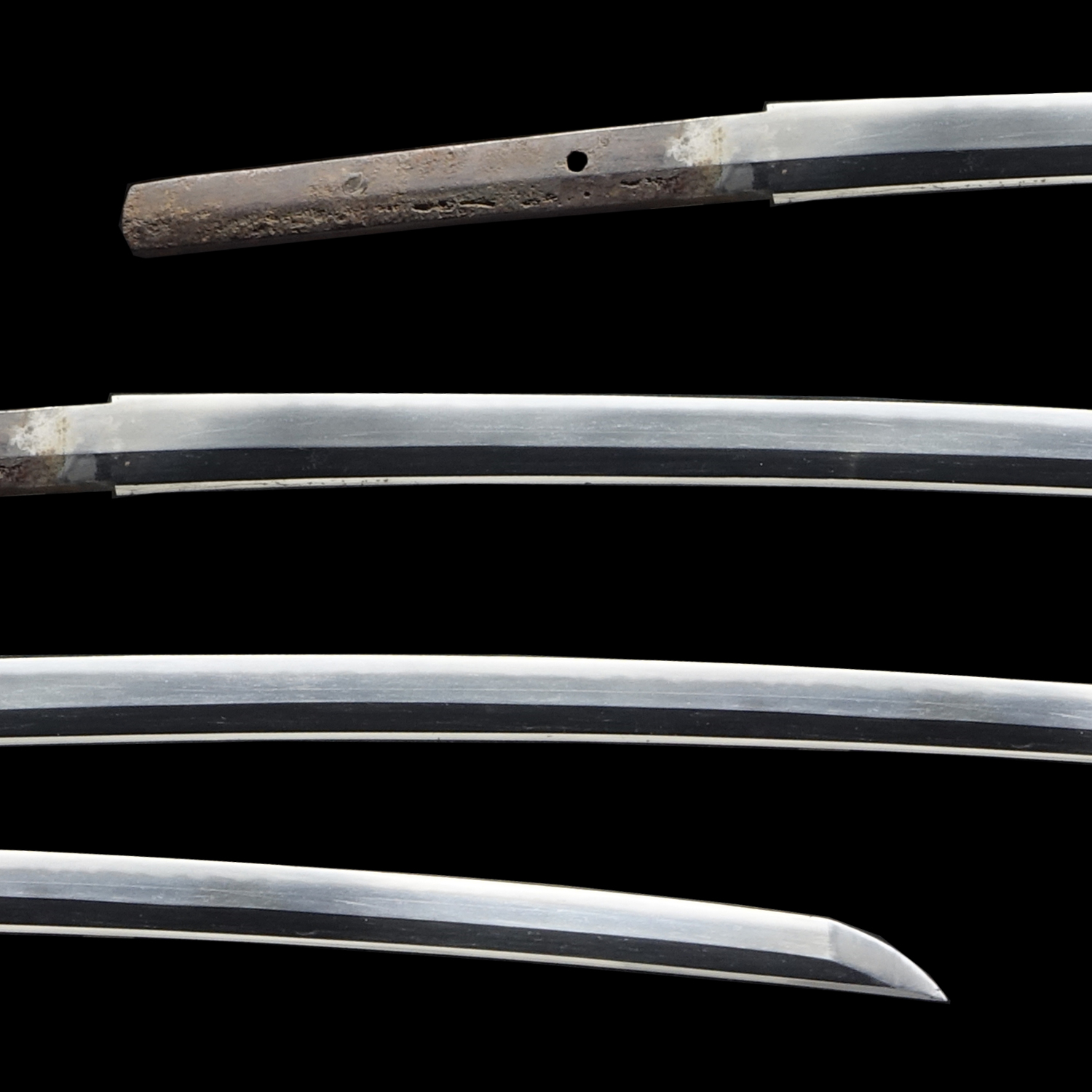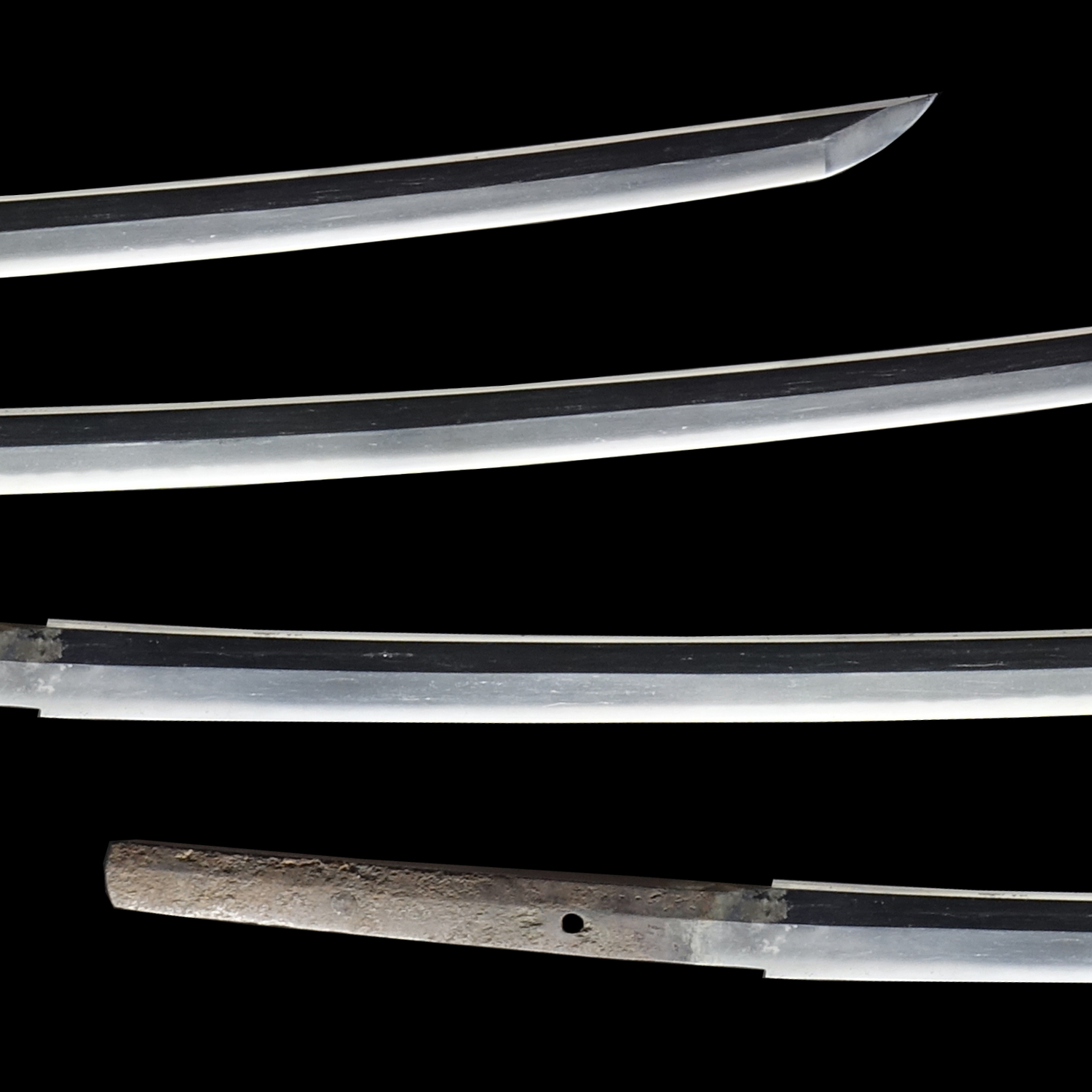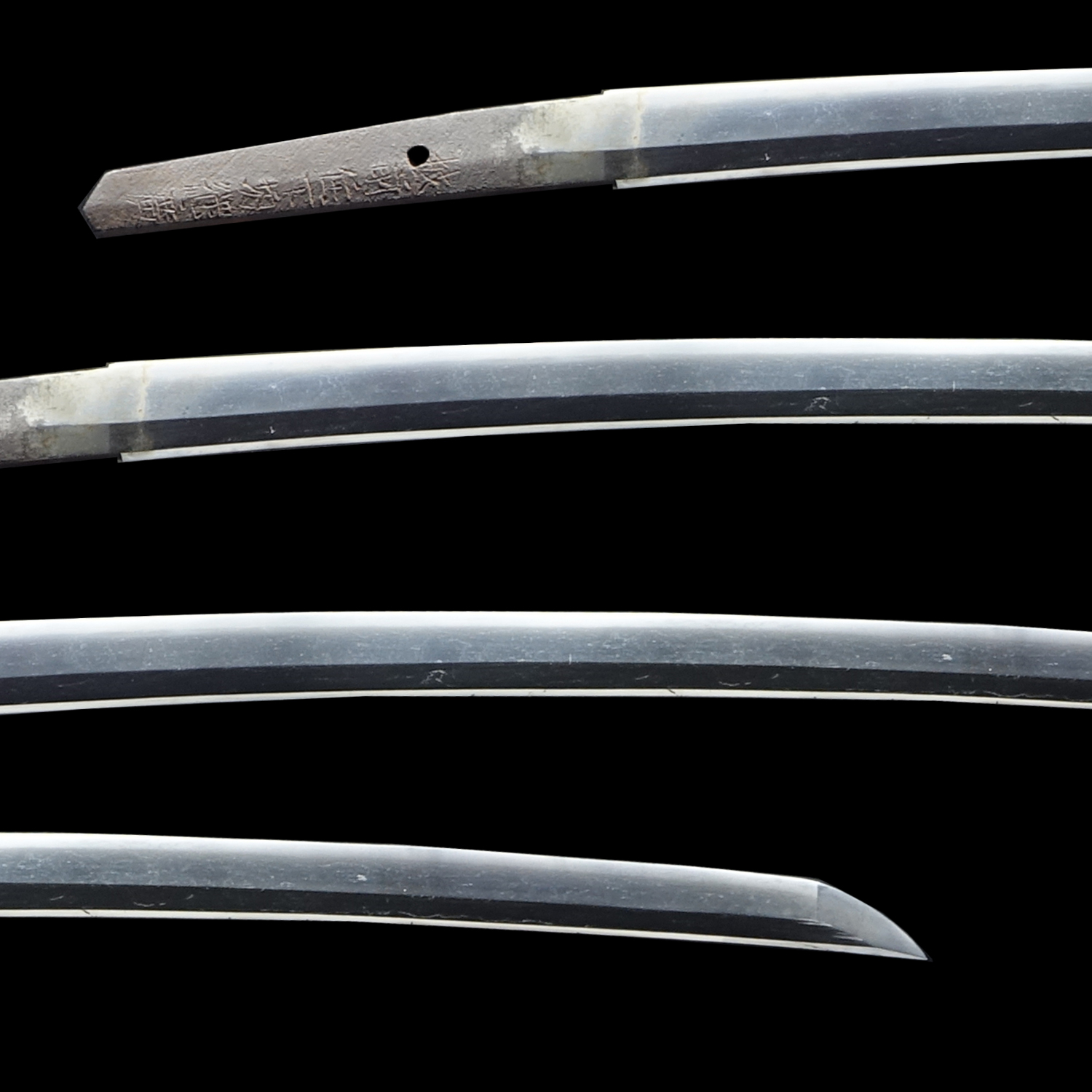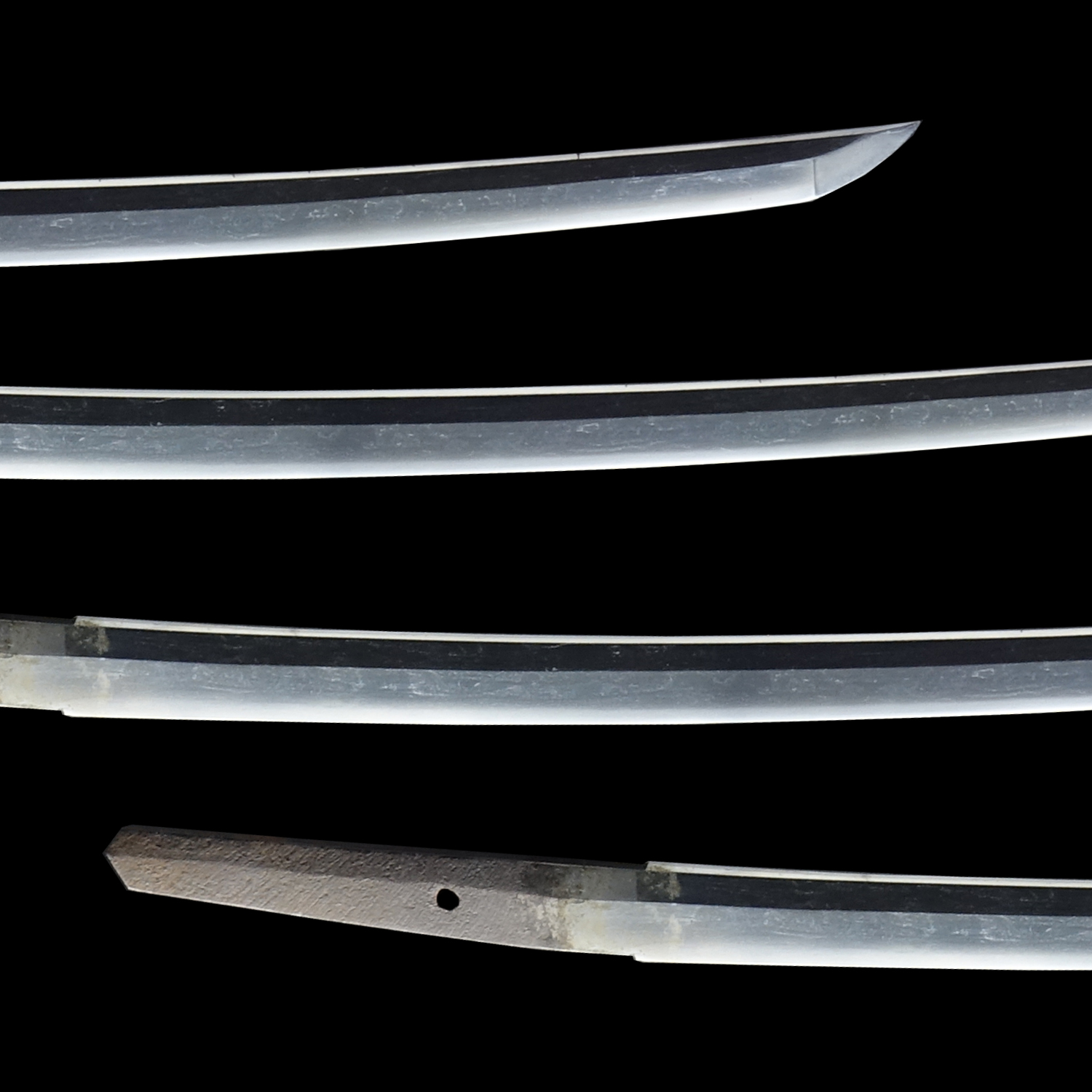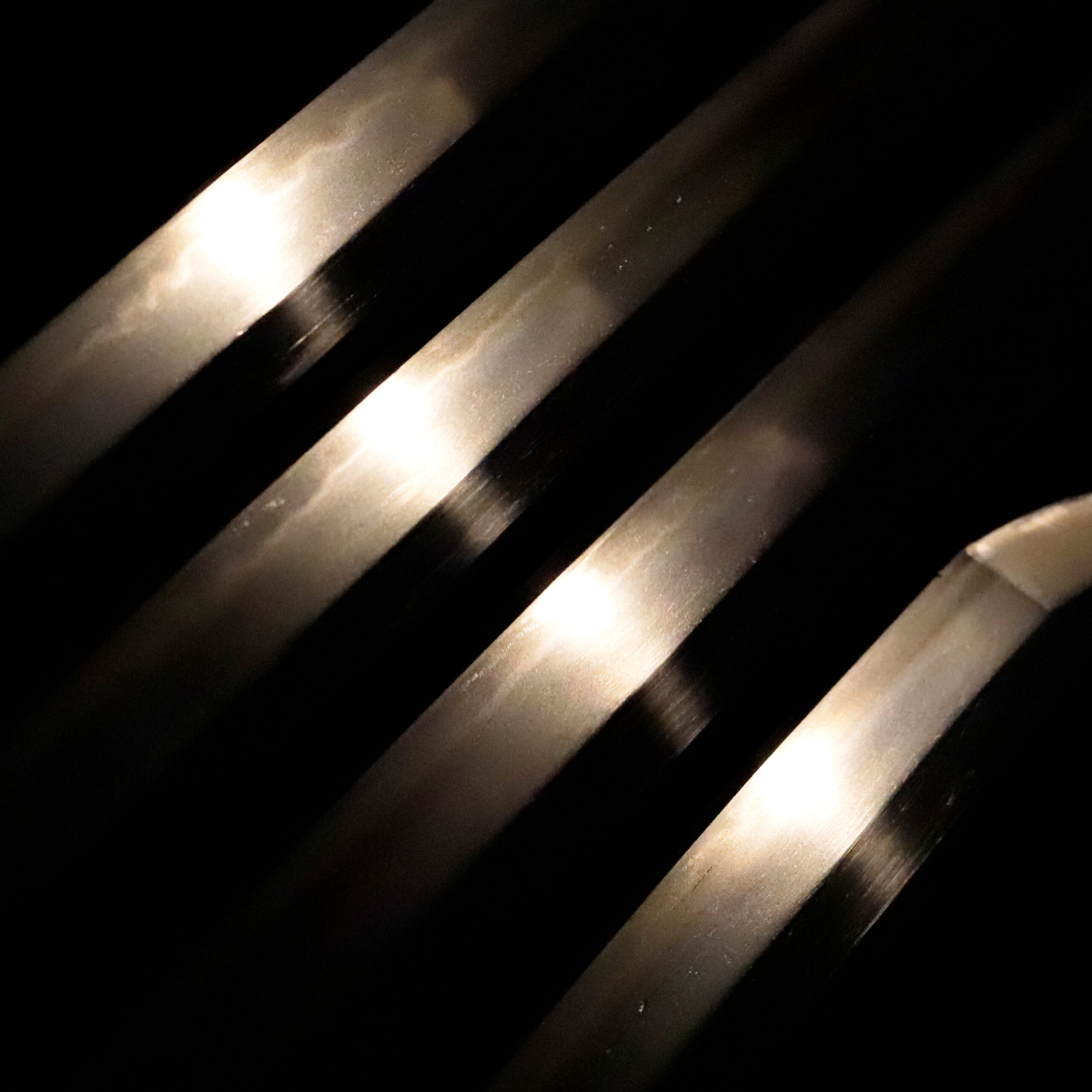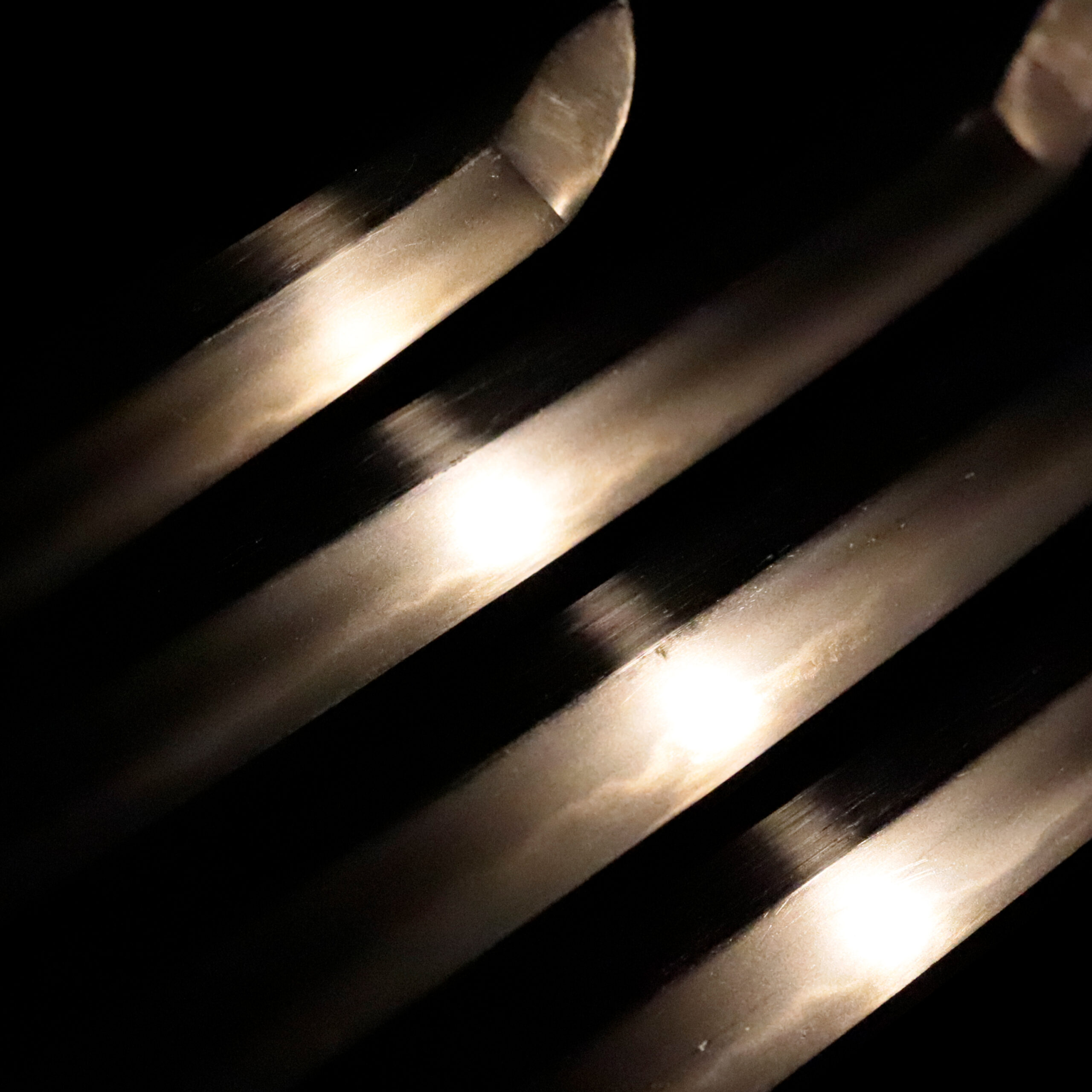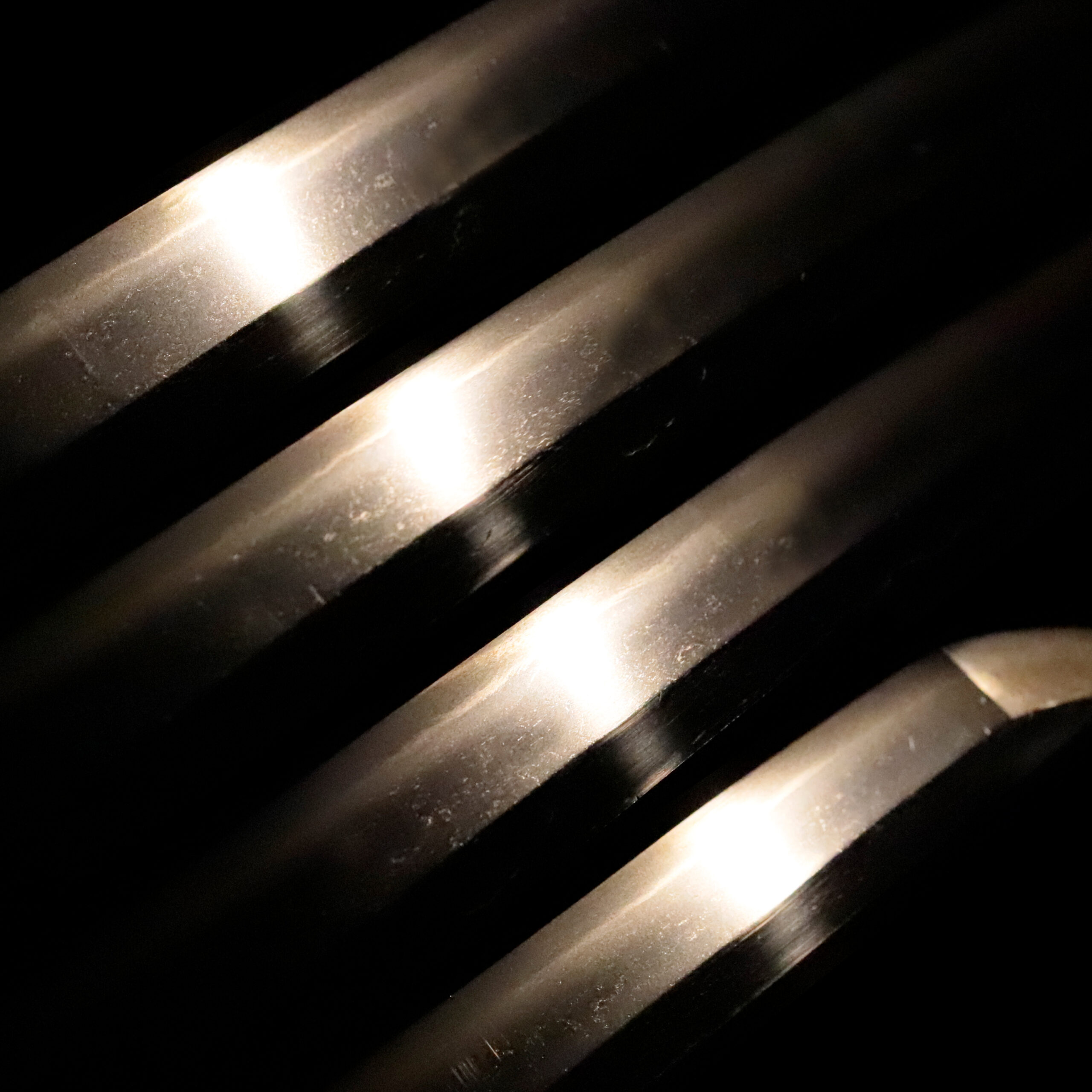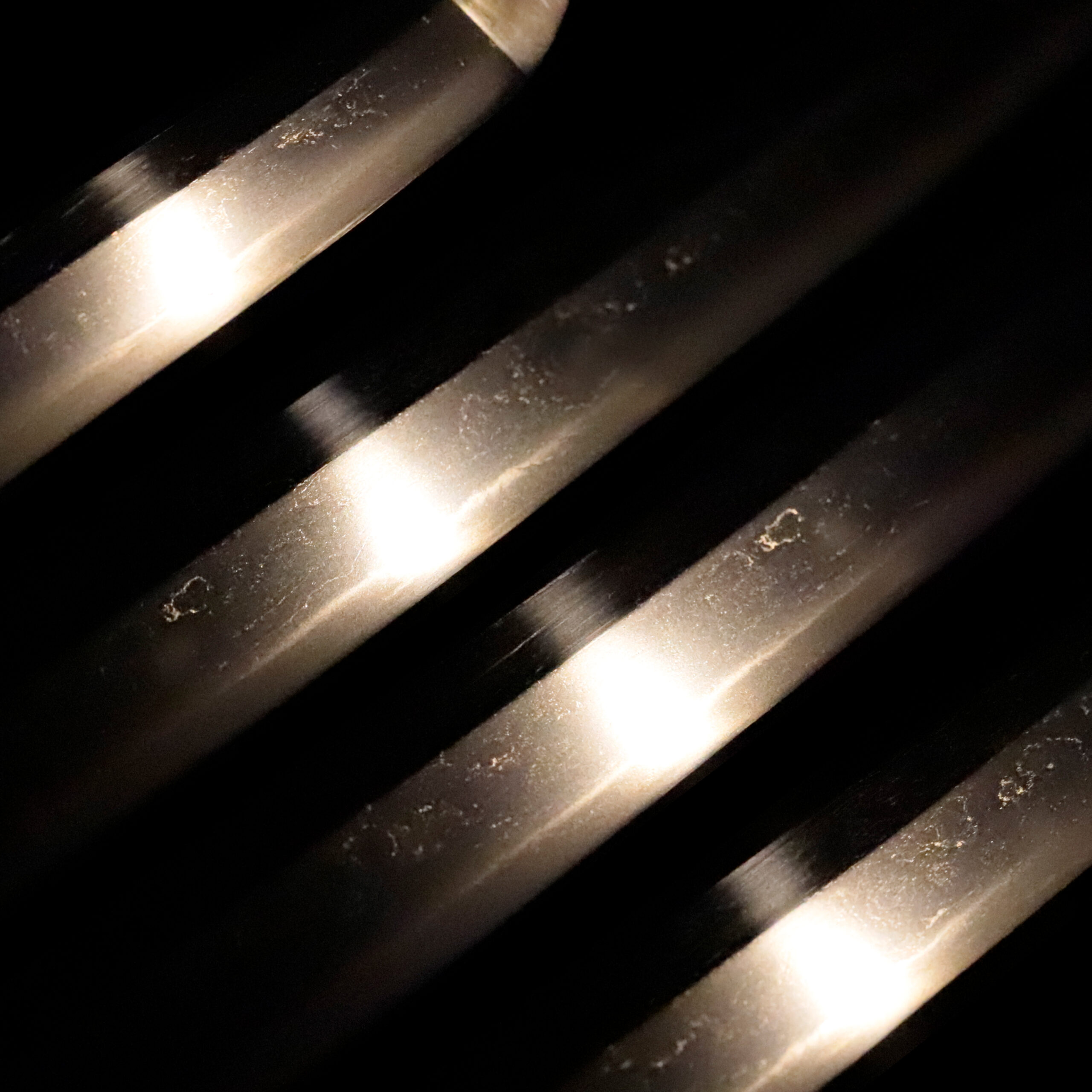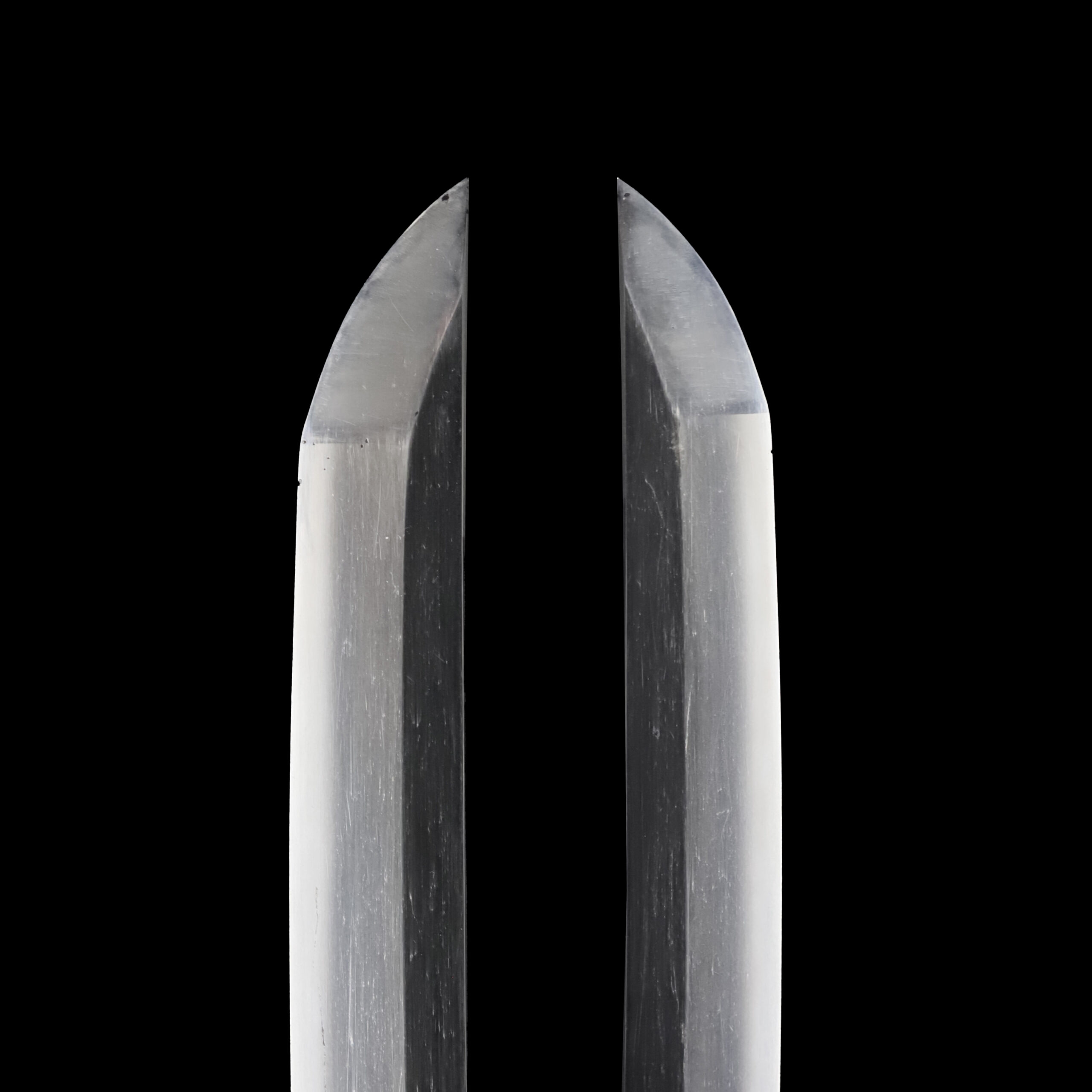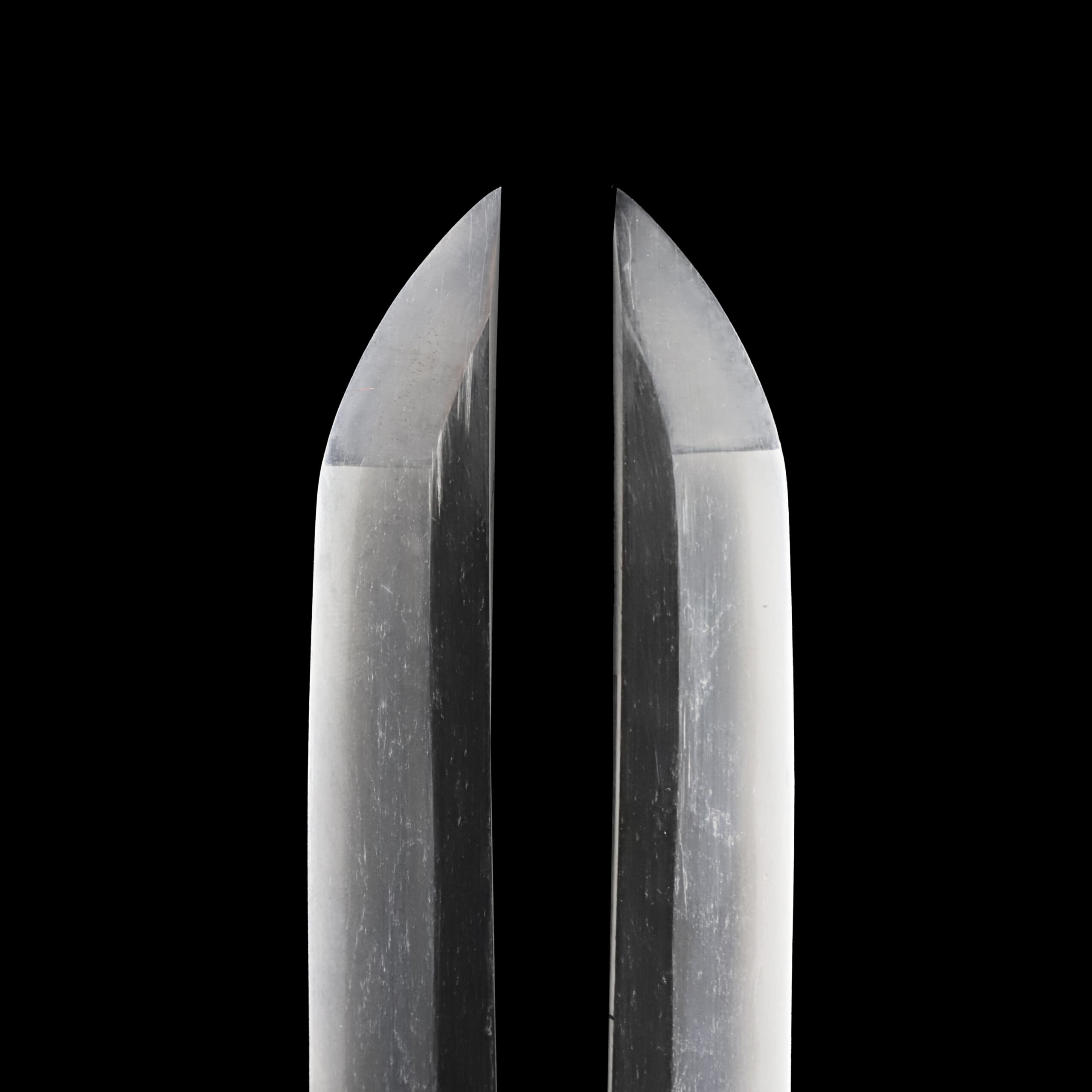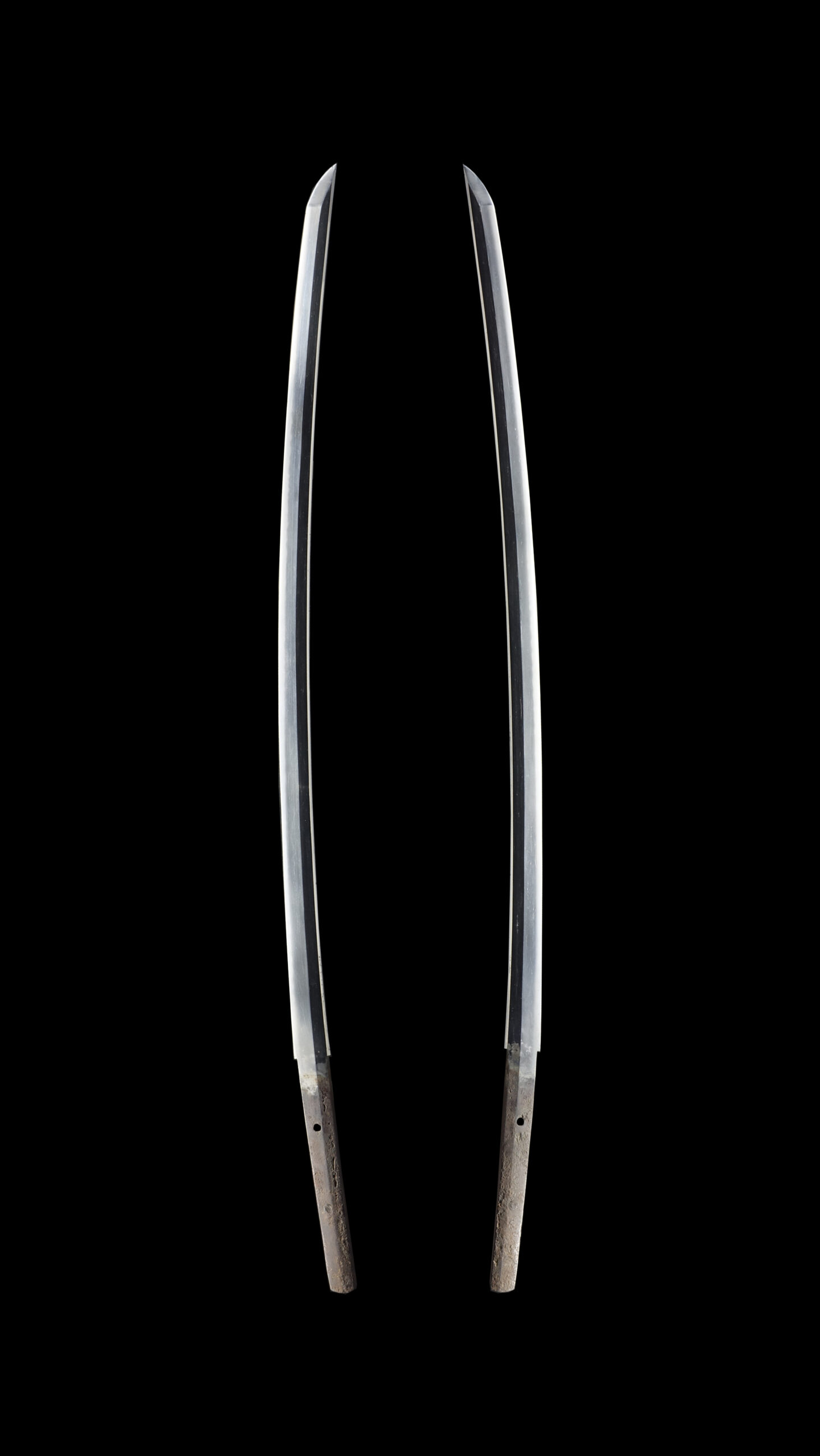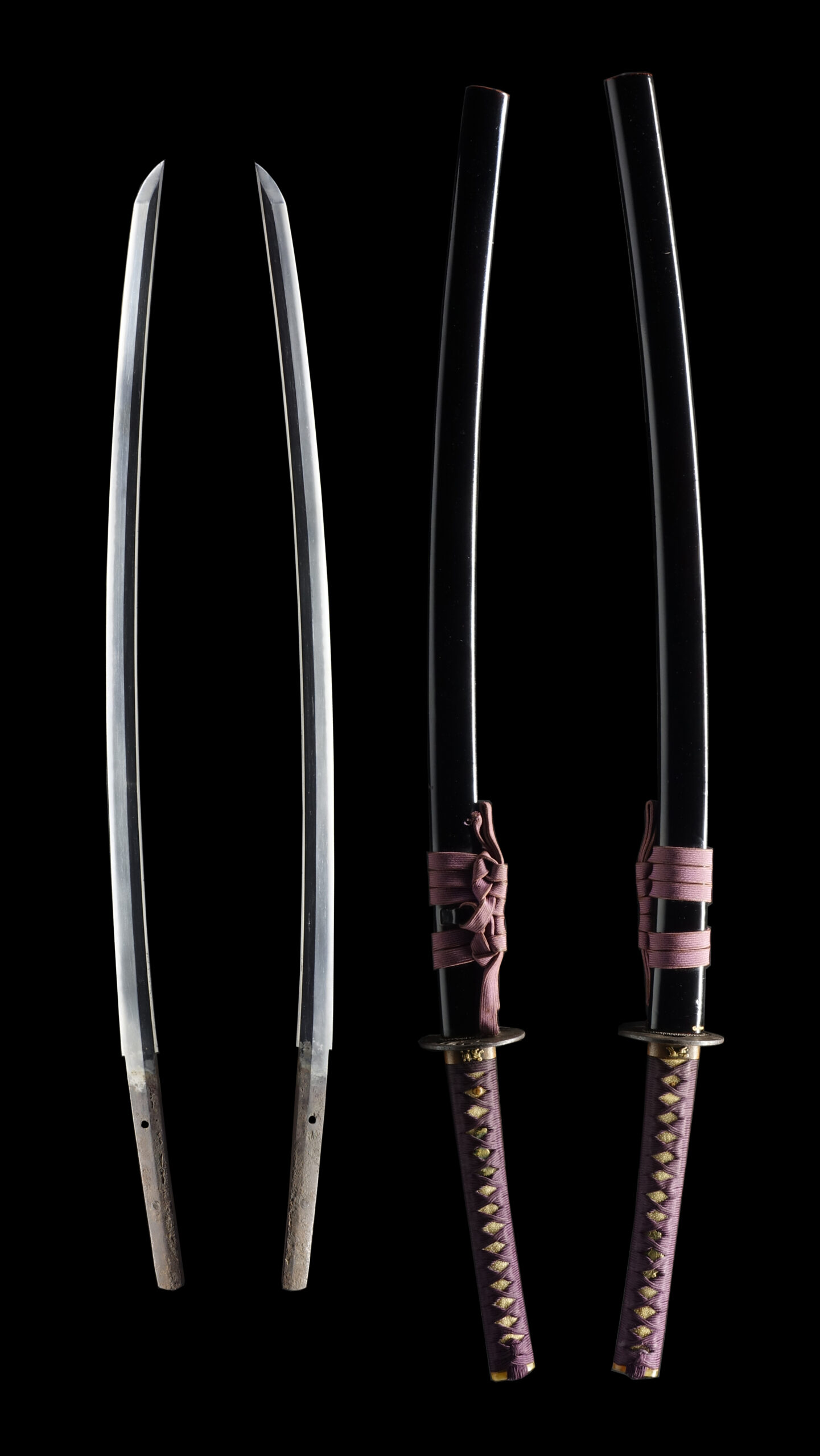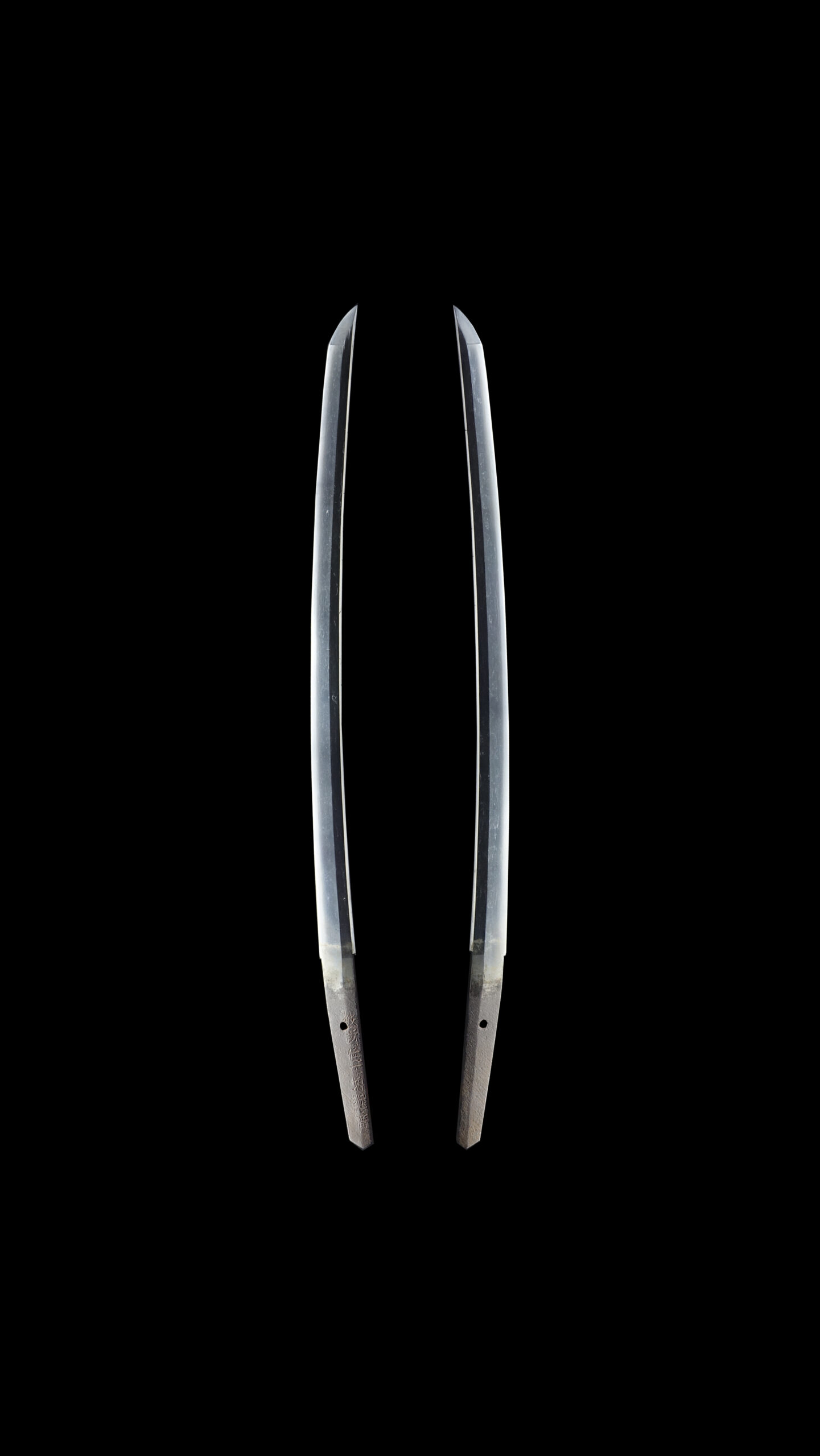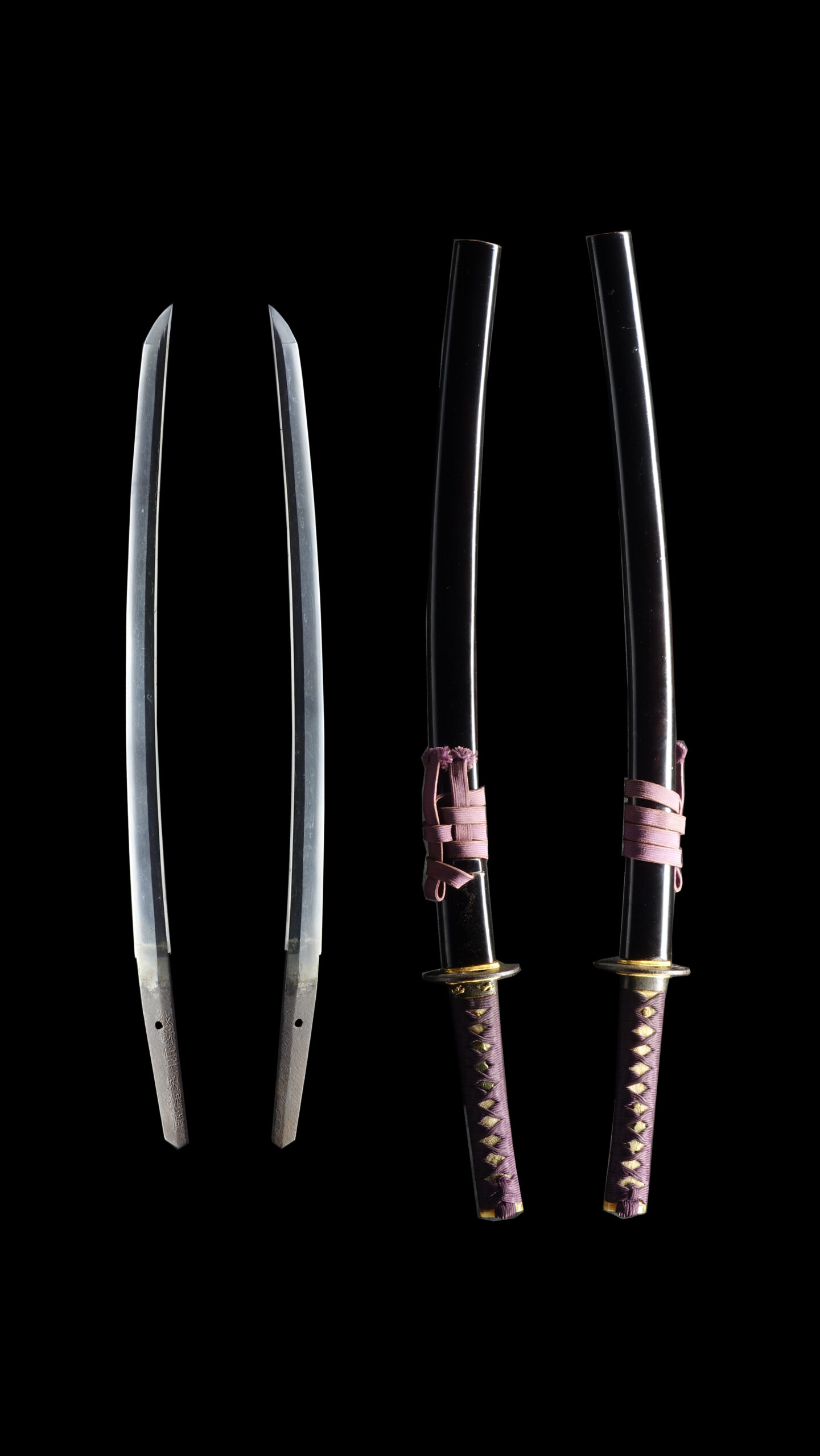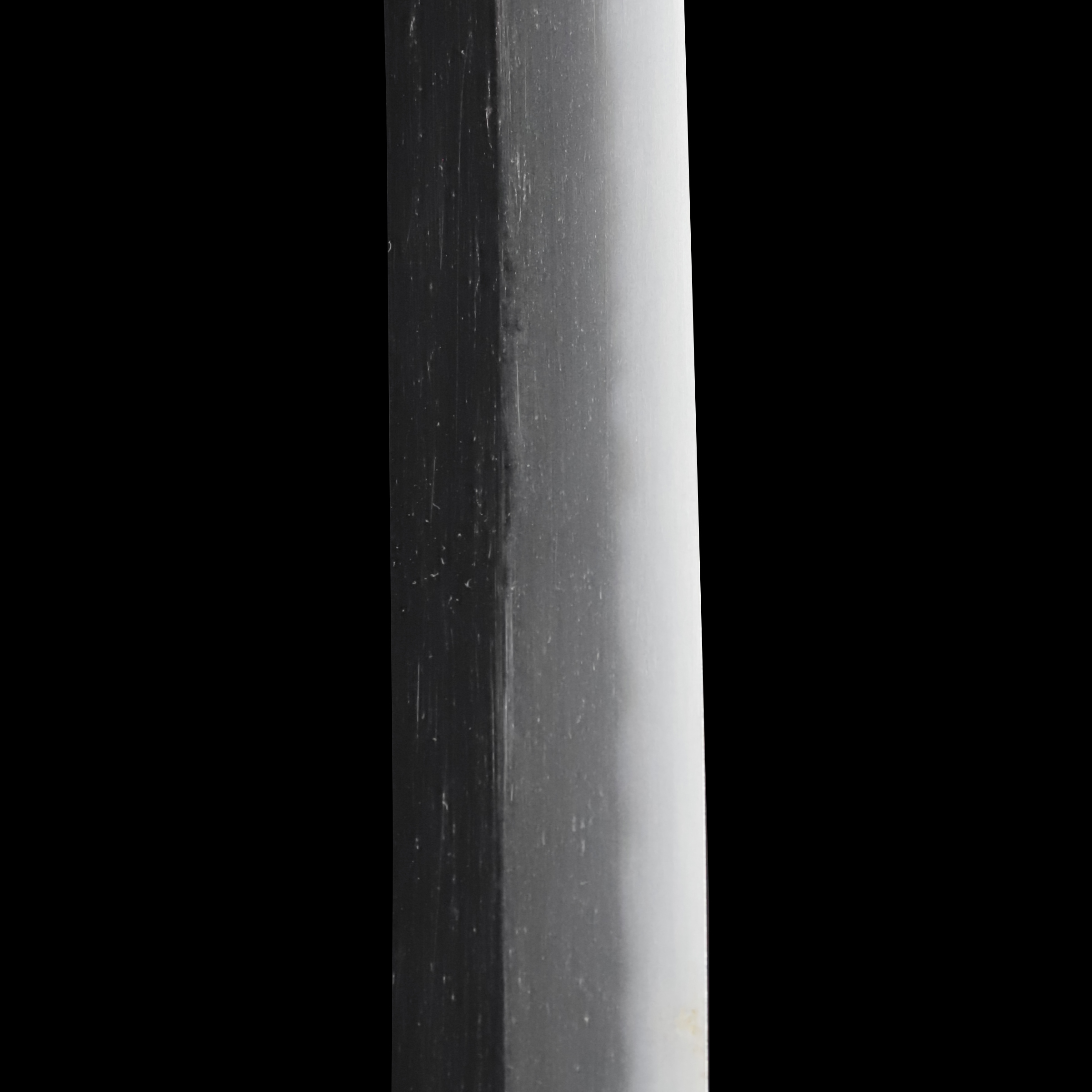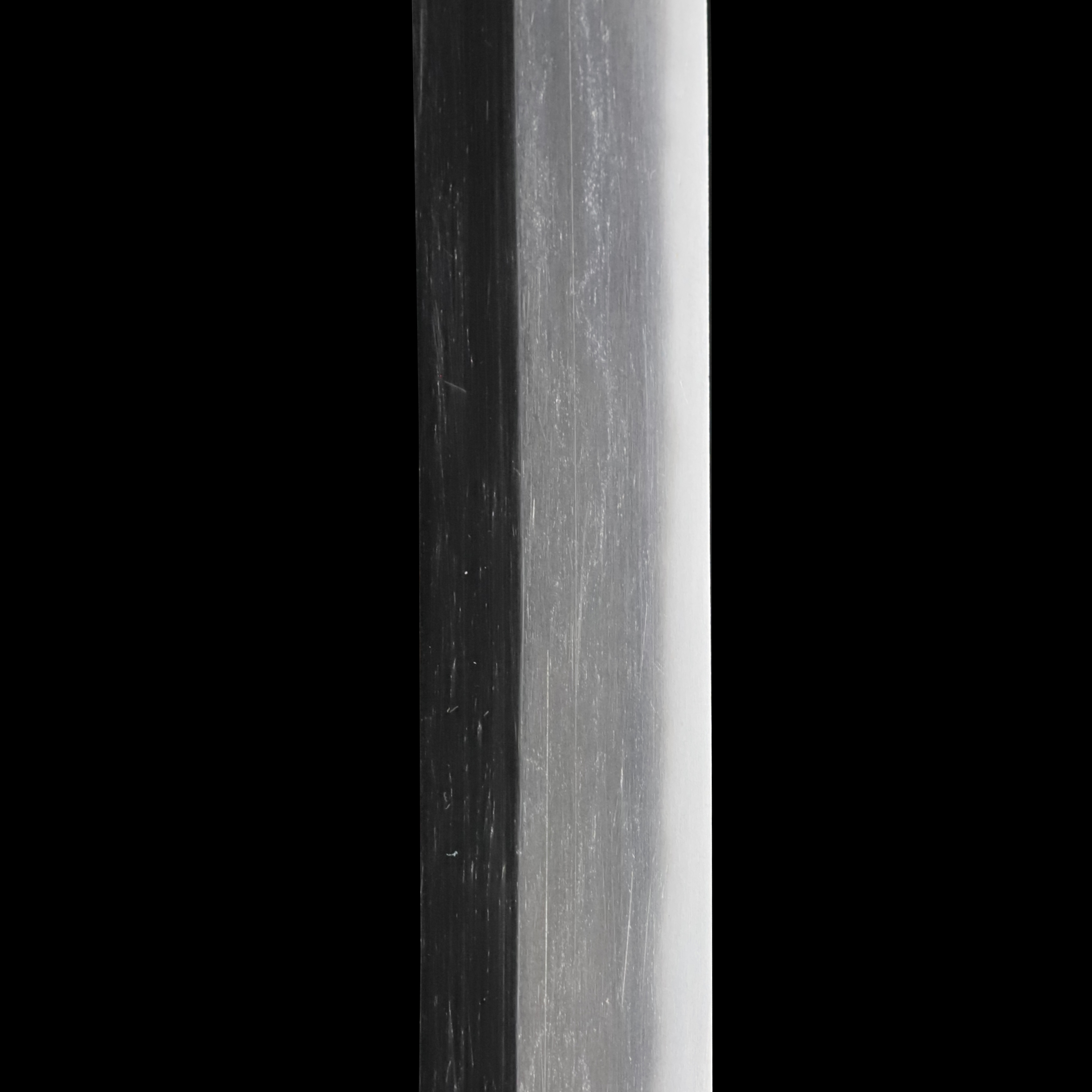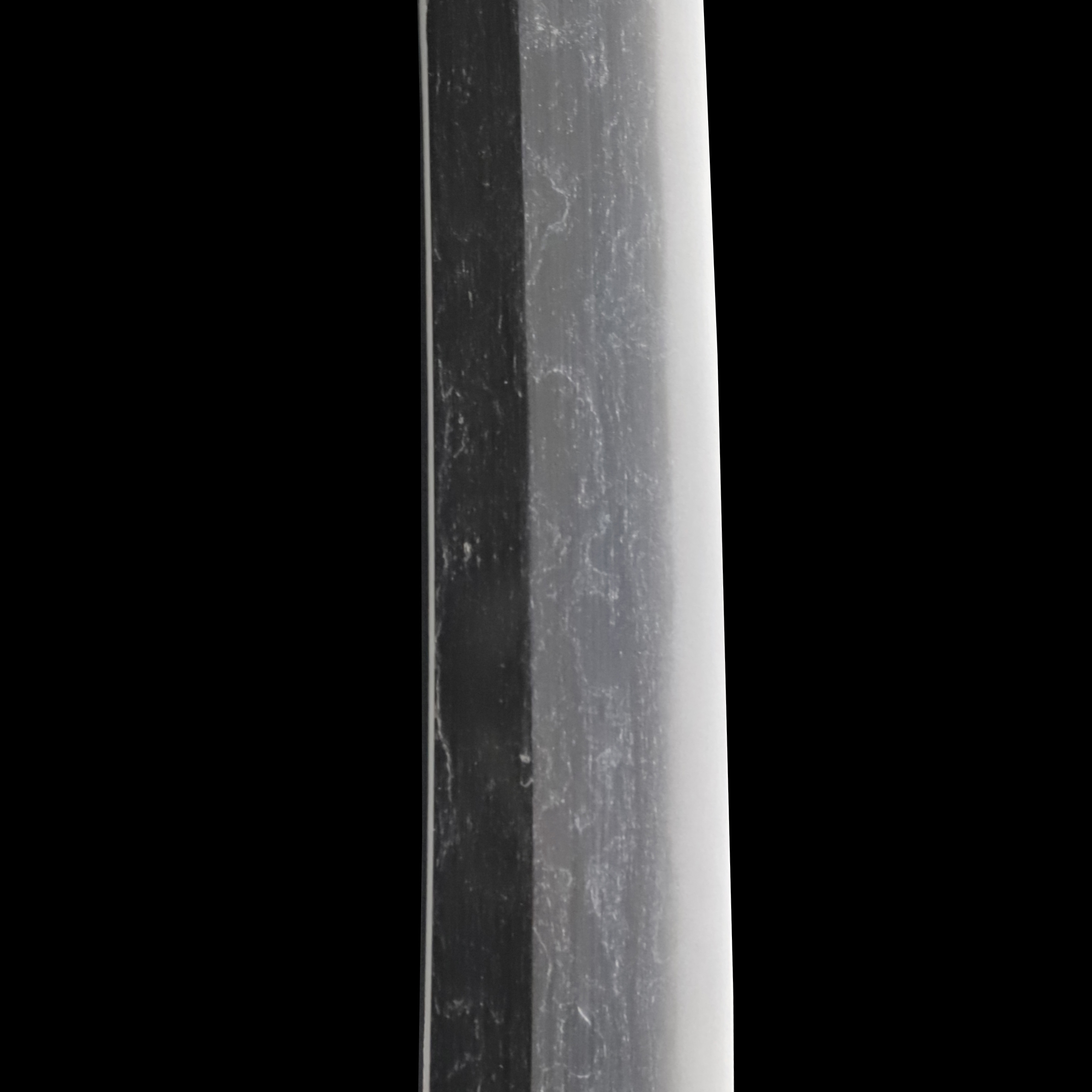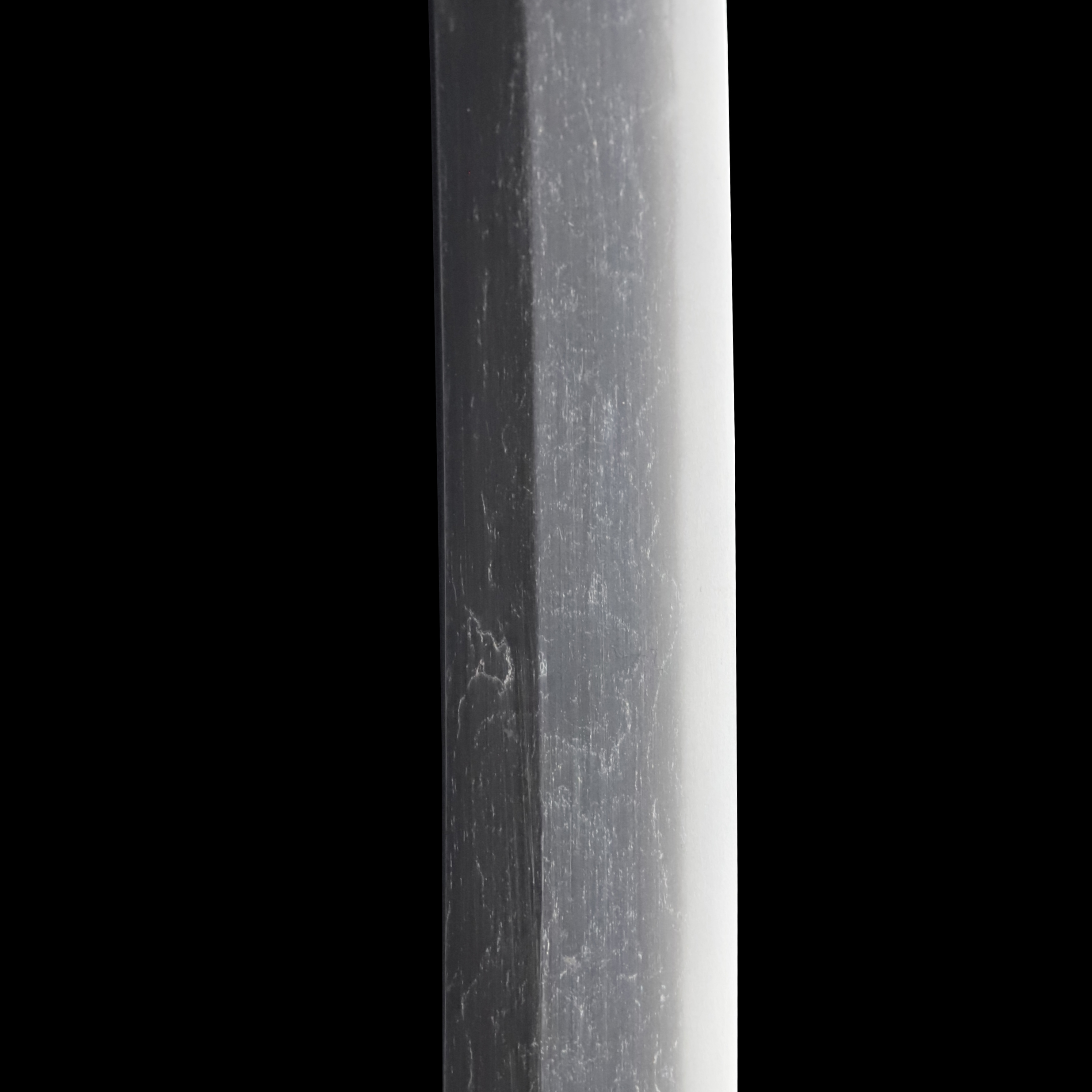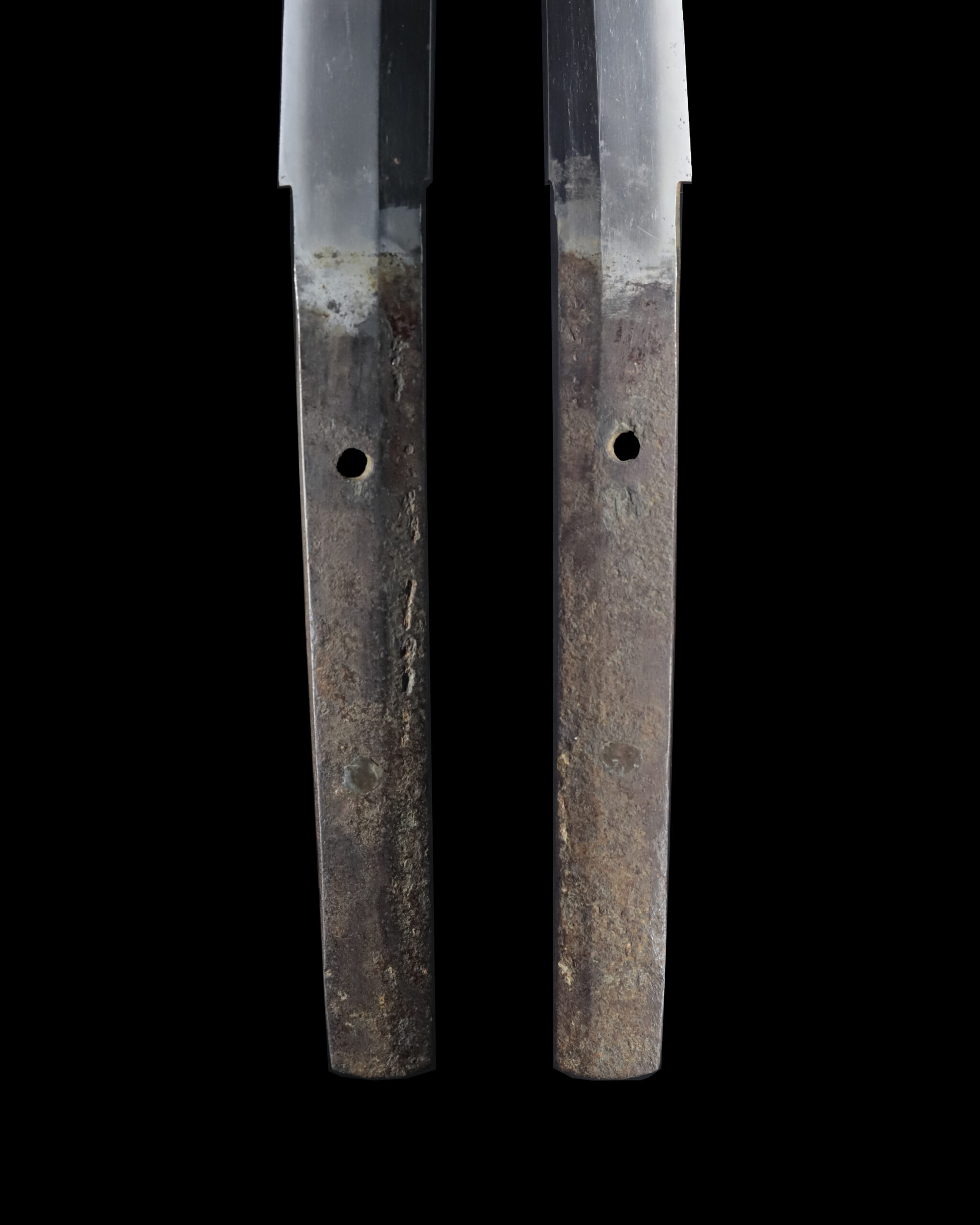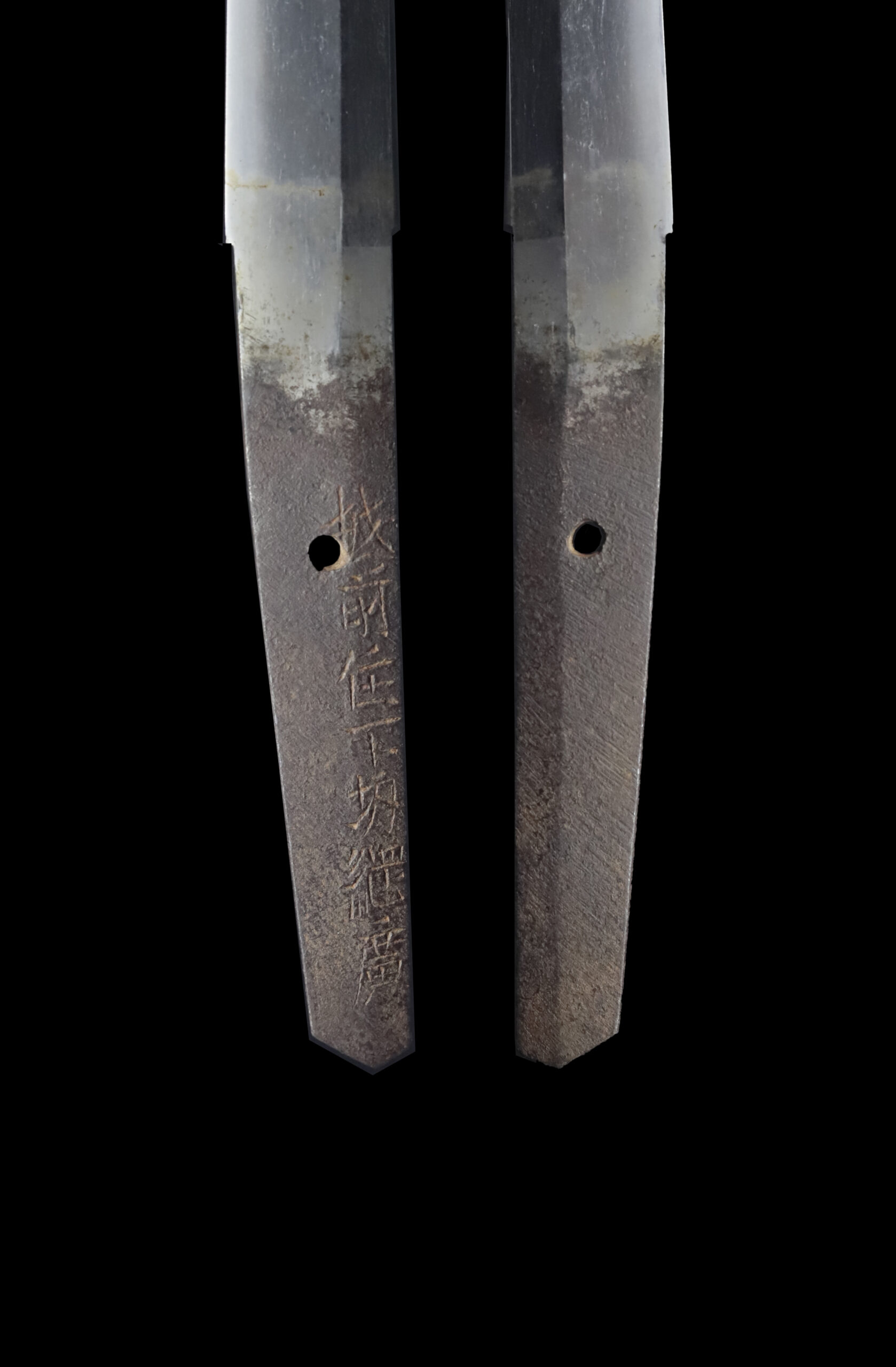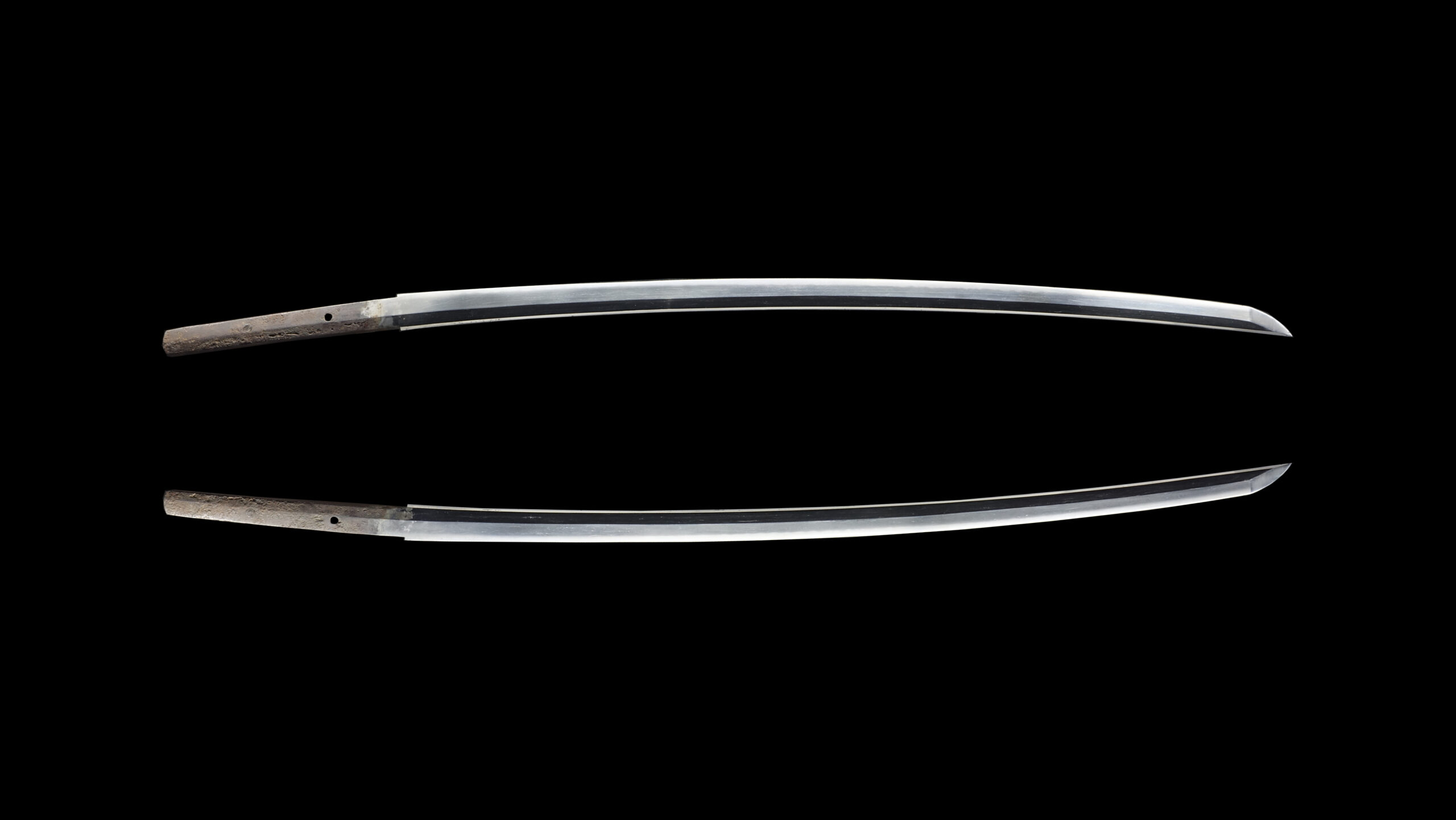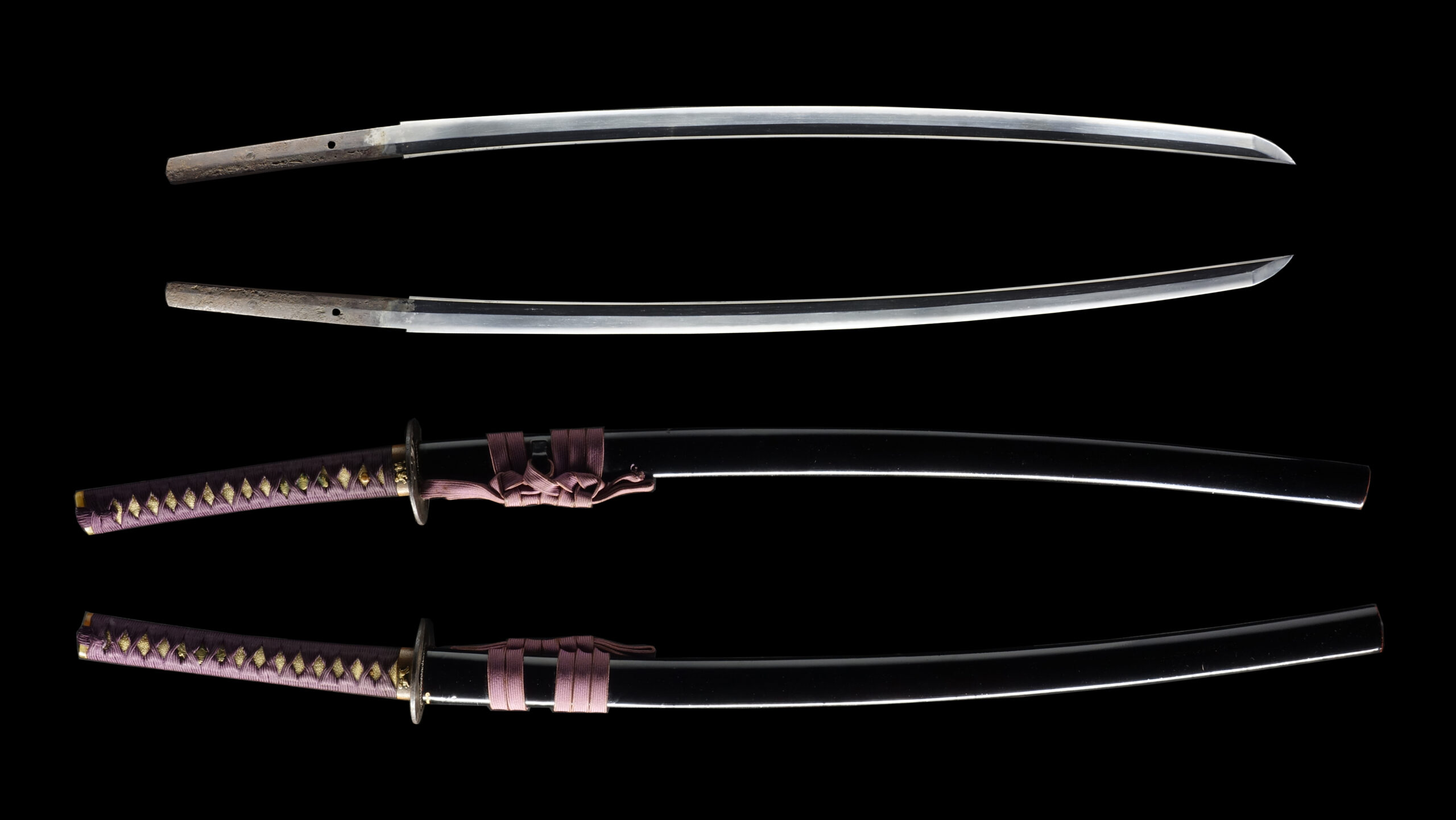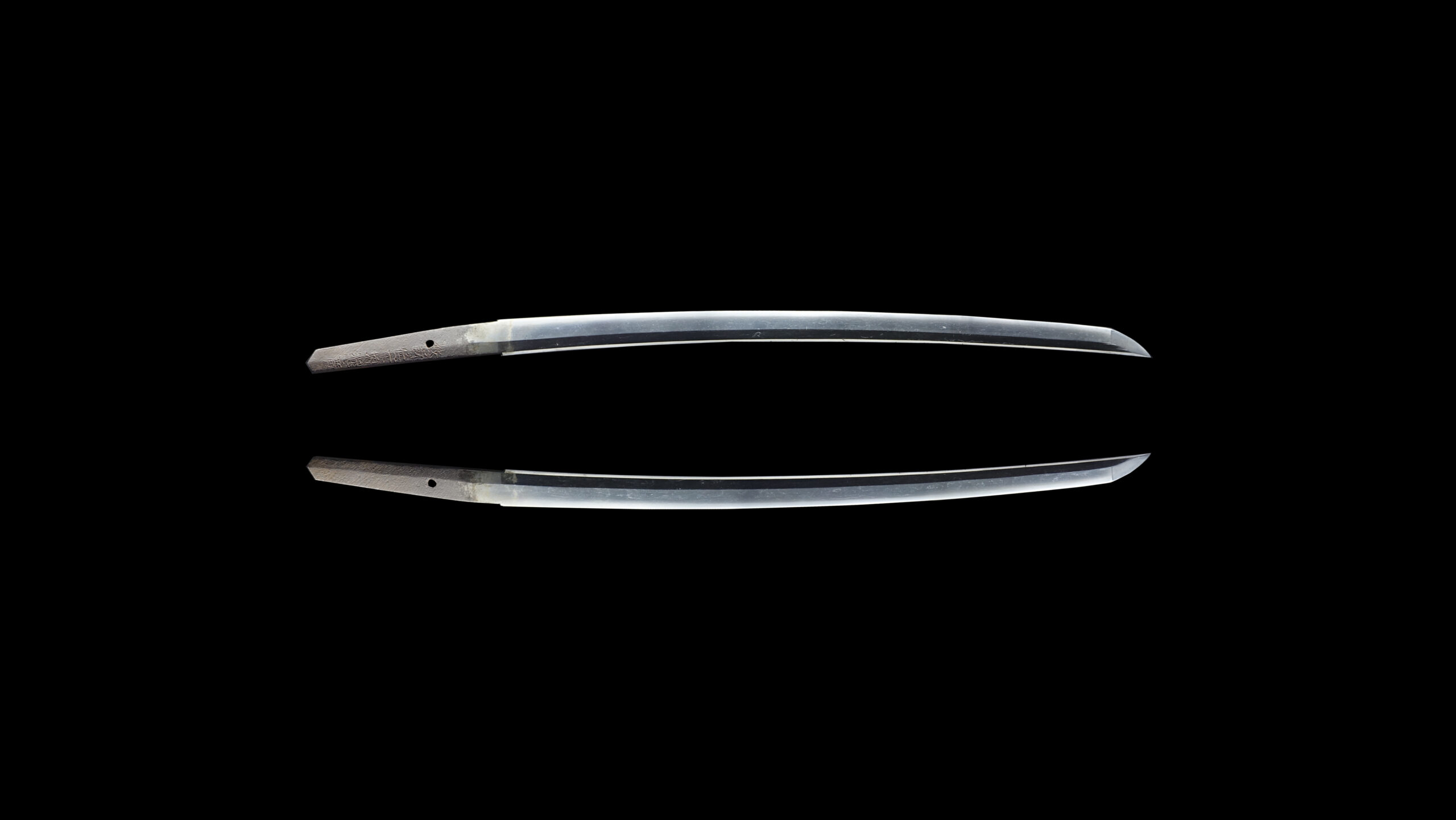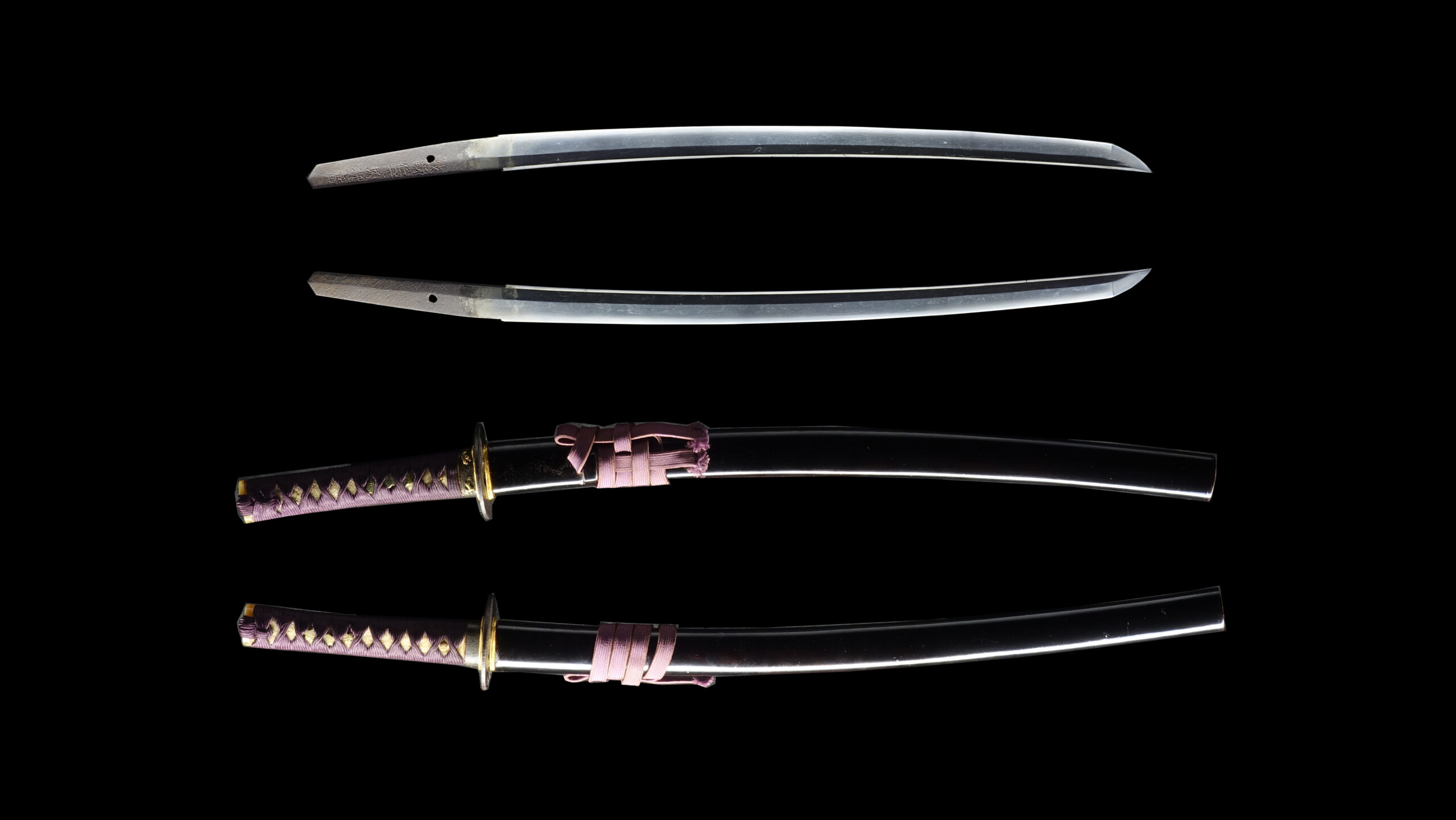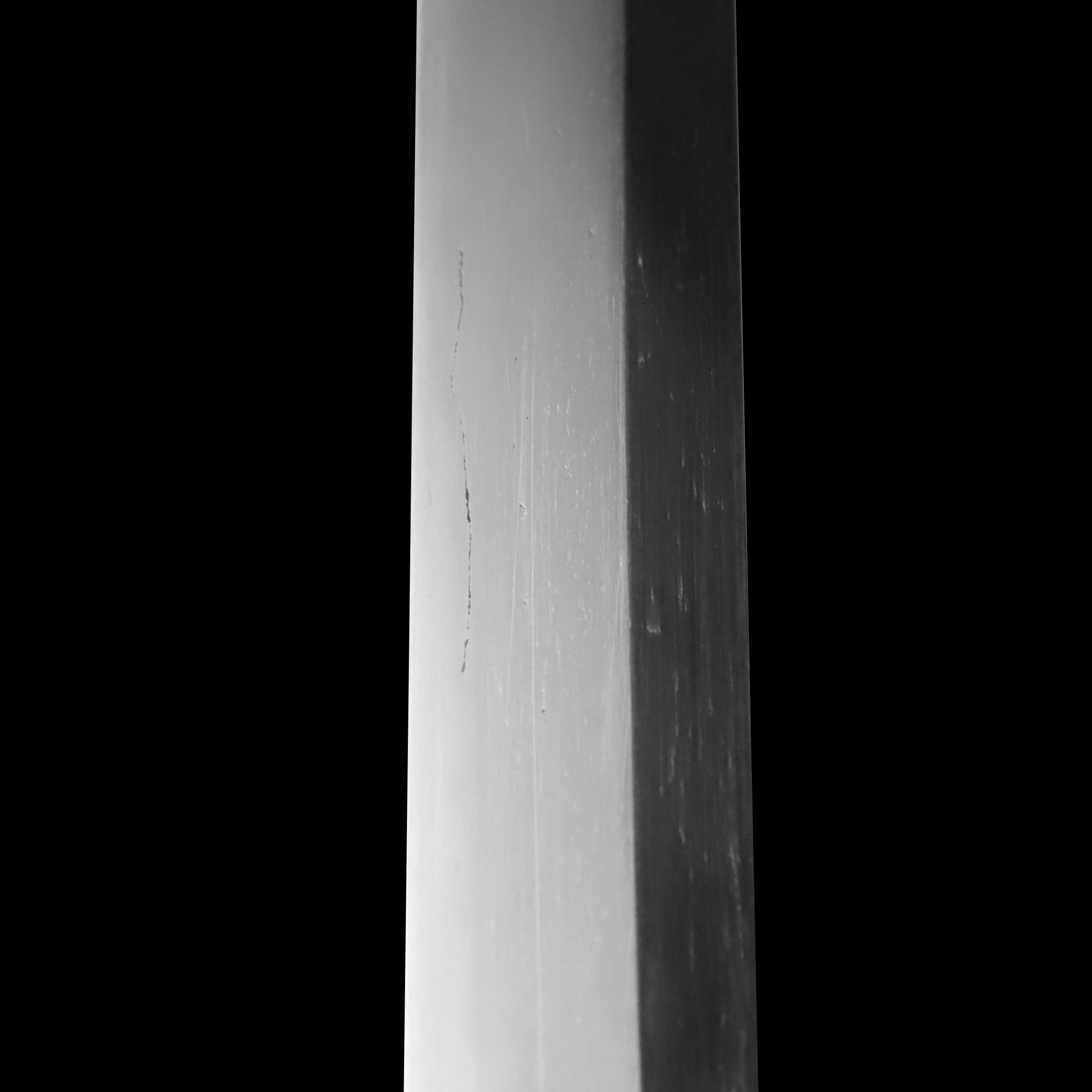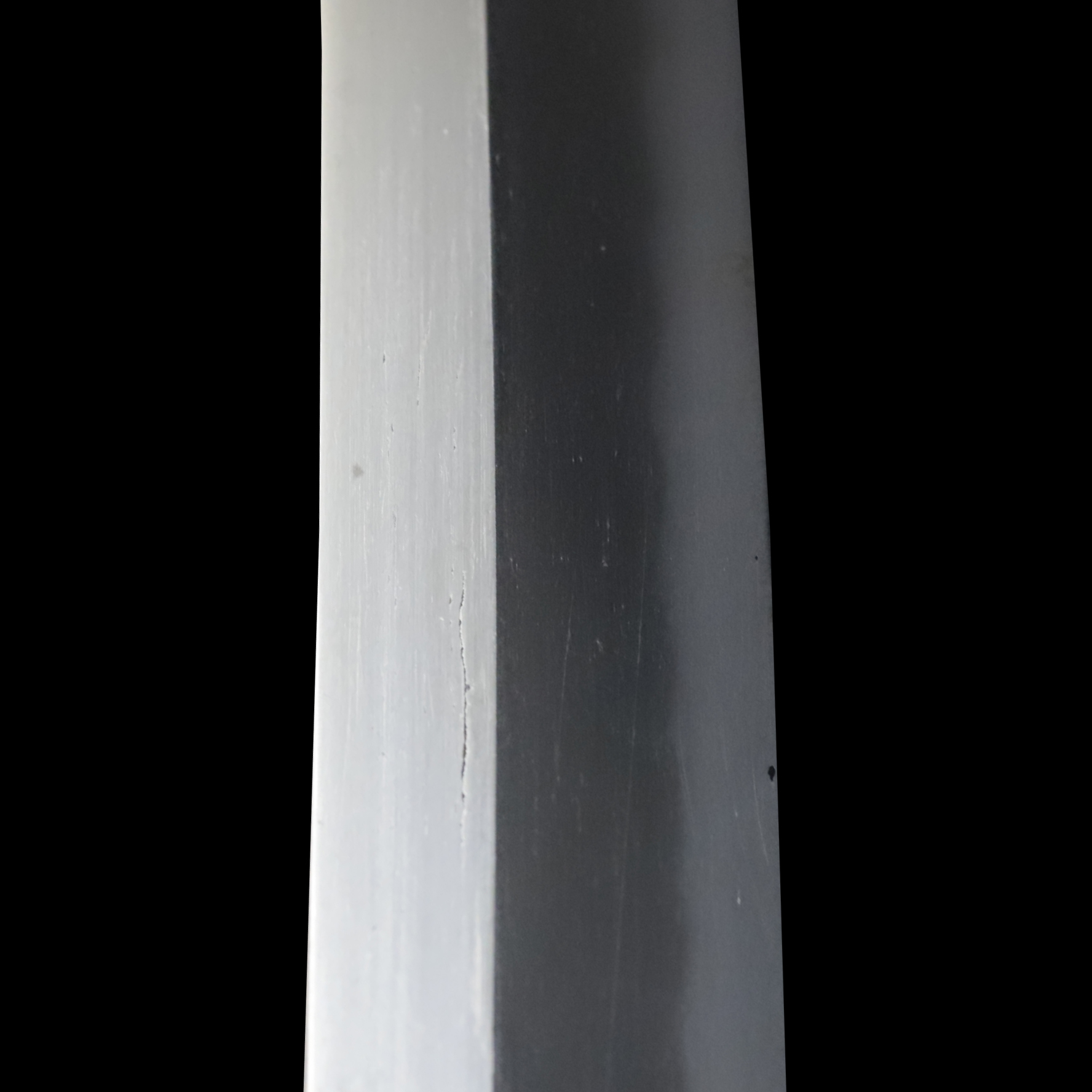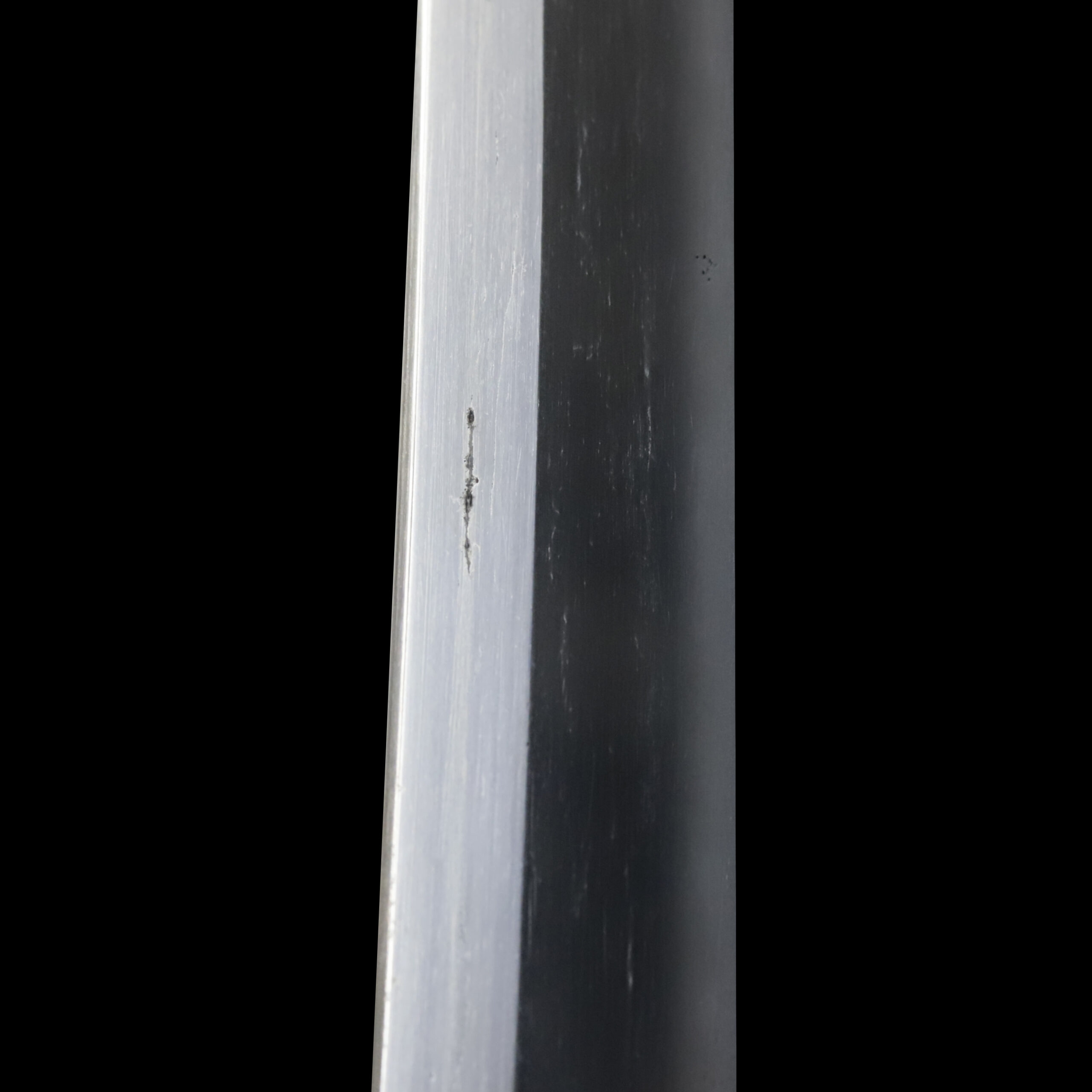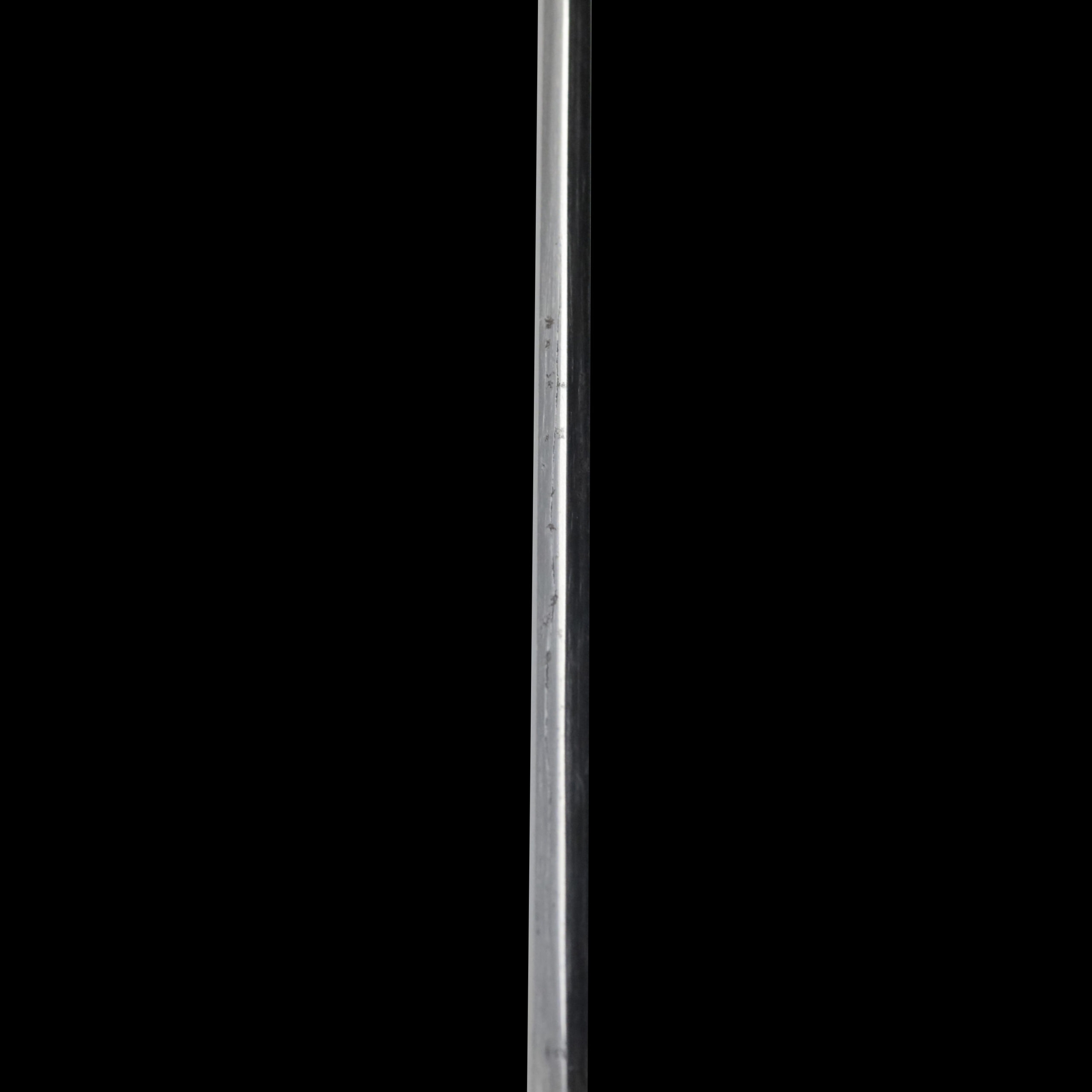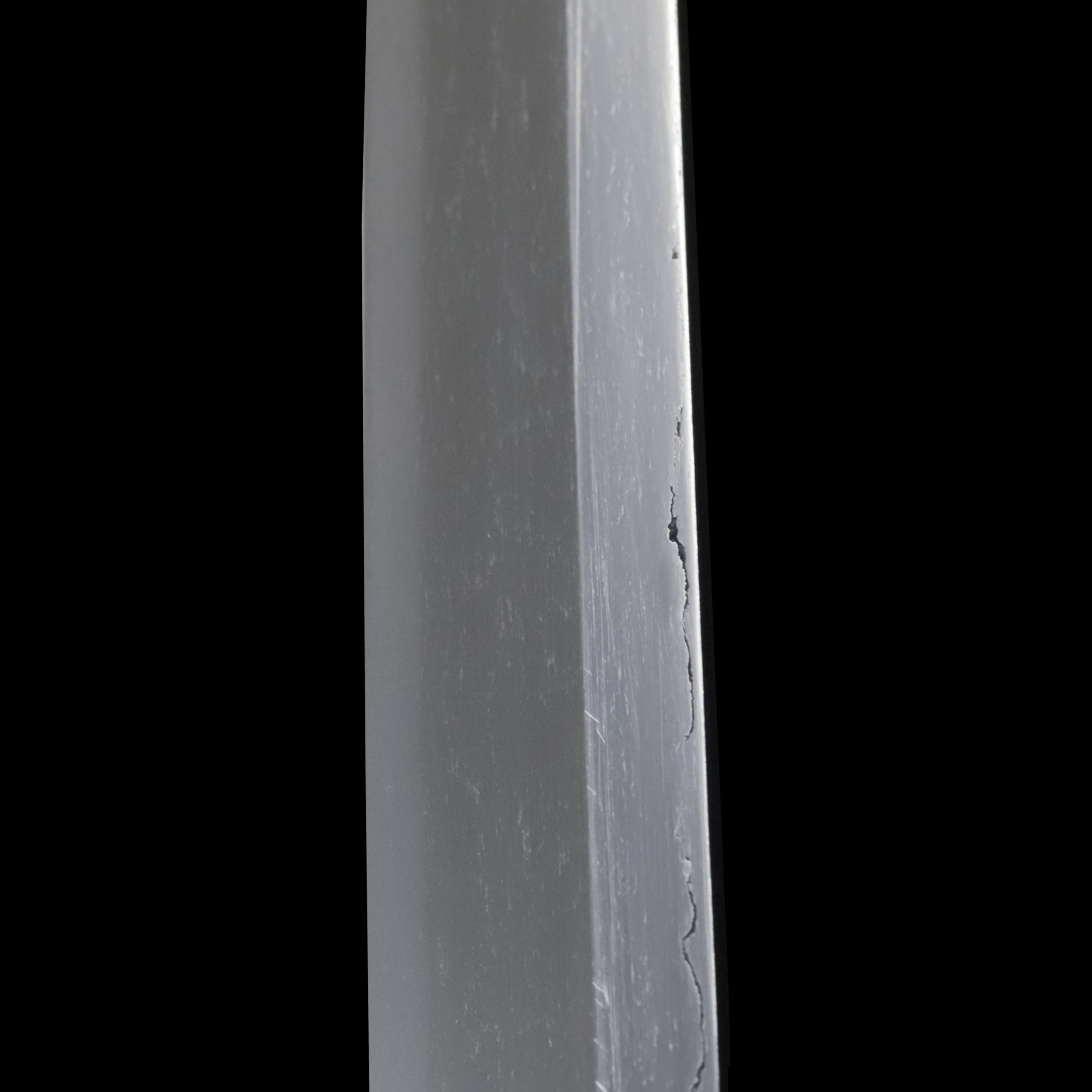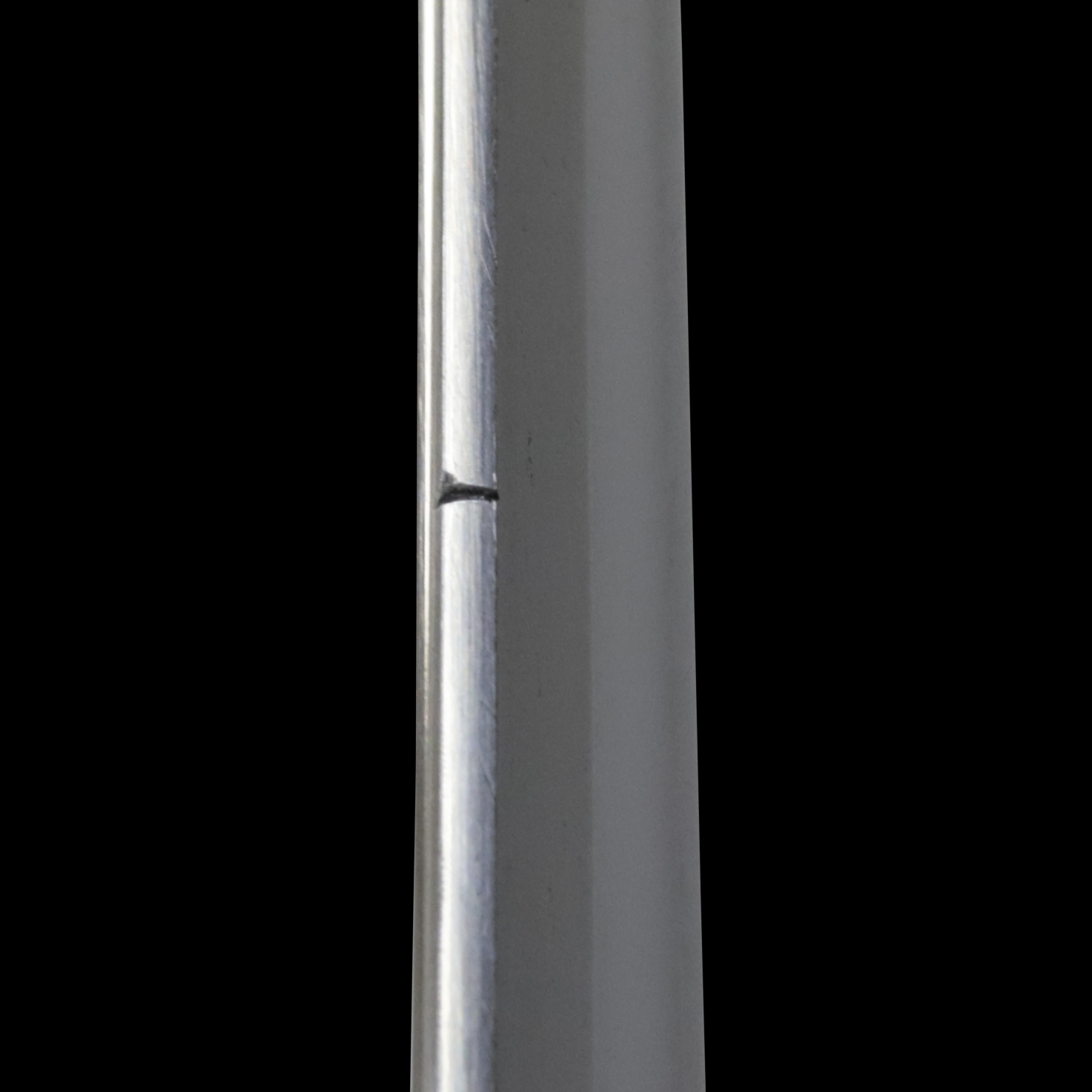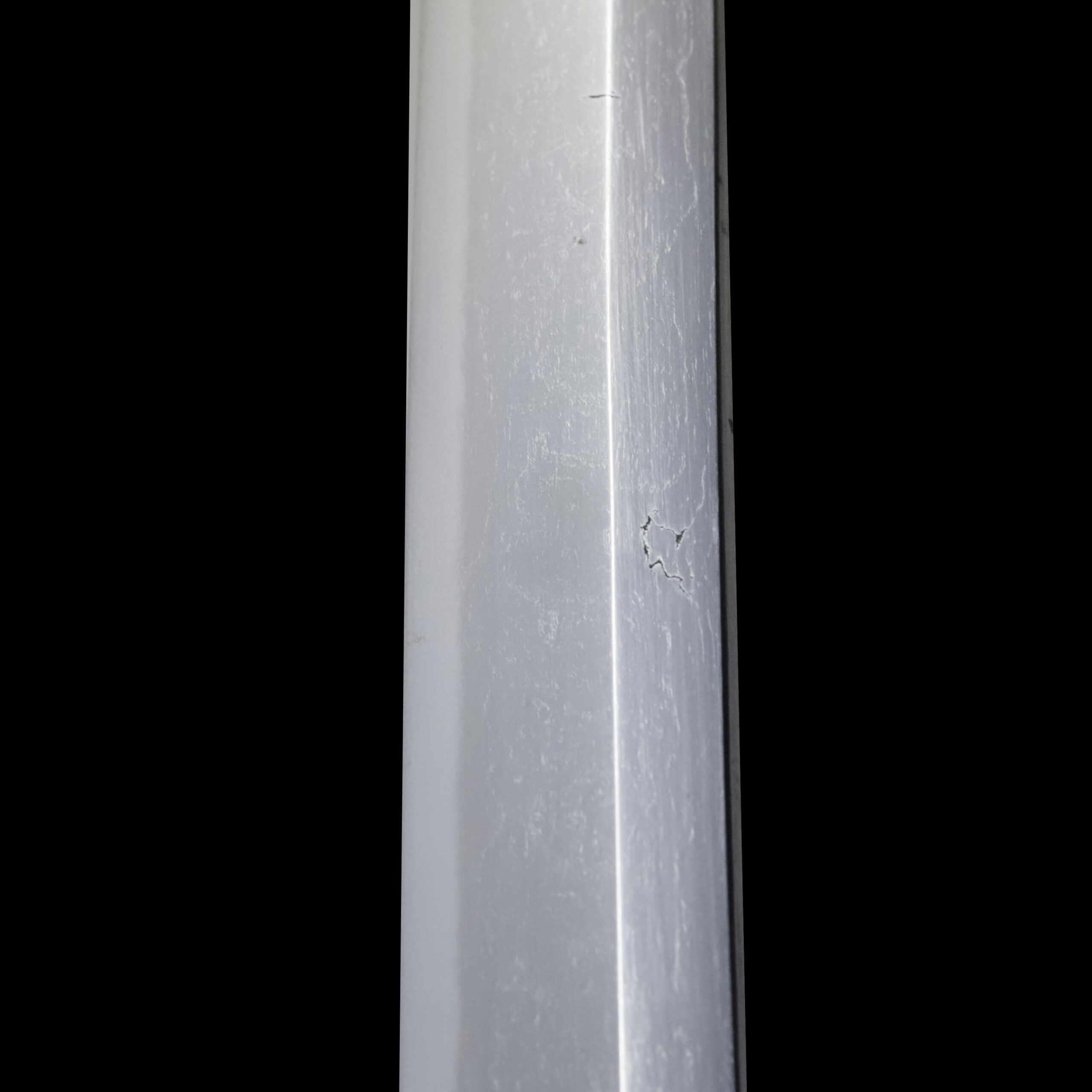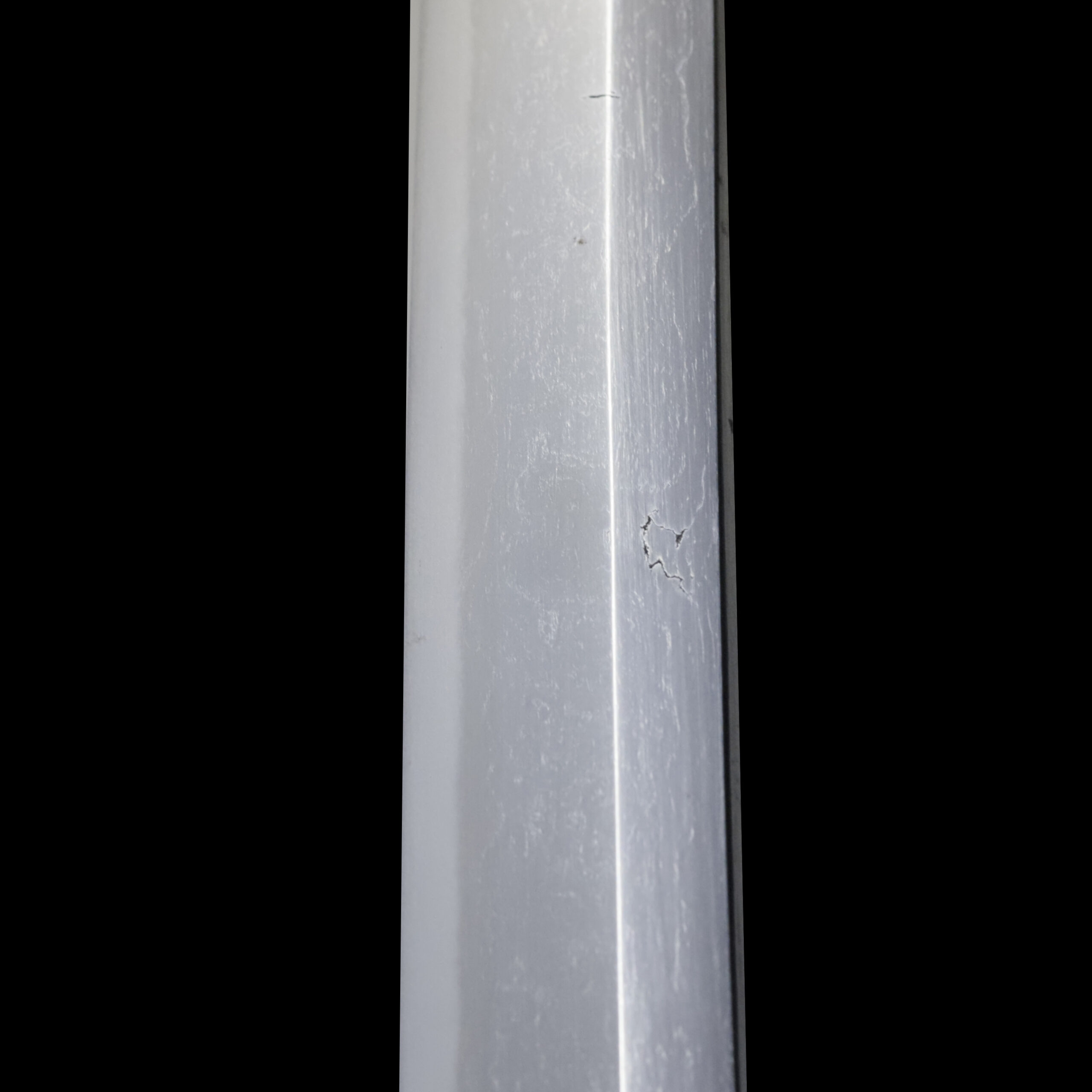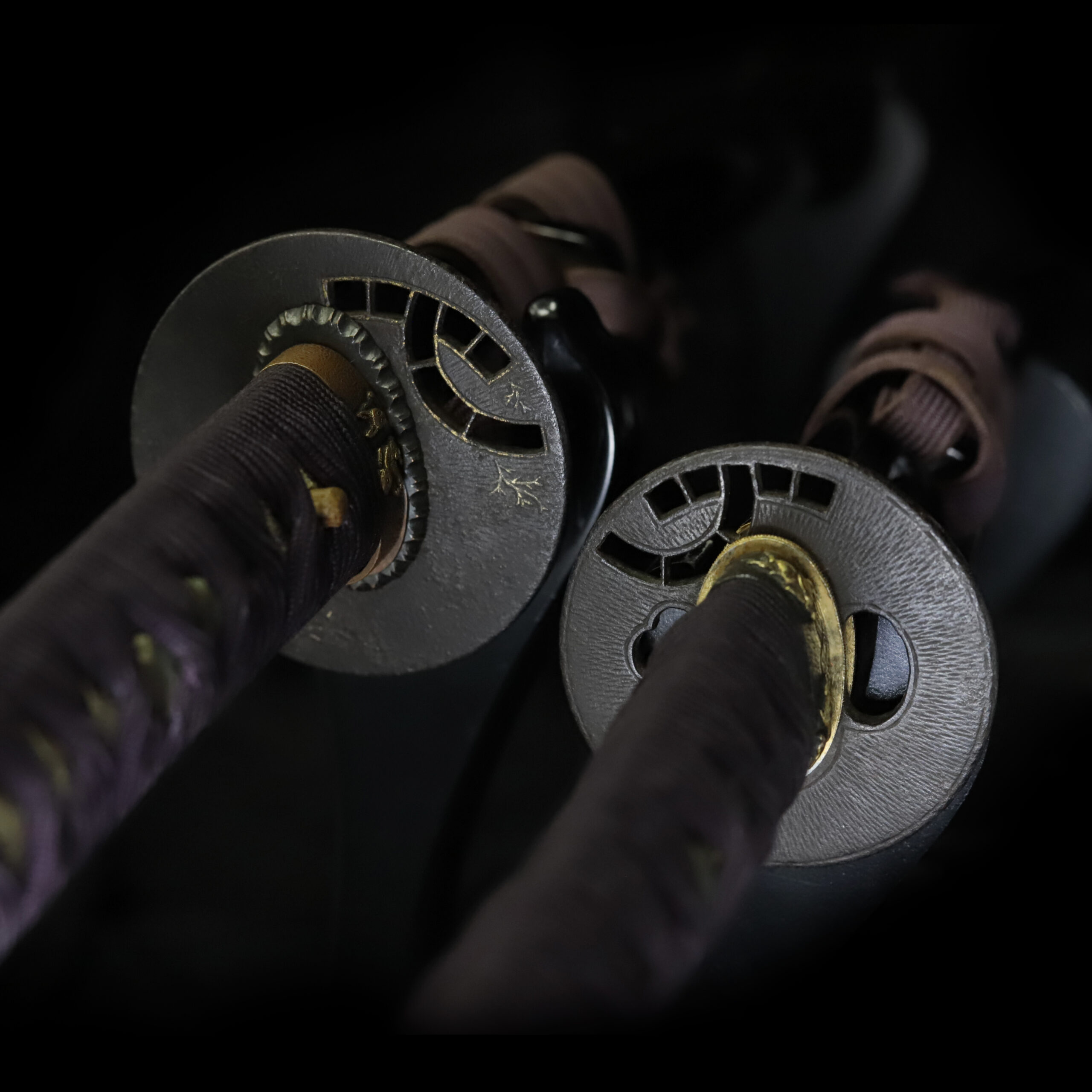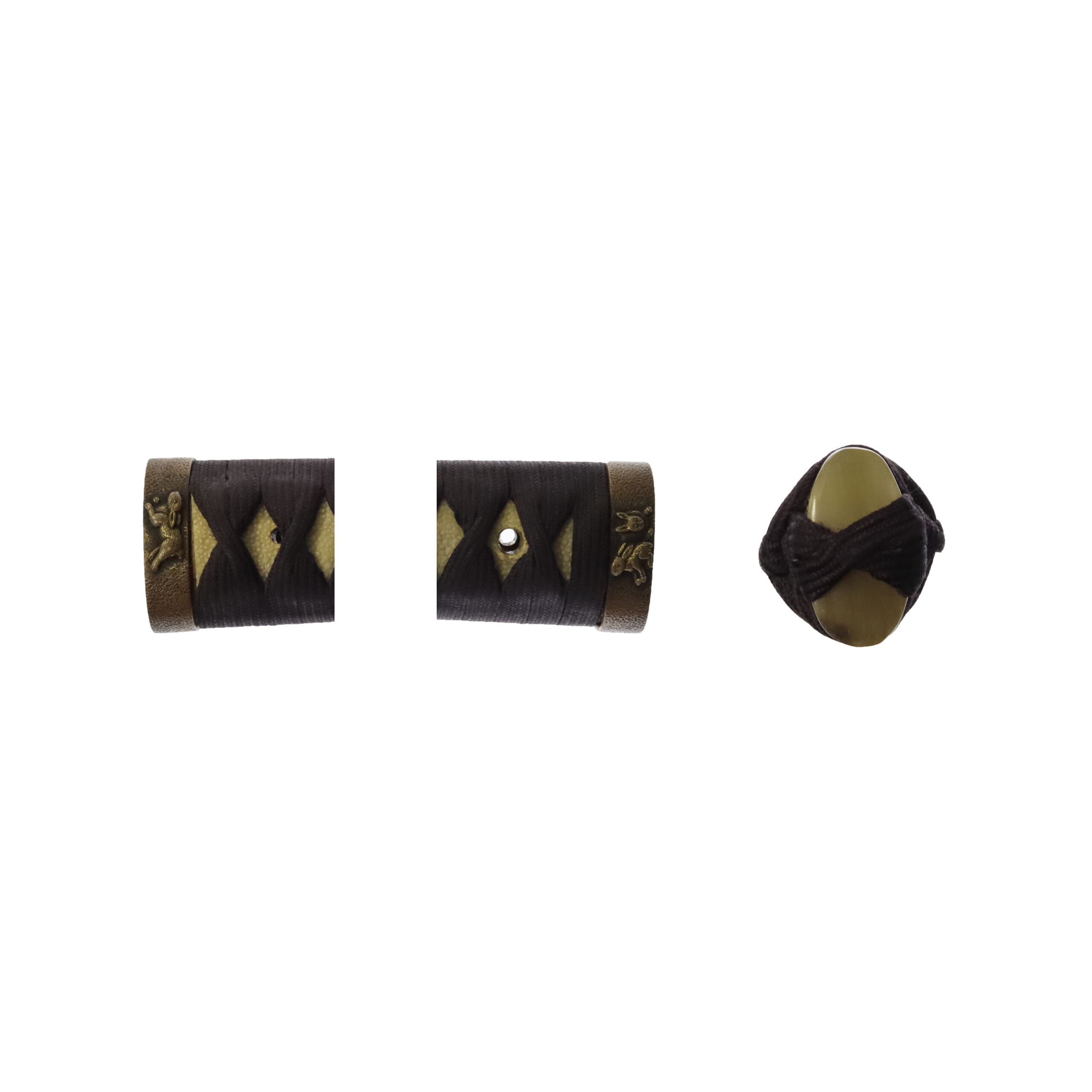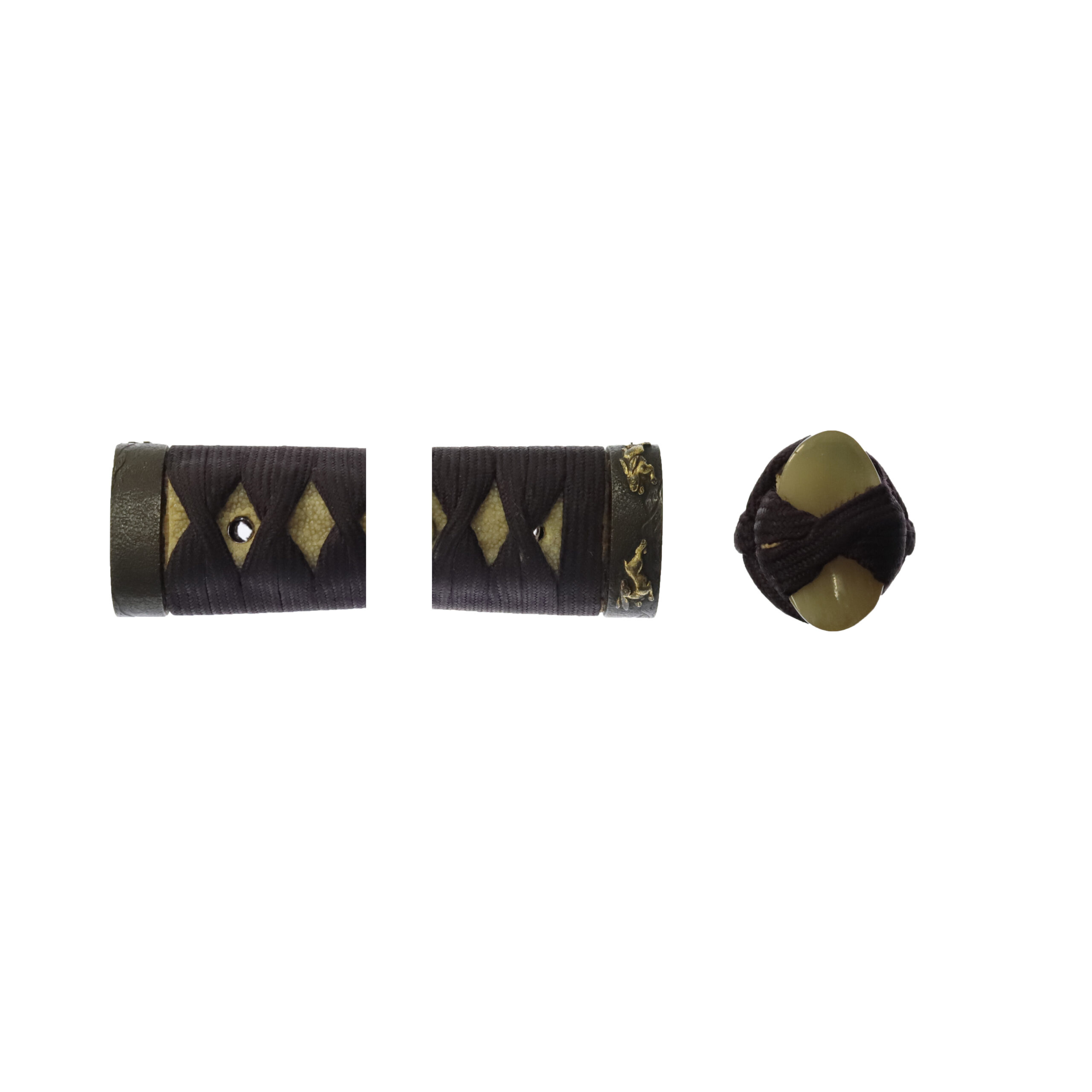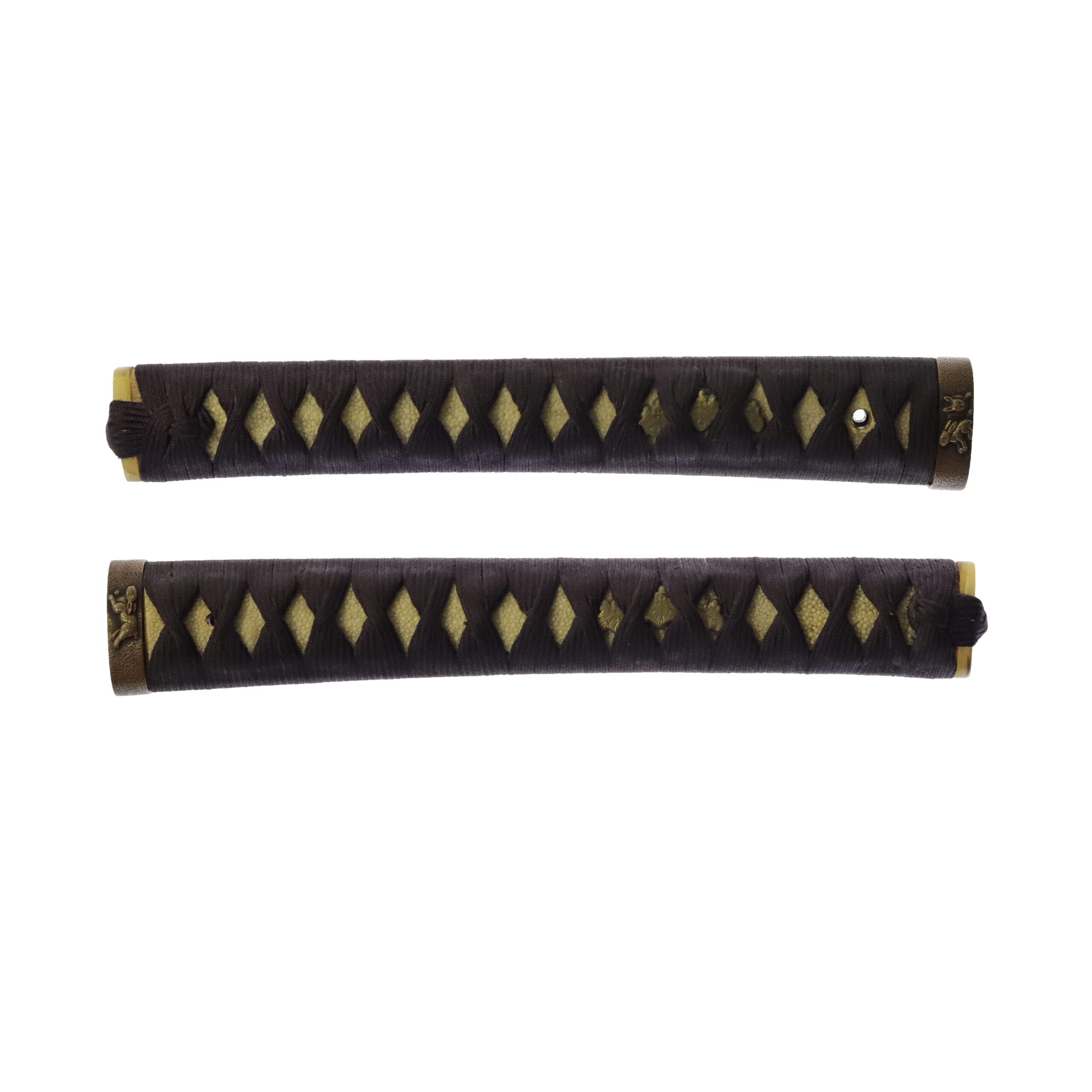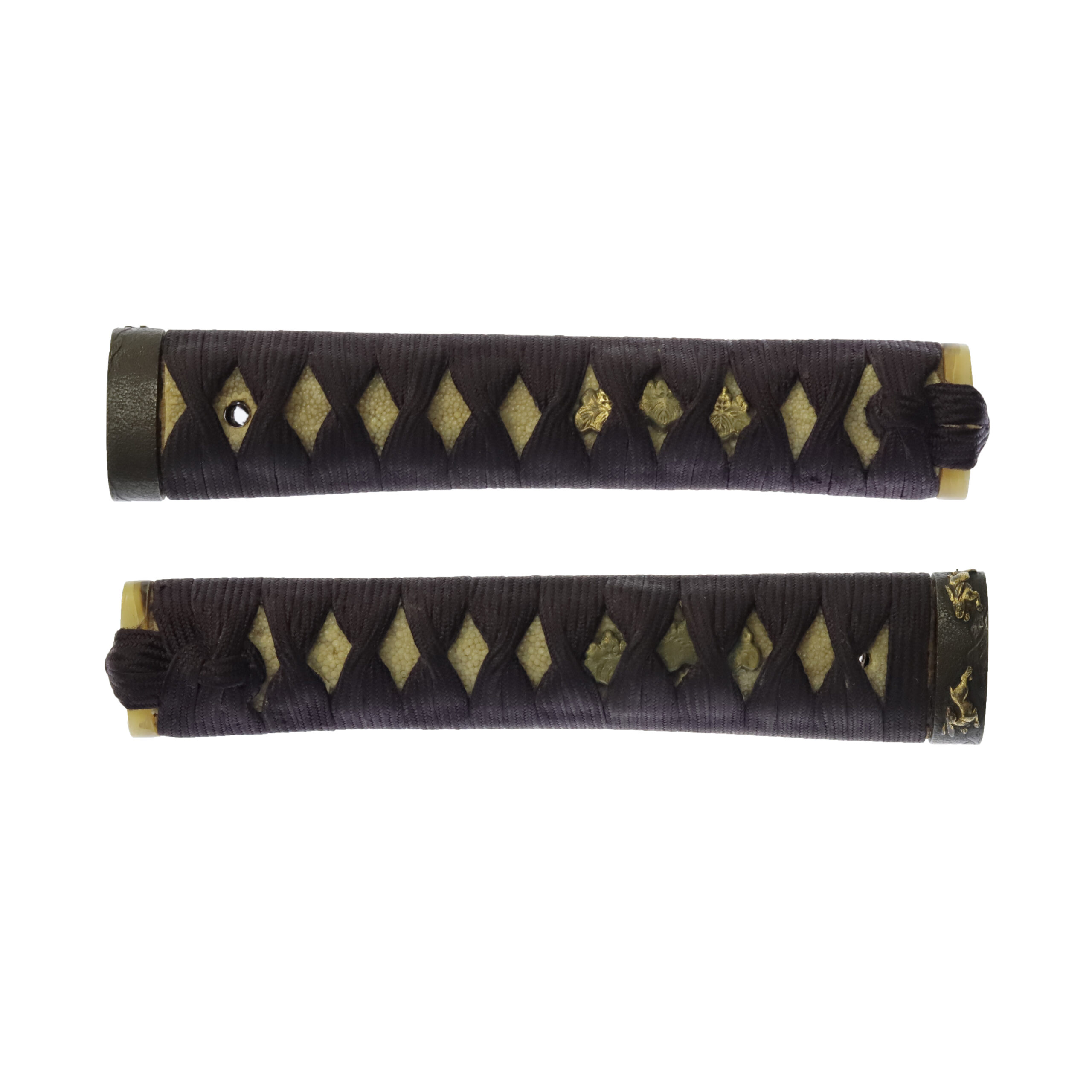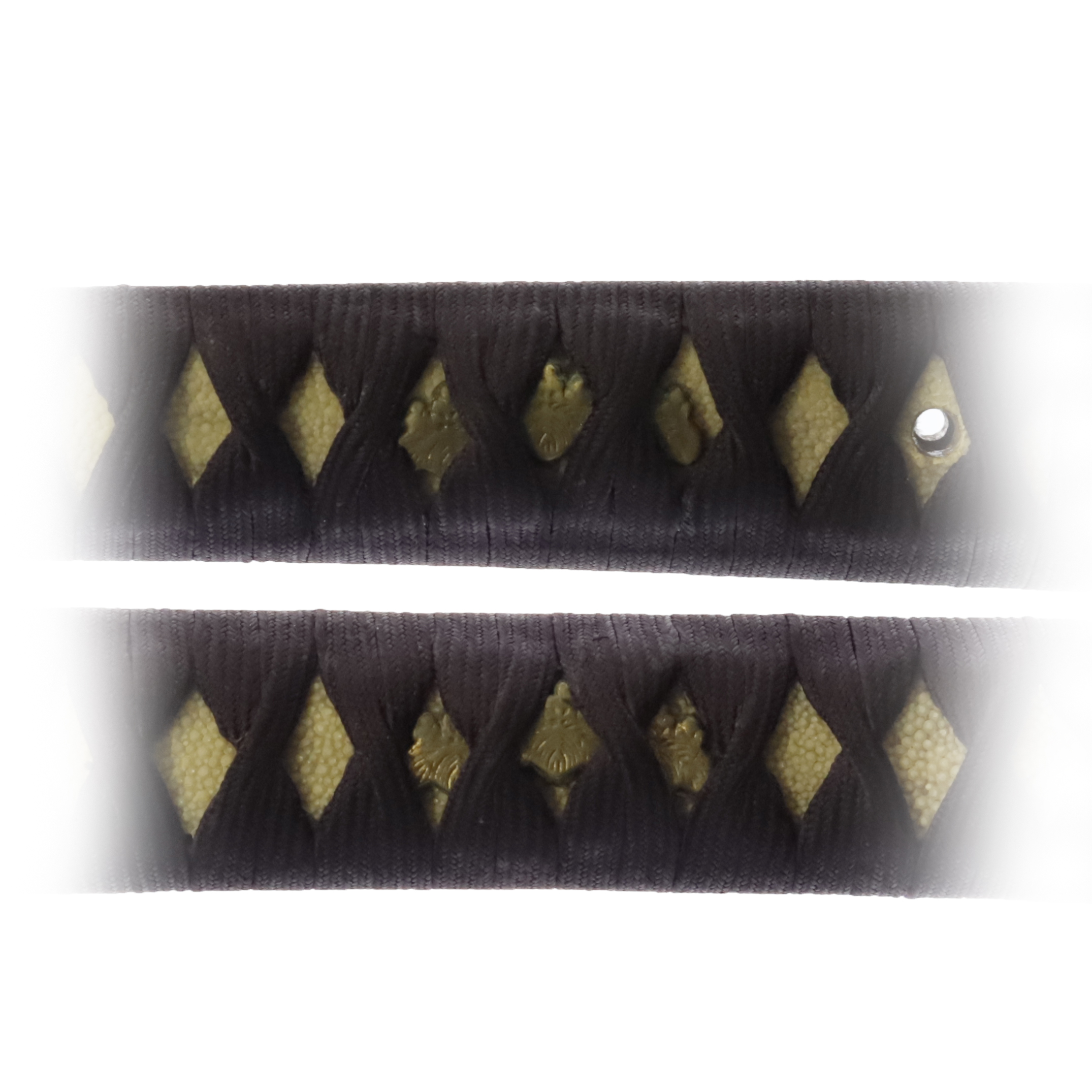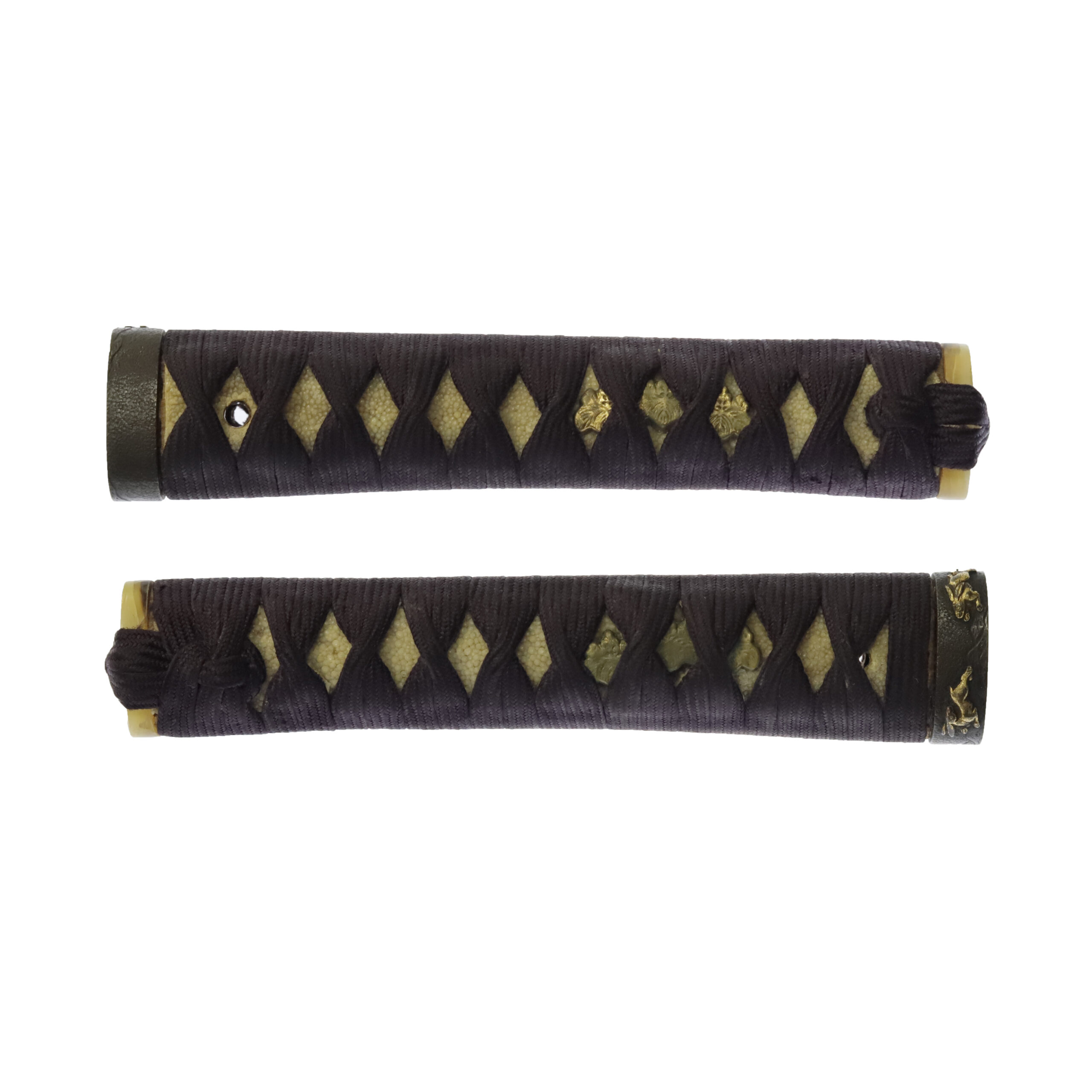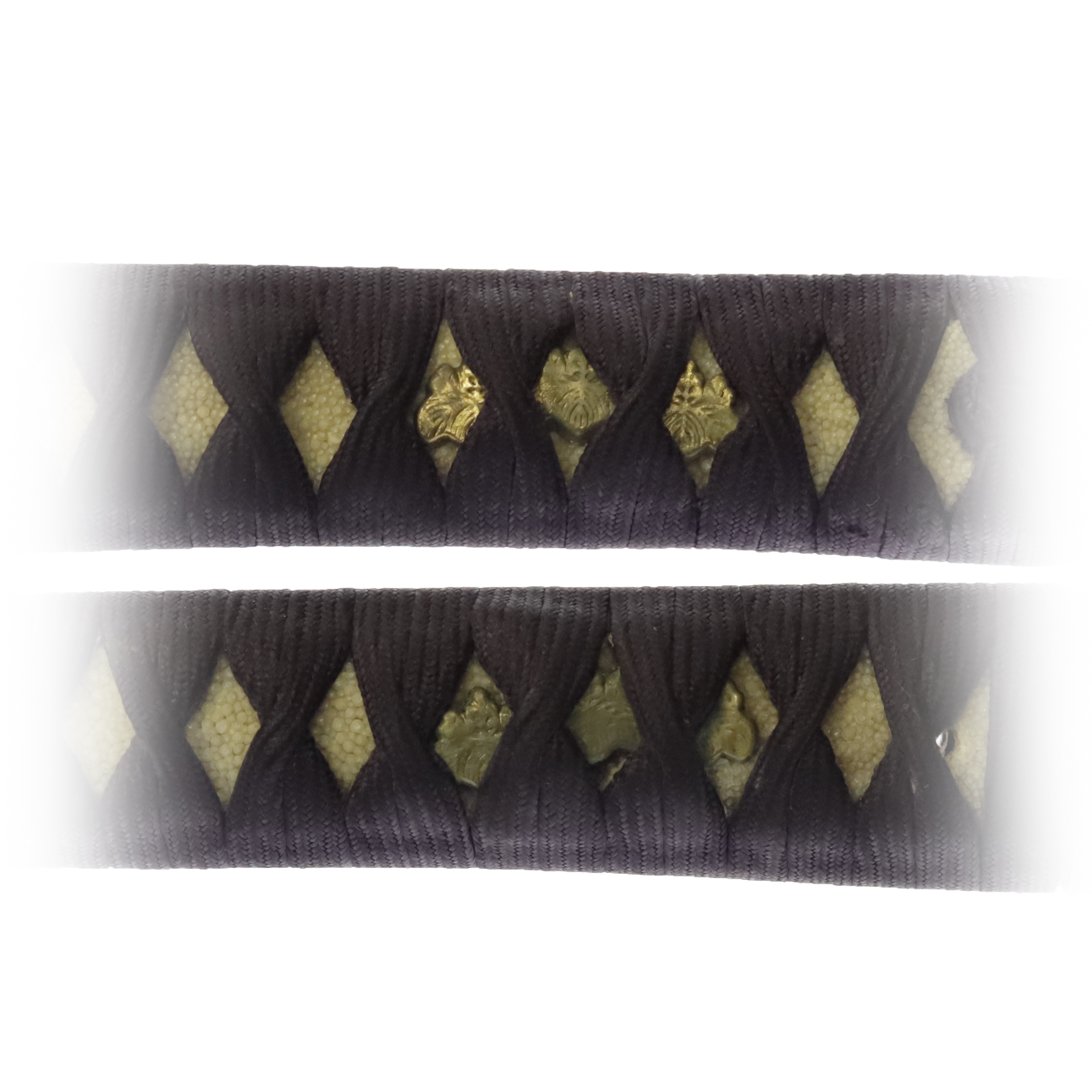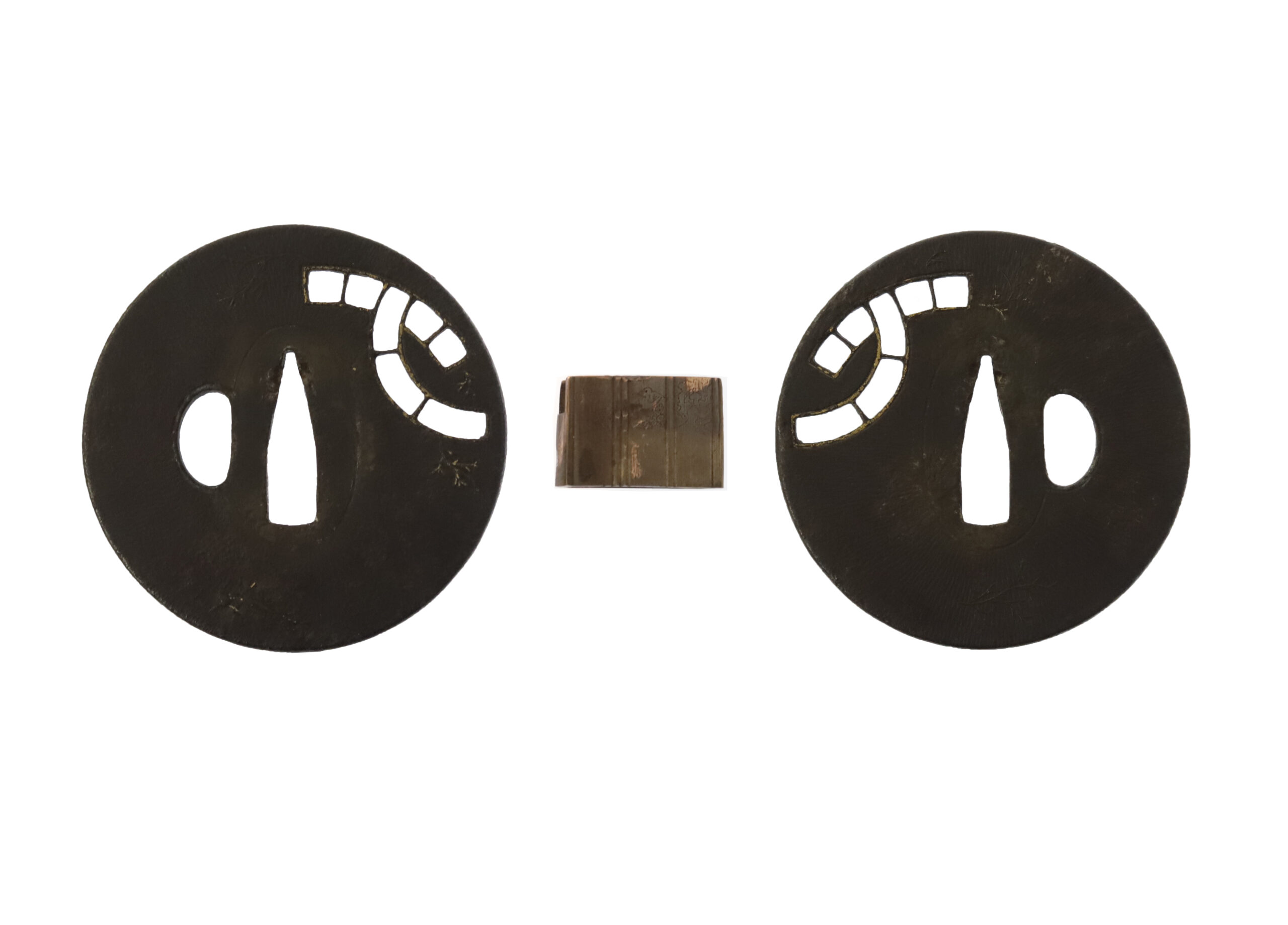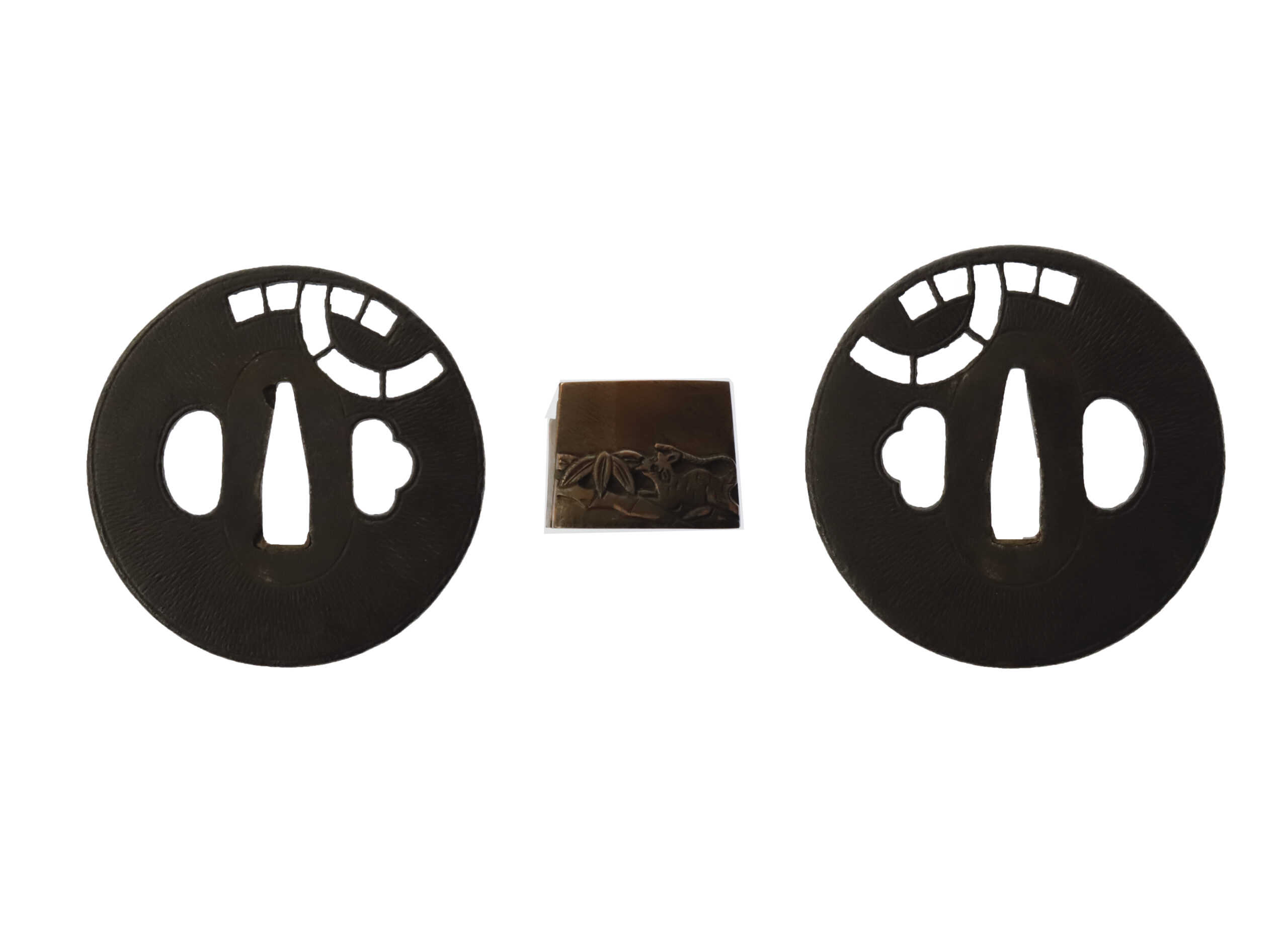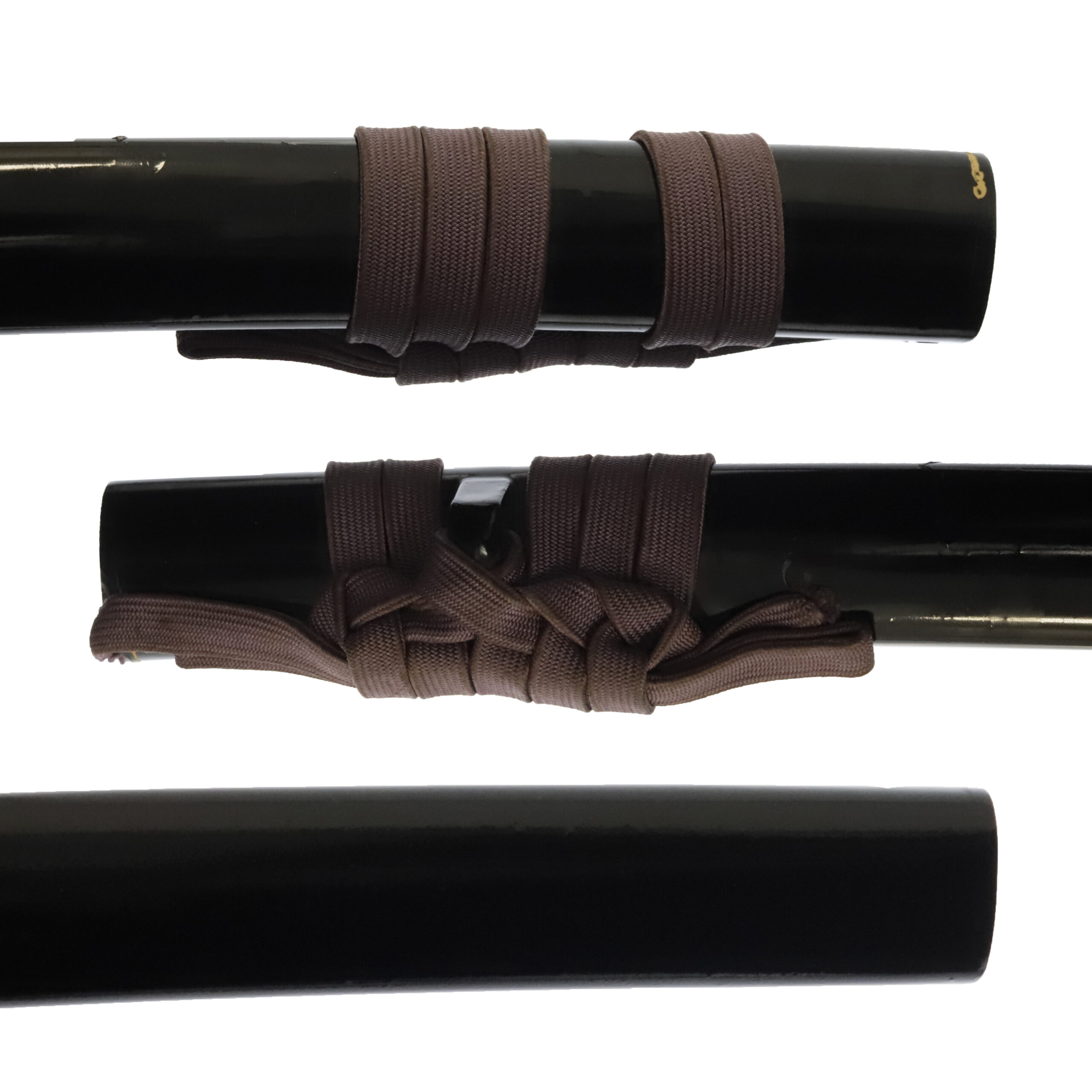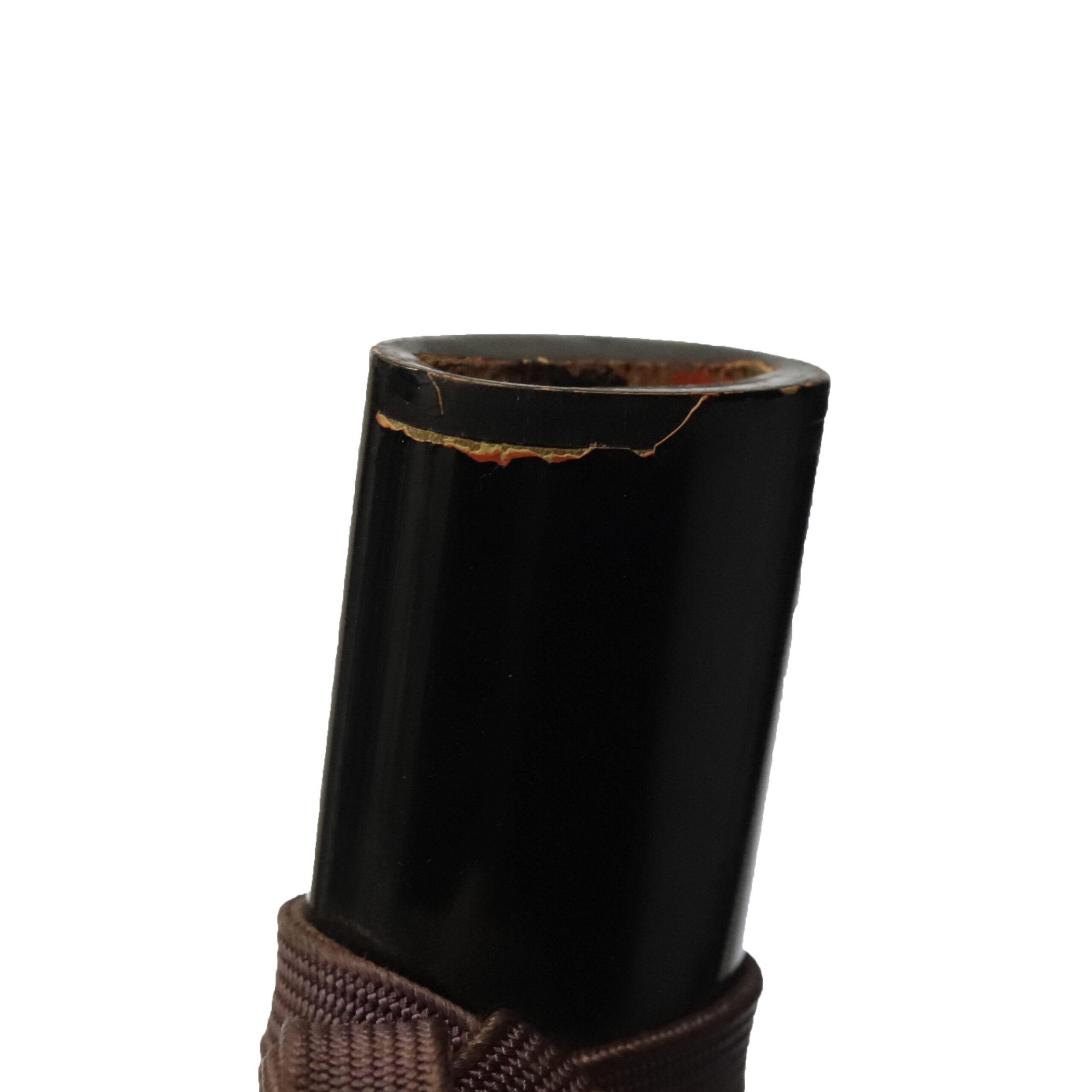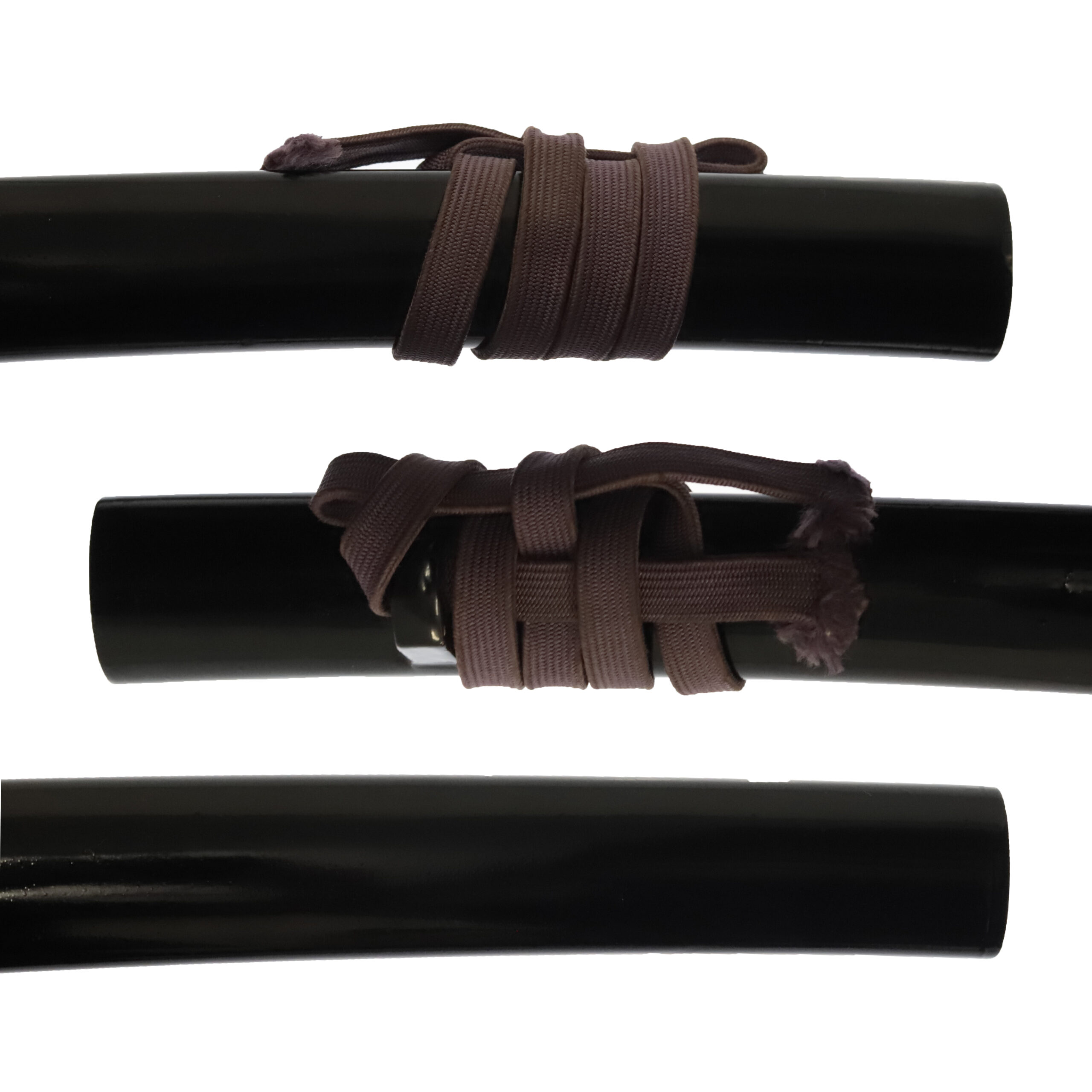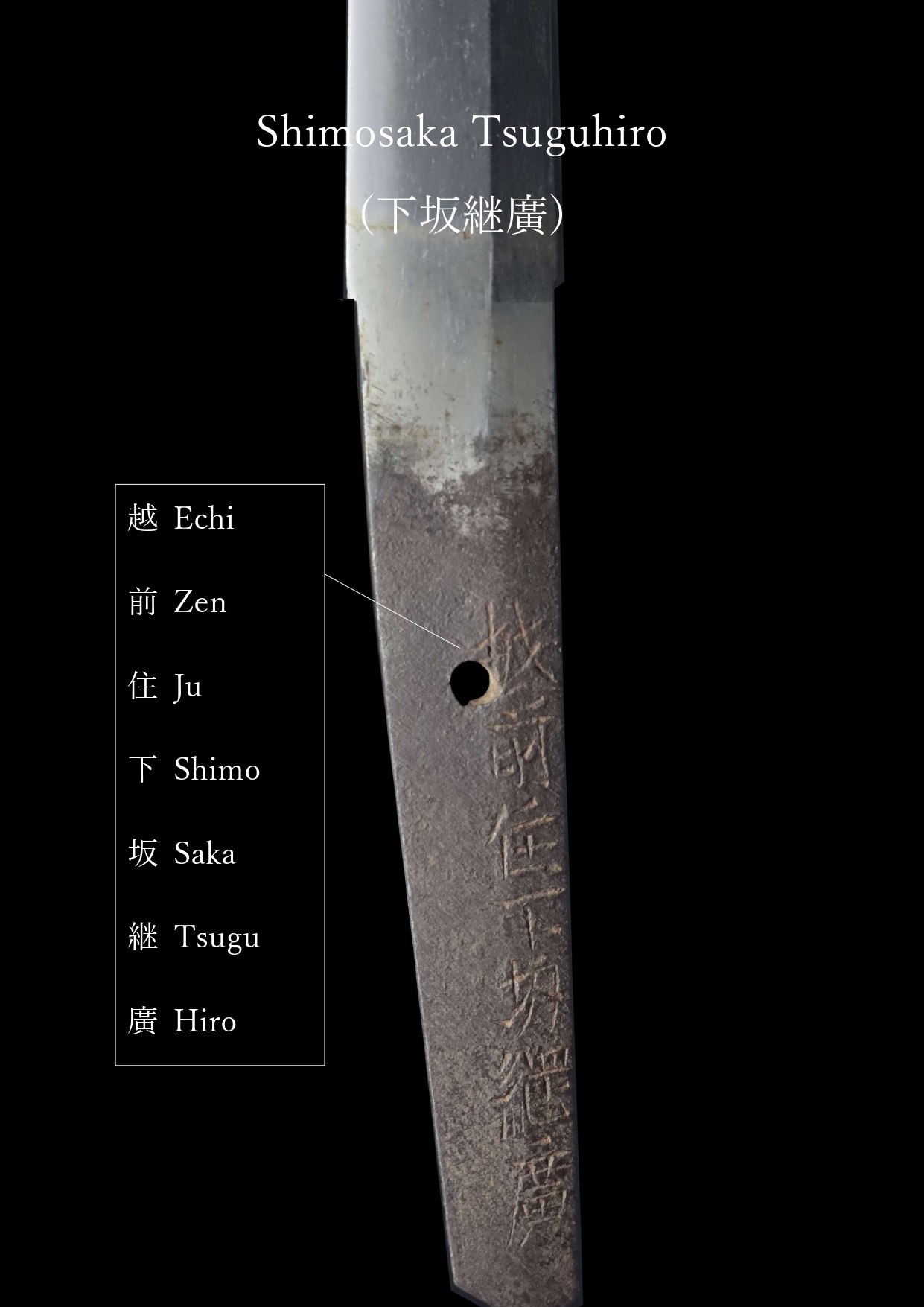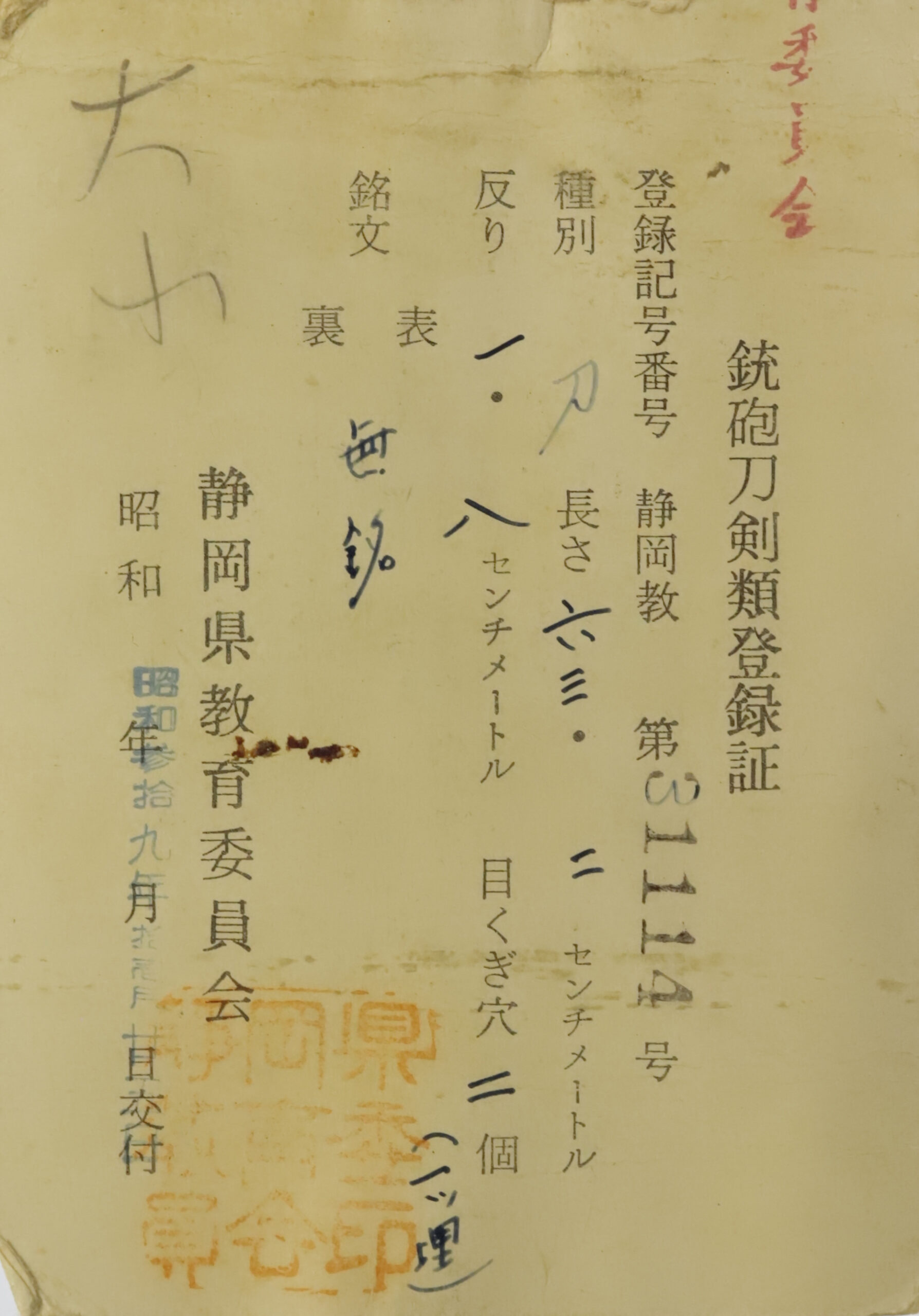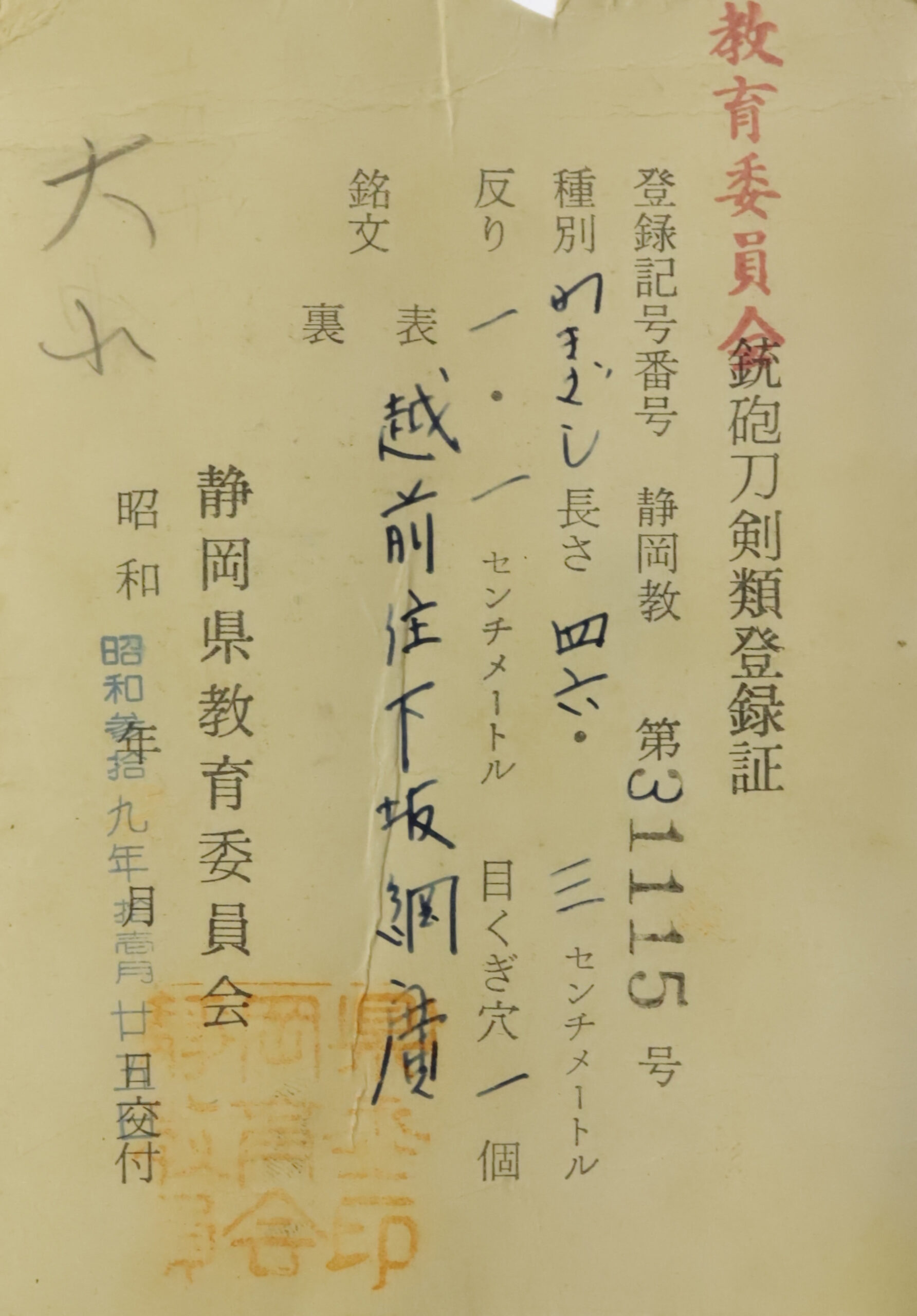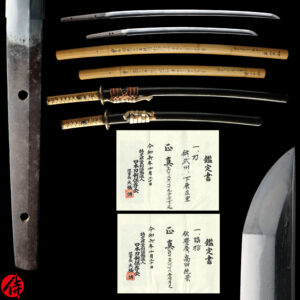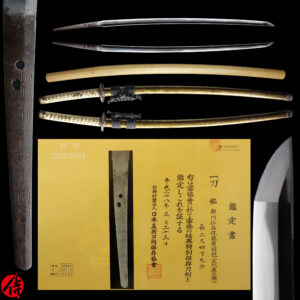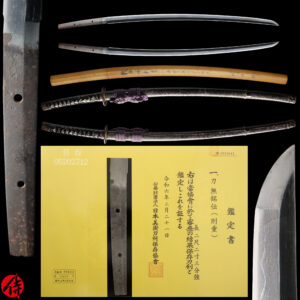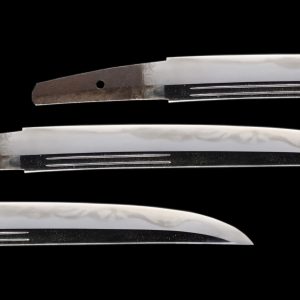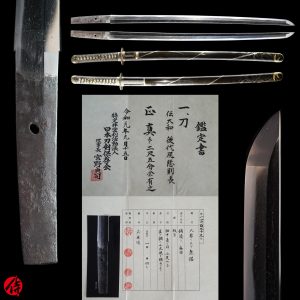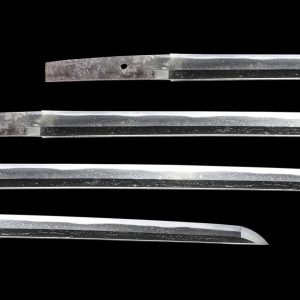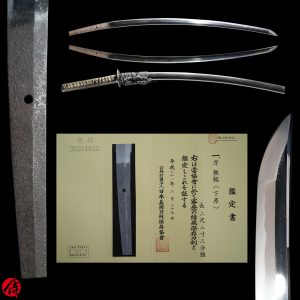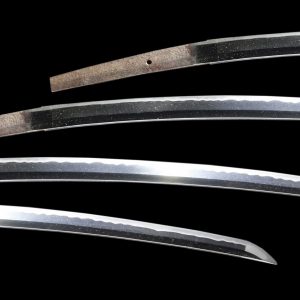Antique Japanese Sword Daisho attributed to Kanemoto and signed by Tsunahiro with NTHK Kanteisho Certificate
【Description】
Katana
This blade is attributed to Nōshū Kanemoto (濃州兼元), dating it to the Tenbun era (1532–1555) of the late Muromachi period. Although the blade bears no remaining signature, the attribution is based on its characteristics. “Nōshū” is another name for Mino Province, where this blade was forged.
The swordsmith name “Kanemoto” lasted 27th generations from the Muromachi period(early 16th century) to the Heisei period(modern-day).
It is said the most skilled Kanemoto of all is the second-gen, also known as Magoroku, who was one of the most famous MINO swordsmiths from the Muromachi period. He forged swords in the Mino province, which is renowned for a particular sword style called MINO-DEN.
About MINO DEN
MINO-DEN exceedingly prospered during Sengoku Jidai(Warring State period) due to the high demand for weapons. And the location of Mino province beat others. Akechi Mitsuhide controlled Mino province, and Nobunaga Oda ruled Owari province. Tokugawa Ieyasu was the lord of Suruga (Neighboring areas). There was high demand from those powerful feudal lords and their retainers.
Furthermore, so many wars occurred between the Kanto region and the Kyoto area. Mino is located in the middle, making feudal lords feel convenient to order swords from MINO-DEN. The blades forged in MINO provinces also had the reputation of their practical design and sharpness. Many feudal lords demanded swords forged in the Mino province. This highly skilled sword-forging technique has been passed down for generations. The smith’s name “Kanemoto” was one of the most famous even after the warring state ended.
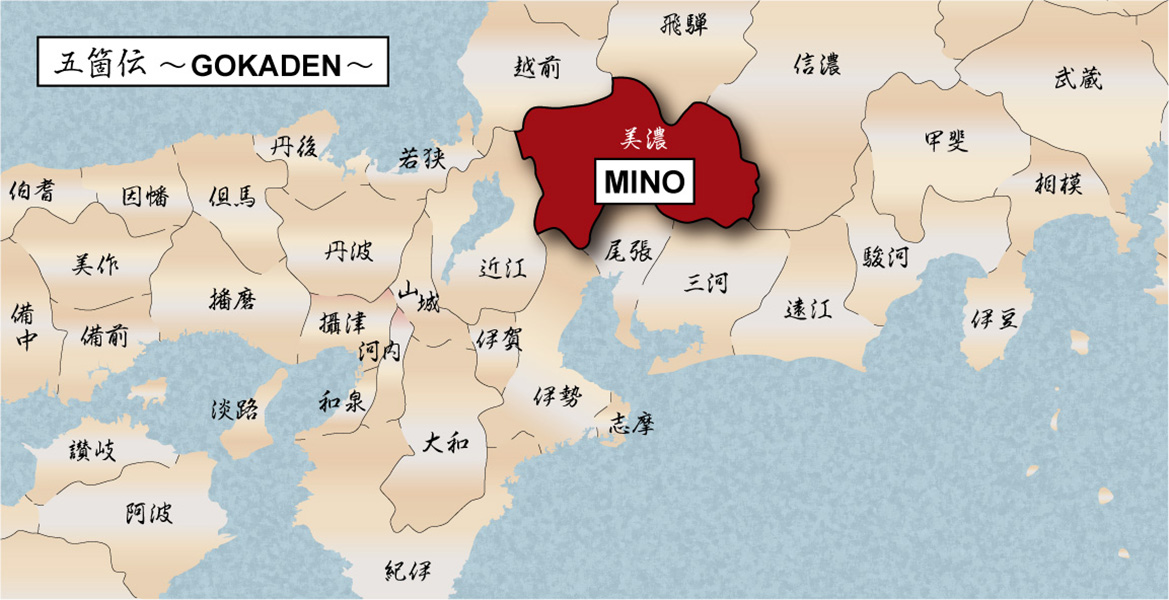

Wakizashi
This blade was signed by Echizen-jū Shimosaka Tsuguhiro (越前住下坂継廣) during the early Edo period. Shimosaka refers to a prominent swordsmith school based in Echizen Province (Today’s Fukui Prefecture). Tsuguhiro was a disciple of the third-generation Yasutsugu, one of the most famous masters of the Echizen Shimosaka school. He later moved from Echizen to Ōmi Province (Today’s Shiga prefecture) and eventually worked in Edo (Today’s Tokyo), continuing the distinguished lineage of Echizen swordsmiths.
During the late Muromachi to early Edo period (1336-1680), many skilled swordsmiths from Seki in Mino Province (Today’s Gifu prefecture) migrated to Echizen, and their collective style came to be known as Echizen Seki. Swords from this region, known as Echizen Shintō (越前新刀), were highly regarded for their exceptional sharpness and cutting ability. They were especially prized during the Tokugawa shogunate as reliable and practical weapons for samurai in active service.
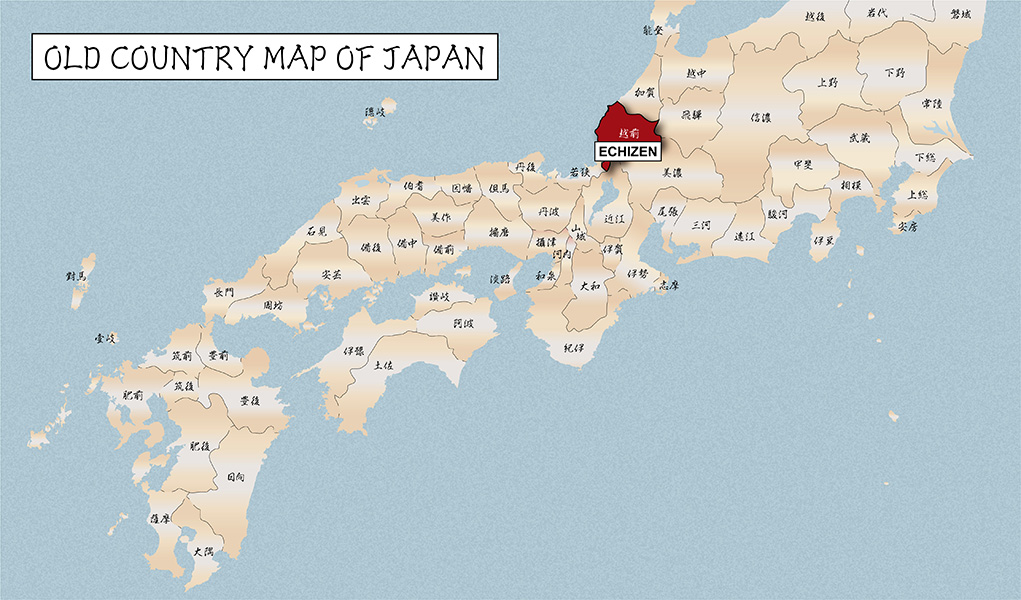
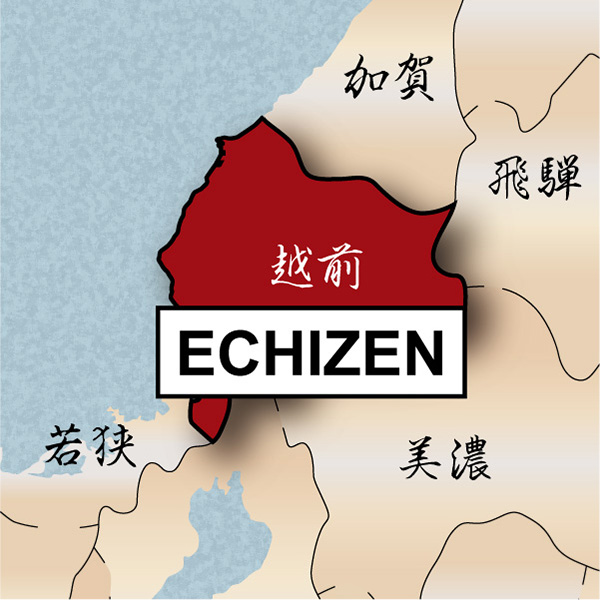
The origins of the Echizen Shimosaka school trace back to the first-generation Yasutsugu, its founder. Born in Shimosaka town in Ōmi Province at the end of the Muromachi period (late 16th century), he initially forged swords there until the beginning of the Keichō era (1596–1615). He later followed his lord’s relocation to Echizen Province, where his outstanding skill earned the patronage of Matsudaira Hideyasu, the third son of Tokugawa Ieyasu, the founder of the Edo shogunate.
Under Hideyasu’s protection, Yasutsugu established the Echizen Shimosaka school, which quickly gained national renown. By Hideyasu’s recommendation, Yasutsugu was appointed as an Okakae-kaji, an official swordsmith serving exclusively for the Tokugawa shogun family. He was personally recognized by both the first and second shoguns, Tokugawa Ieyasu and Tokugawa Hidetada.
In 1606 (Keichō 11), Tokugawa Ieyasu granted him the character “康” (Yasu) from his own name, allowing him to use it in his signature. He was also permitted to engrave the Aoi-mon, the hollyhock family crest of the Tokugawa clan, on the tang of his swords—an extraordinary honor. The Echizen Shimosaka school flourished throughout the Edo period, producing many talented disciples, including Tsuguhiro, and continued to influence Japanese swordmaking for generations.
What is Daisho?
Daisho is a pair of two Japanese swords Samurai carried. During the Edo period, having Daisho in public places was considered social status for Samurai. Furthermore, Samurai were required to wear them under the law back then. Daisho is written as 大=Big and 小=Small. Dai part means Katana, and Sho part means Wakizashi.
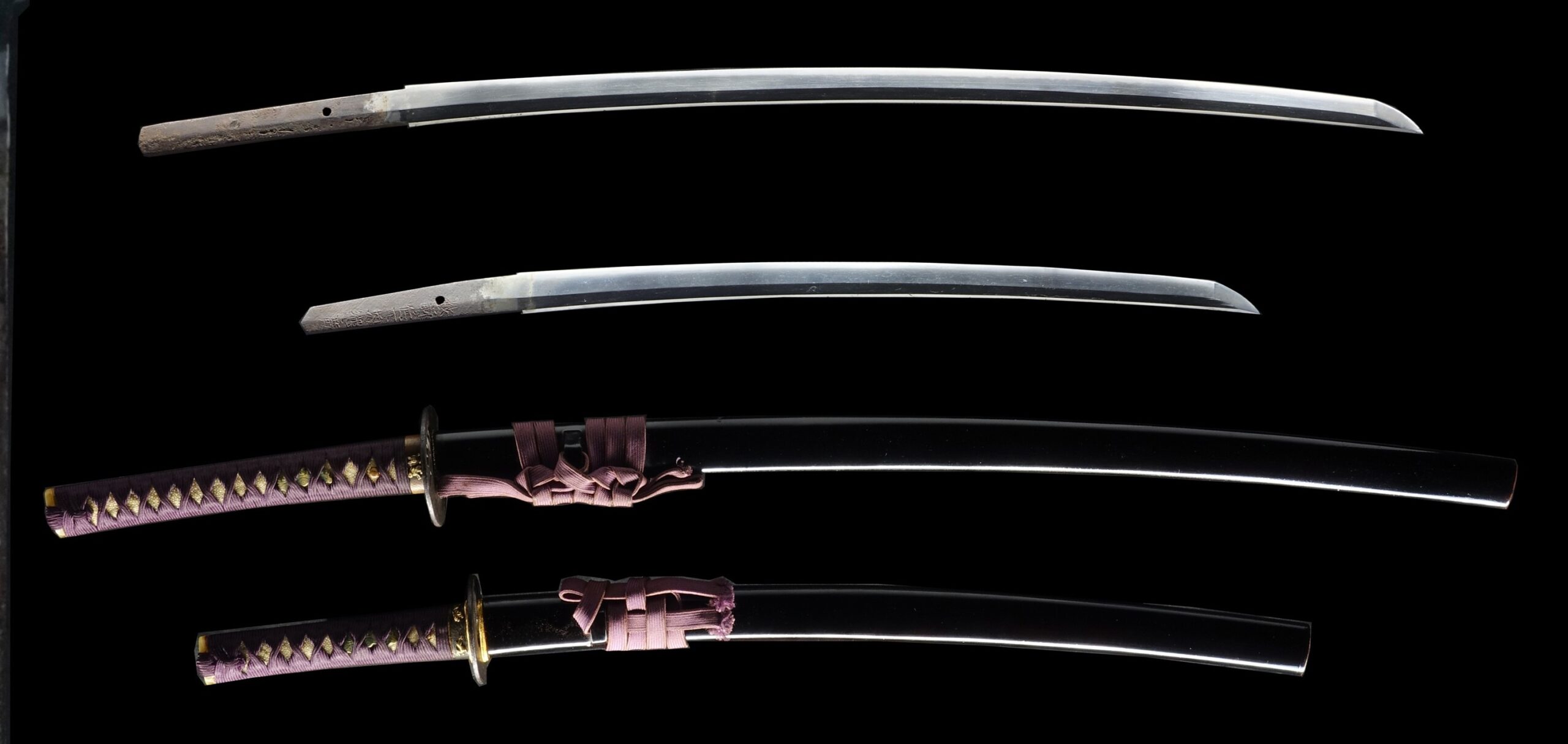
*Please keep in mind that there are a few Kitae Kizu, a couple of chips and black rust on the blade of this Katana and Wakizashi. If you like to see the detailed condition, please feel free to contact us.
【Blade】
-Katana
Cutting Edge Length(Nagasa): 63.2 cm (24.8 inches)
Curvature(Sori):1.8 cm (0.70 inches)

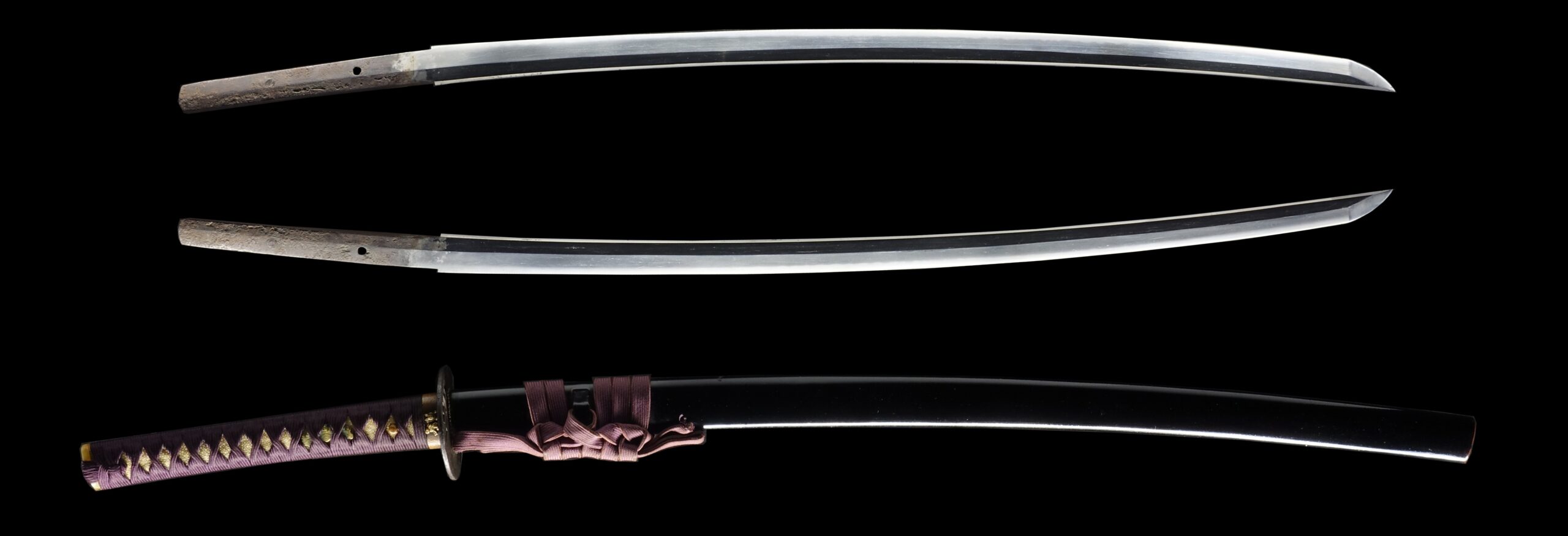
-Wakizashi
Cutting Edge Length(Nagasa):46.3 cm (18.2 inches)
Curvature(Sori):1.1 cm (0.43 inches)


Hamon:
The crystalline structure which forms along the cutting edge of a blade as a result of the hardening process
Jimon(Jihada):
visible steel surface pattern created by folding and hammering during forging process
-Katana
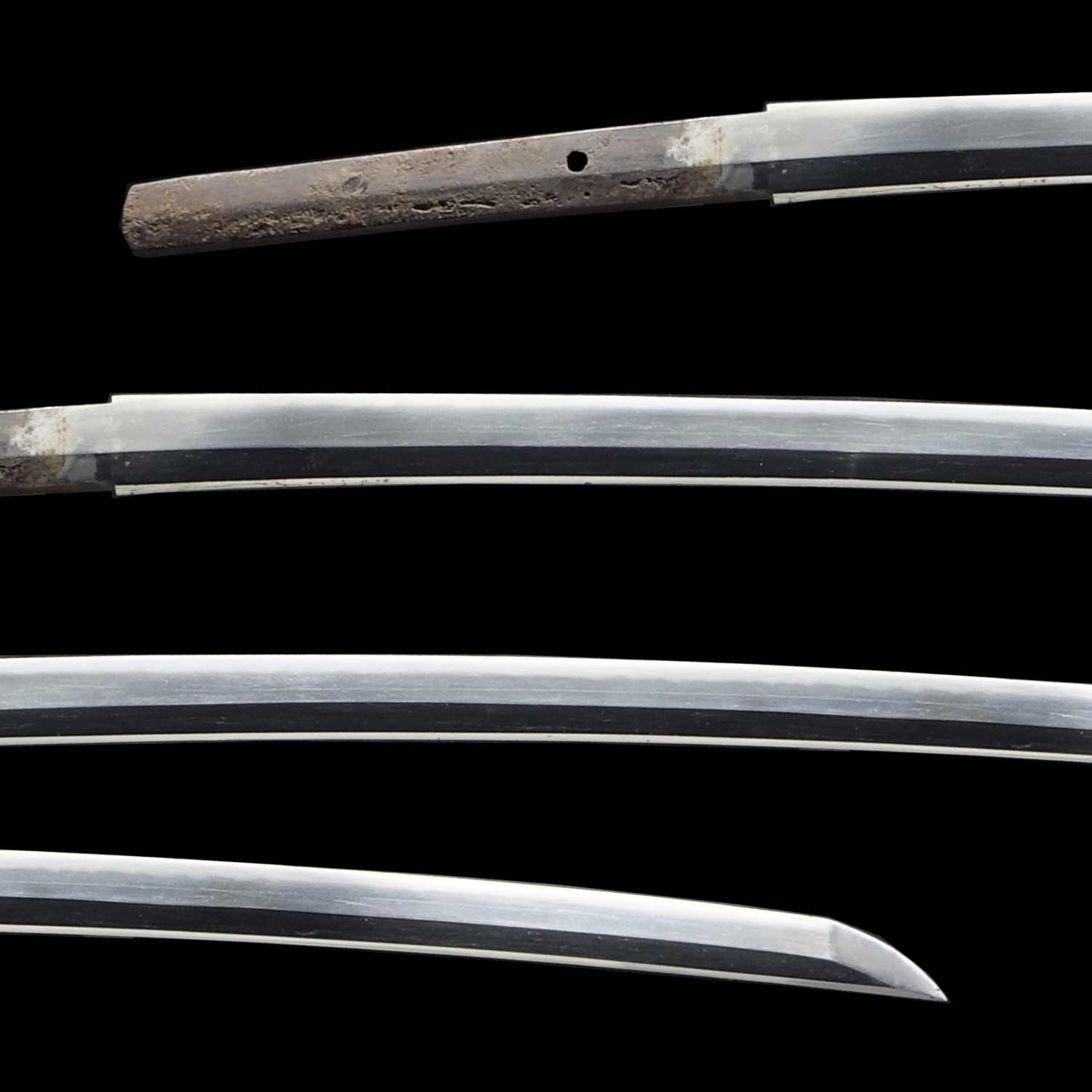
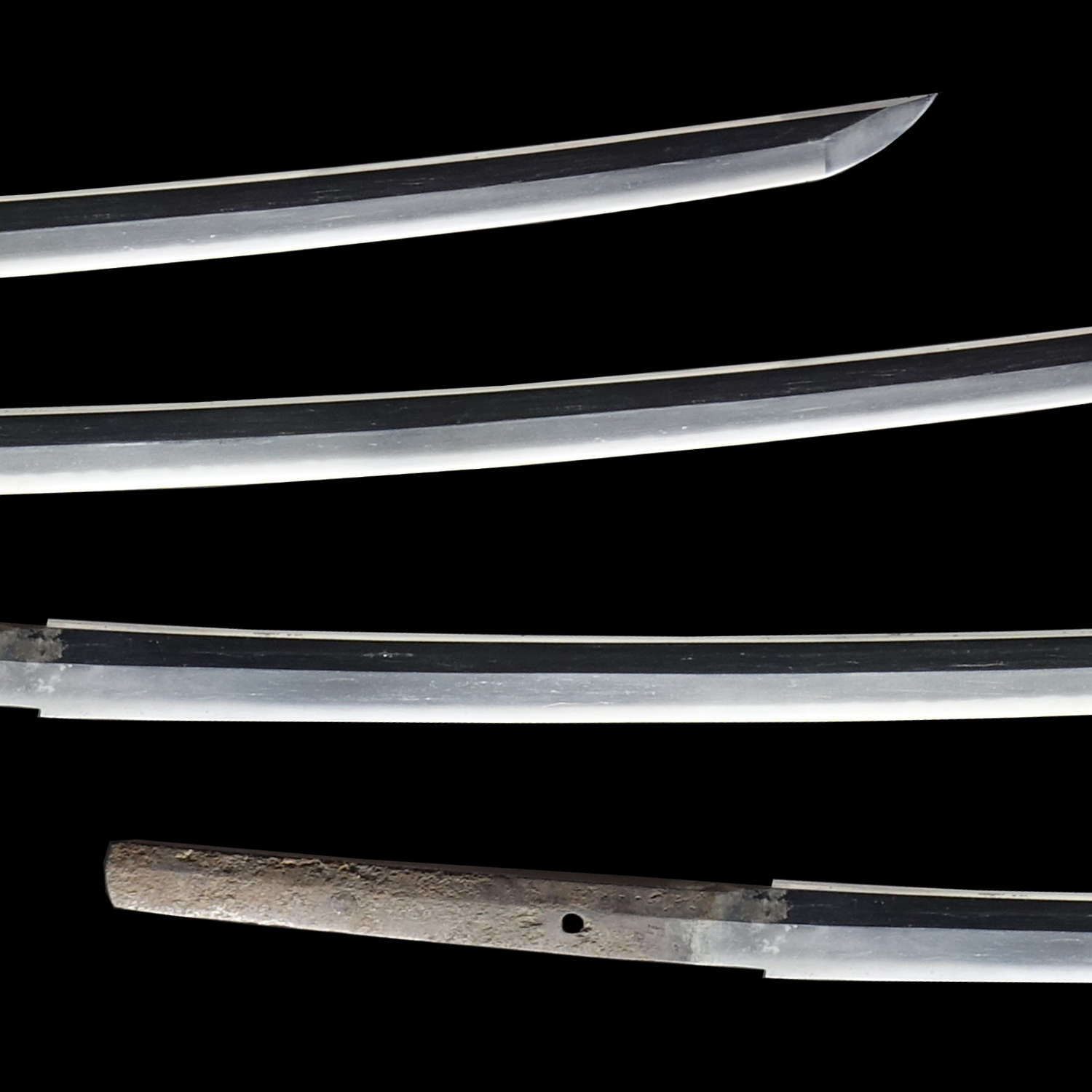
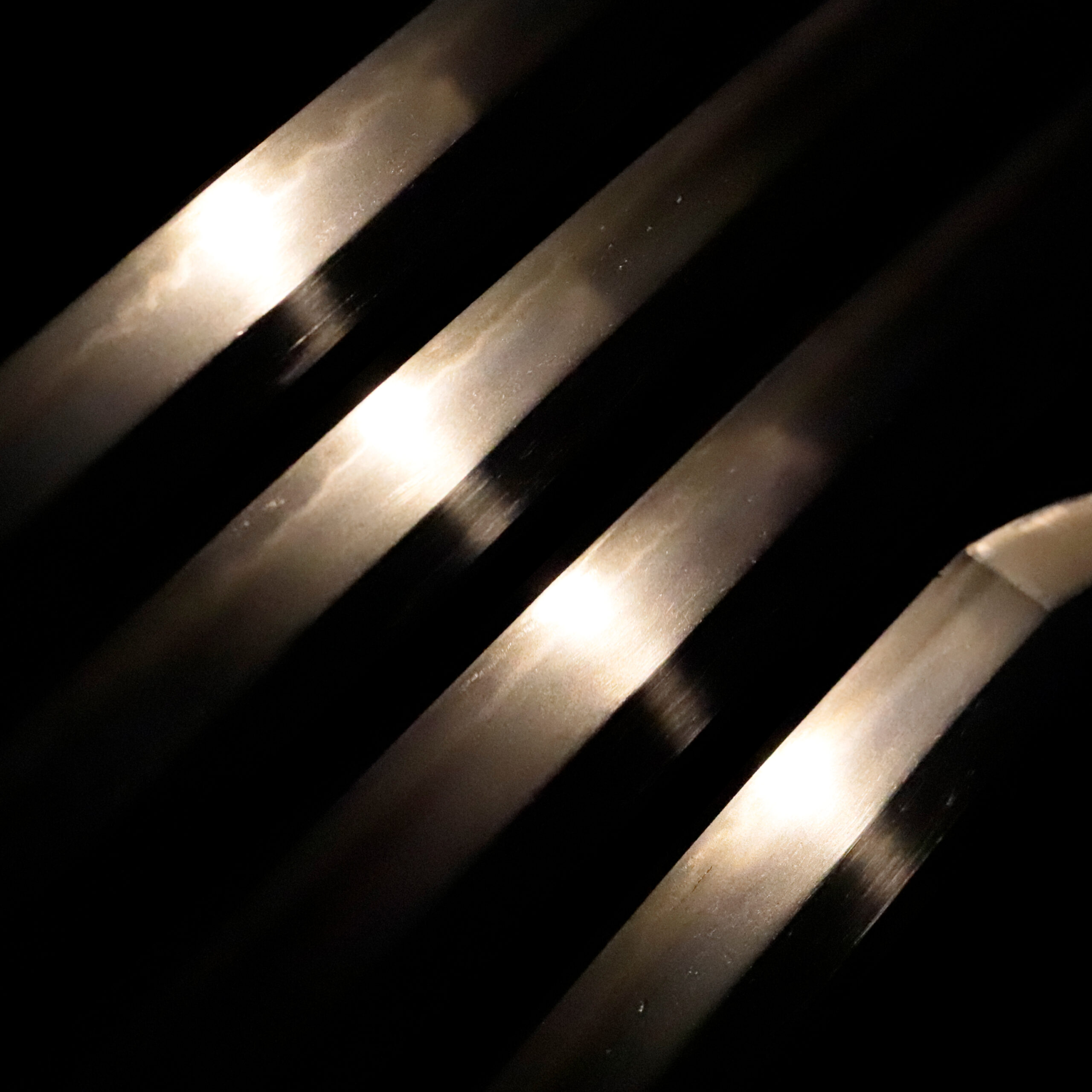
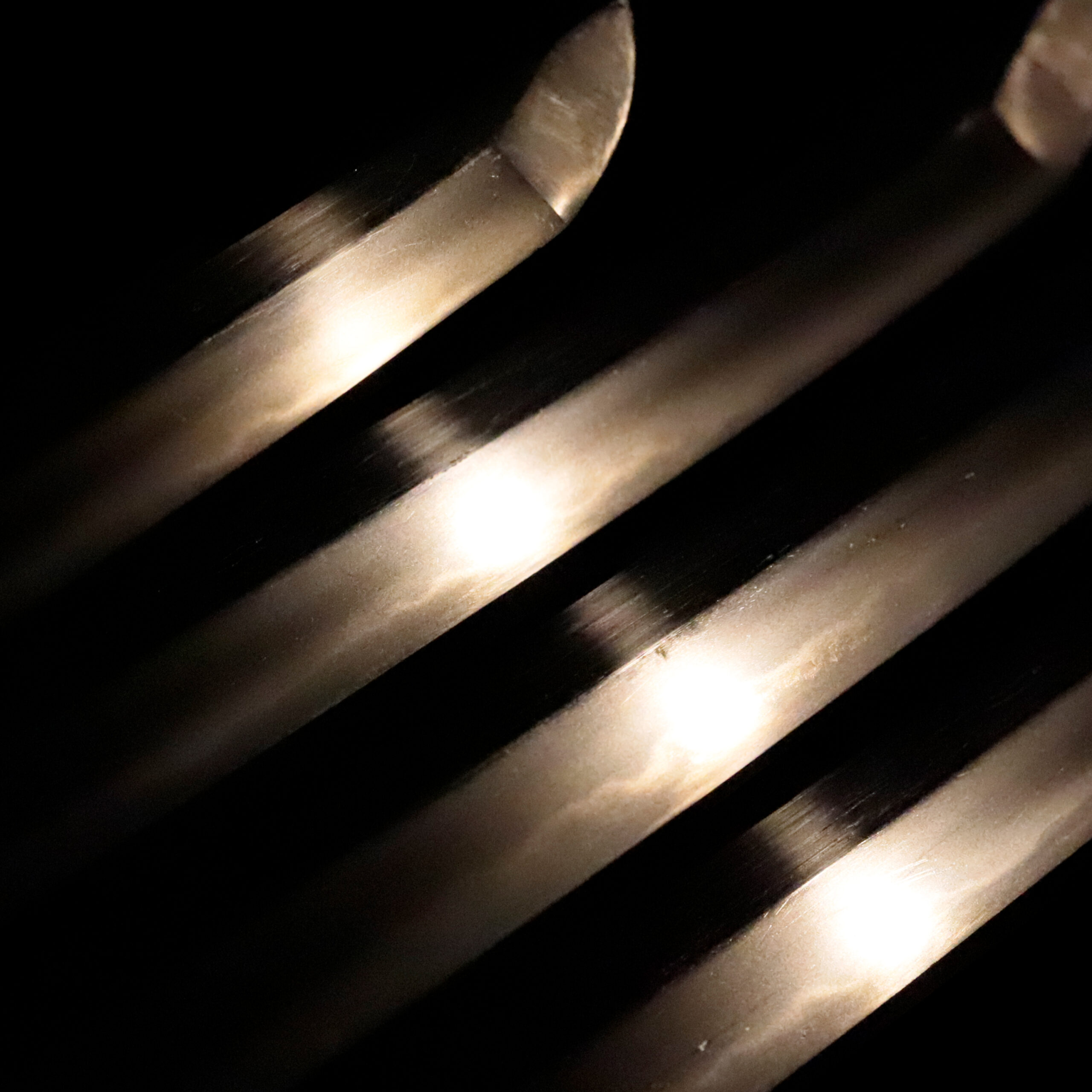
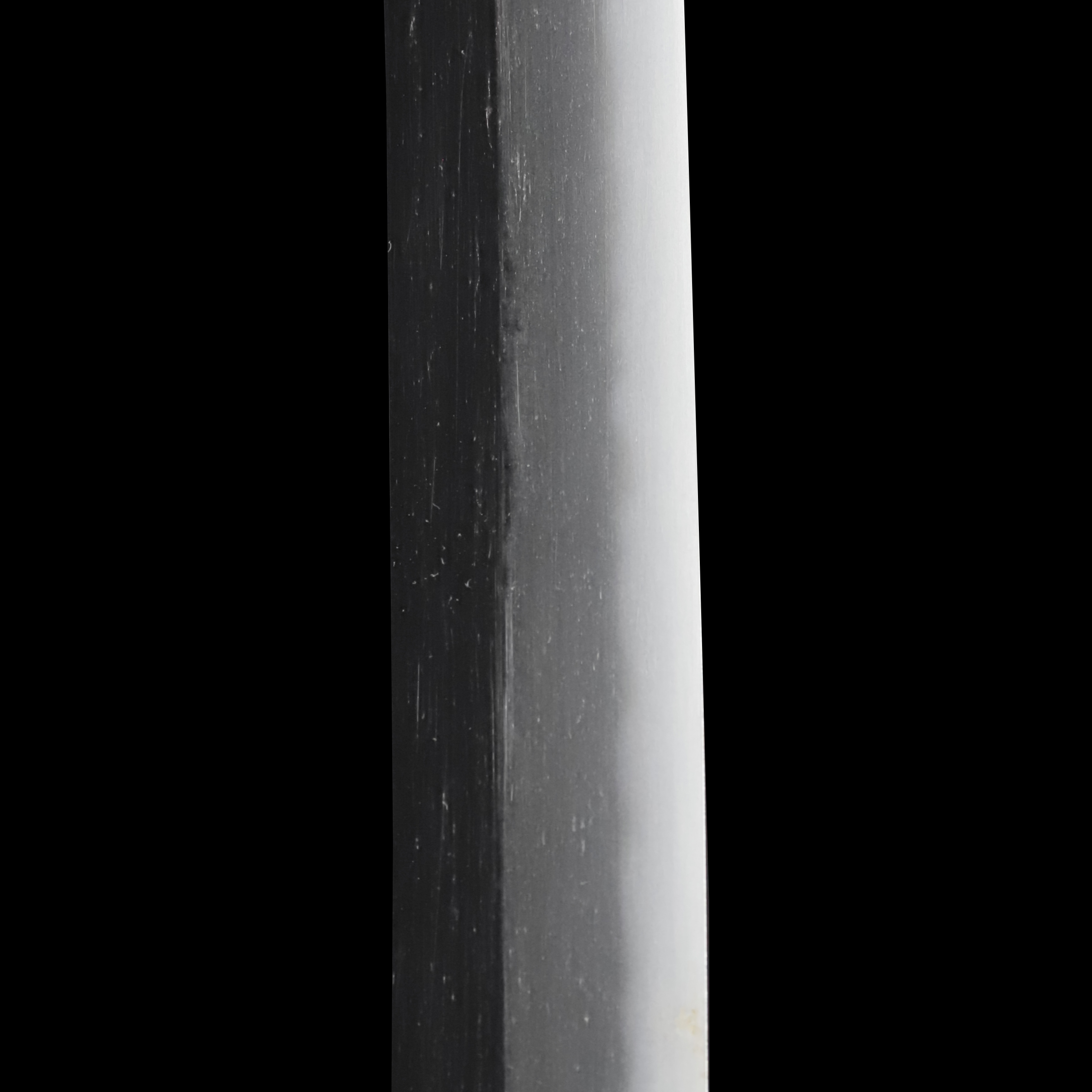
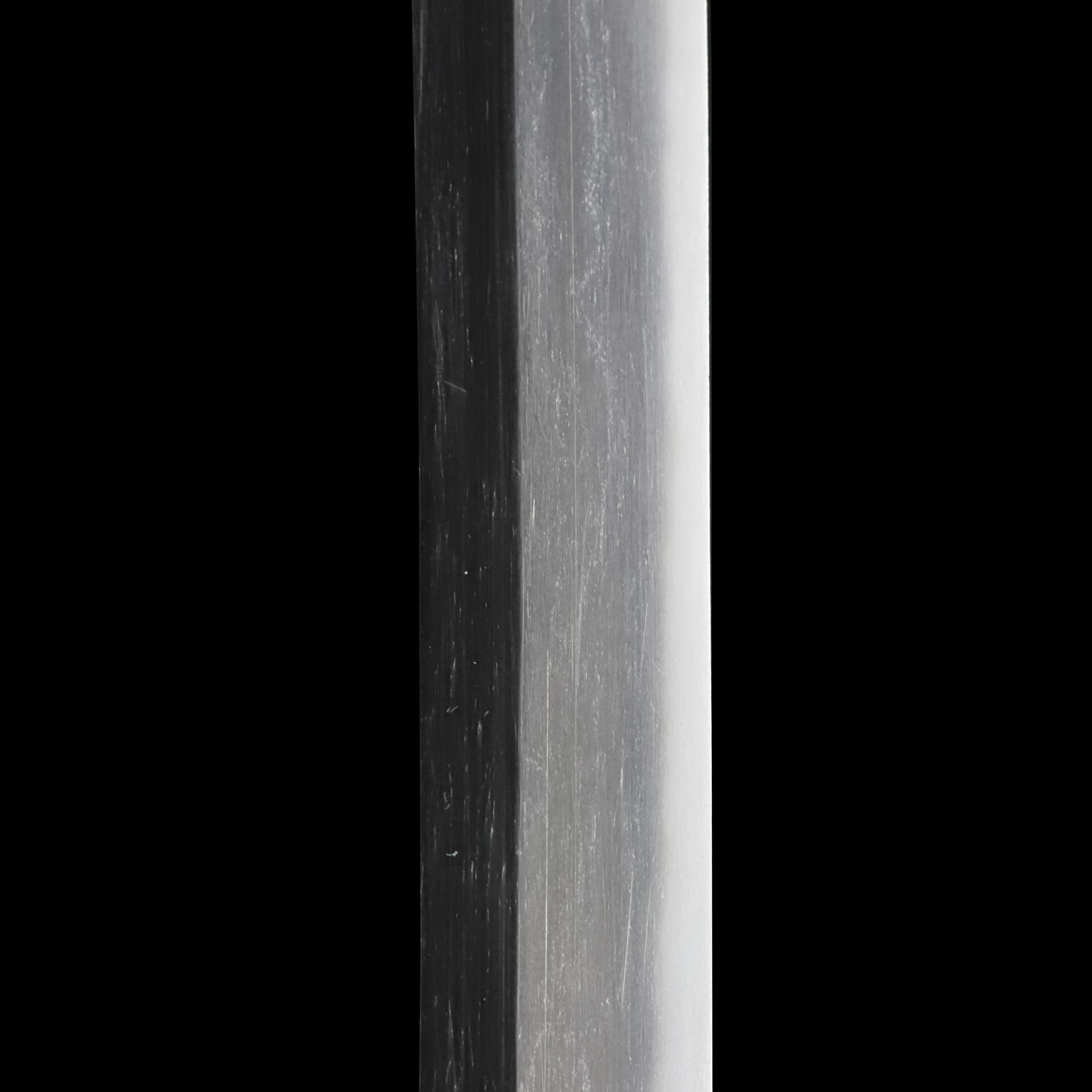
-Wakizashi
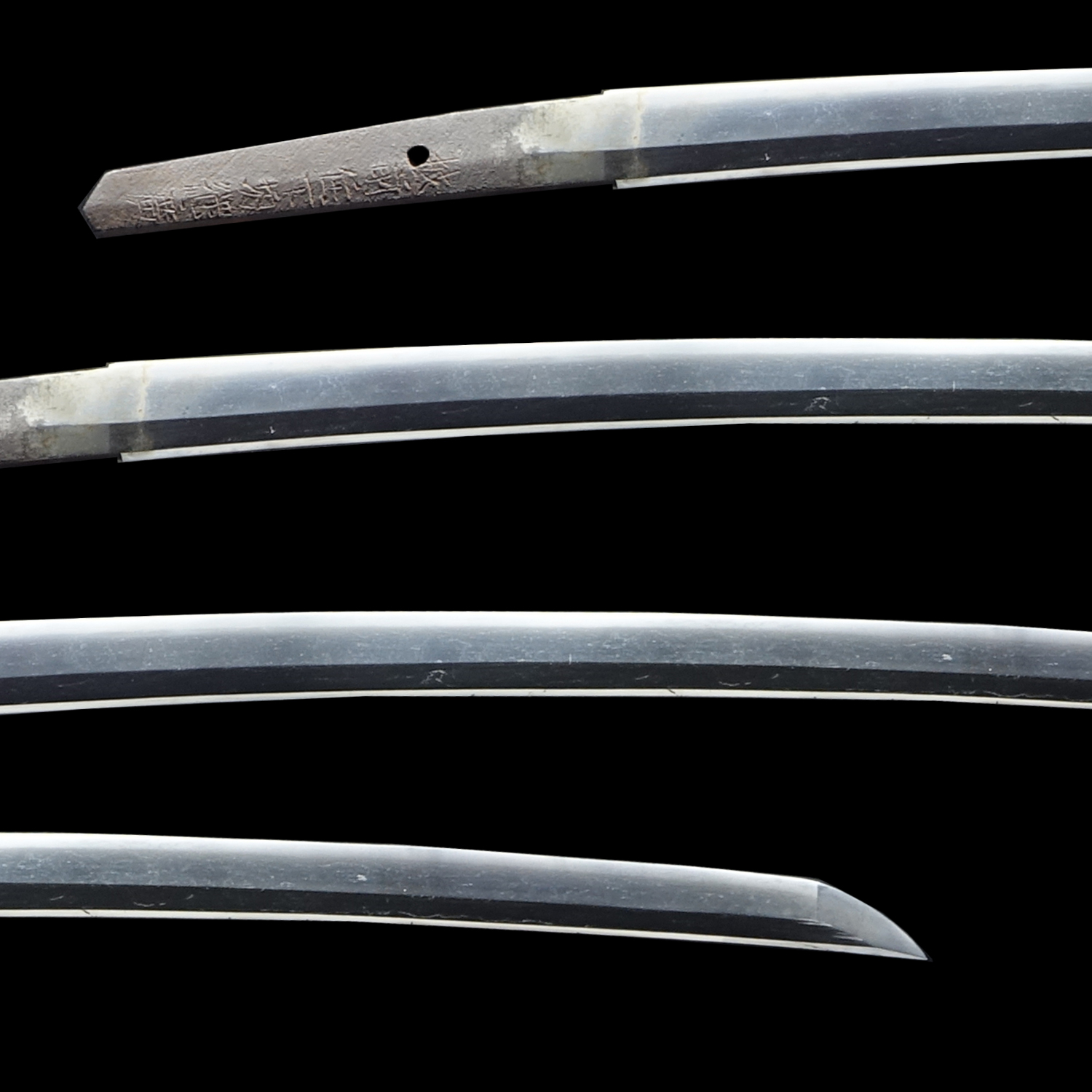
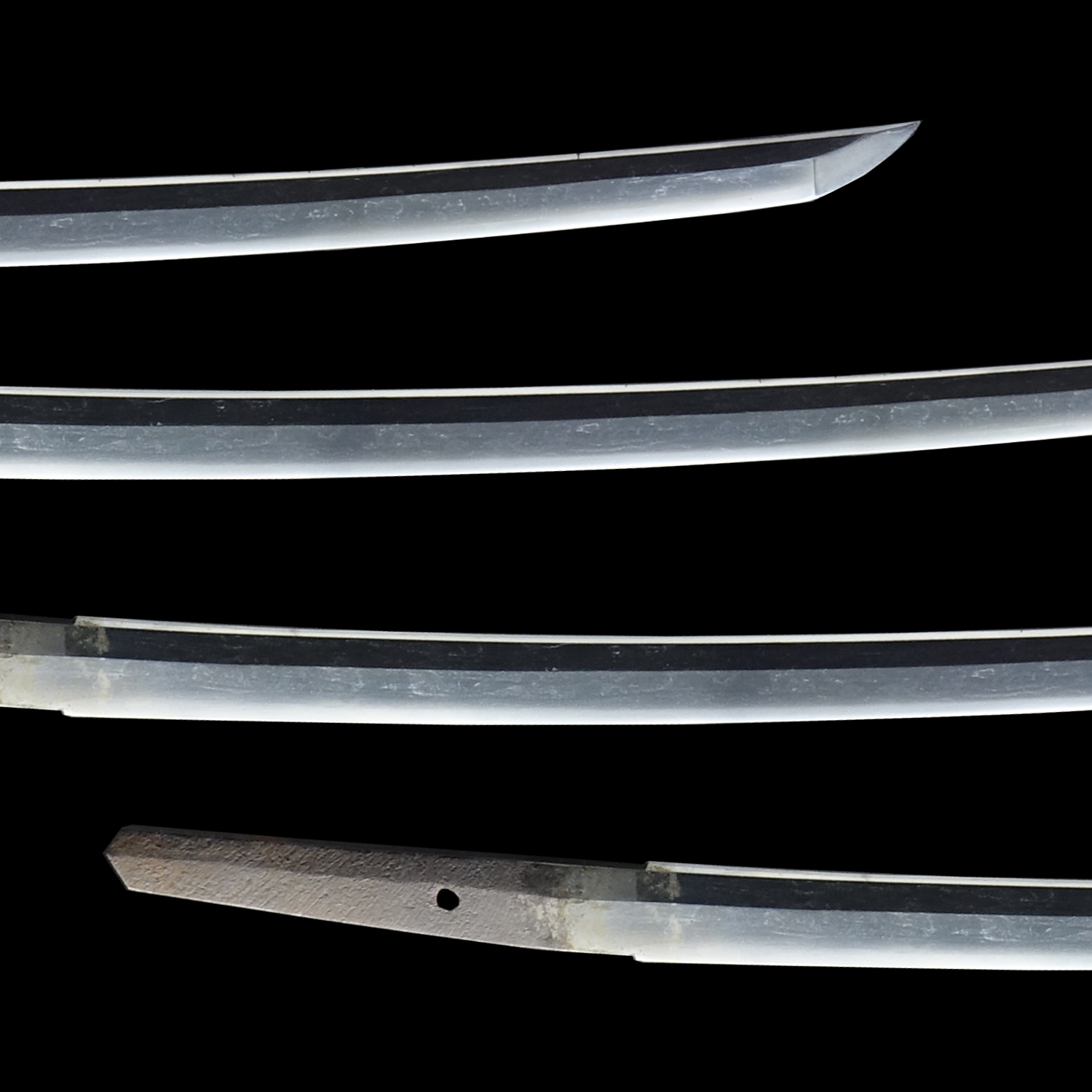
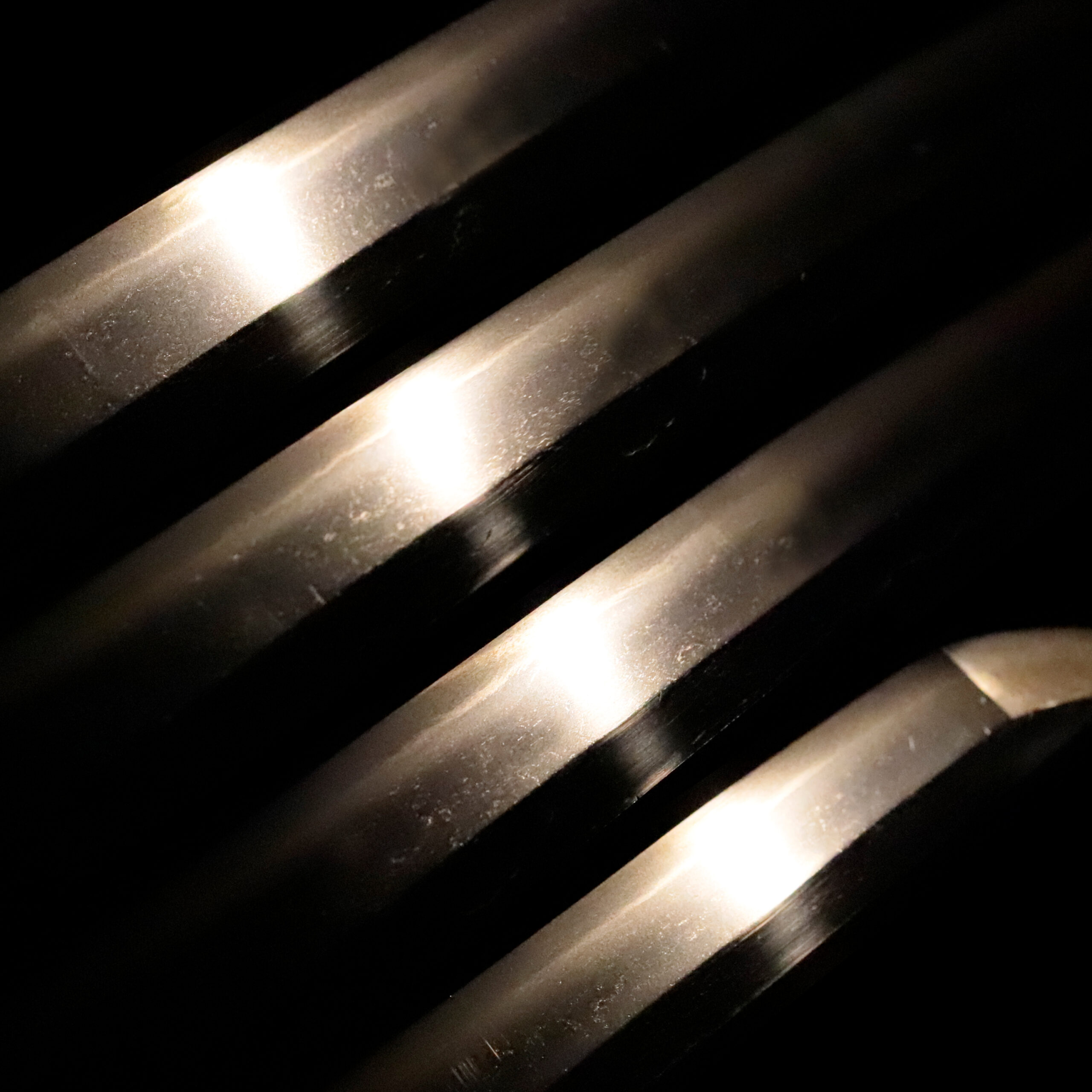
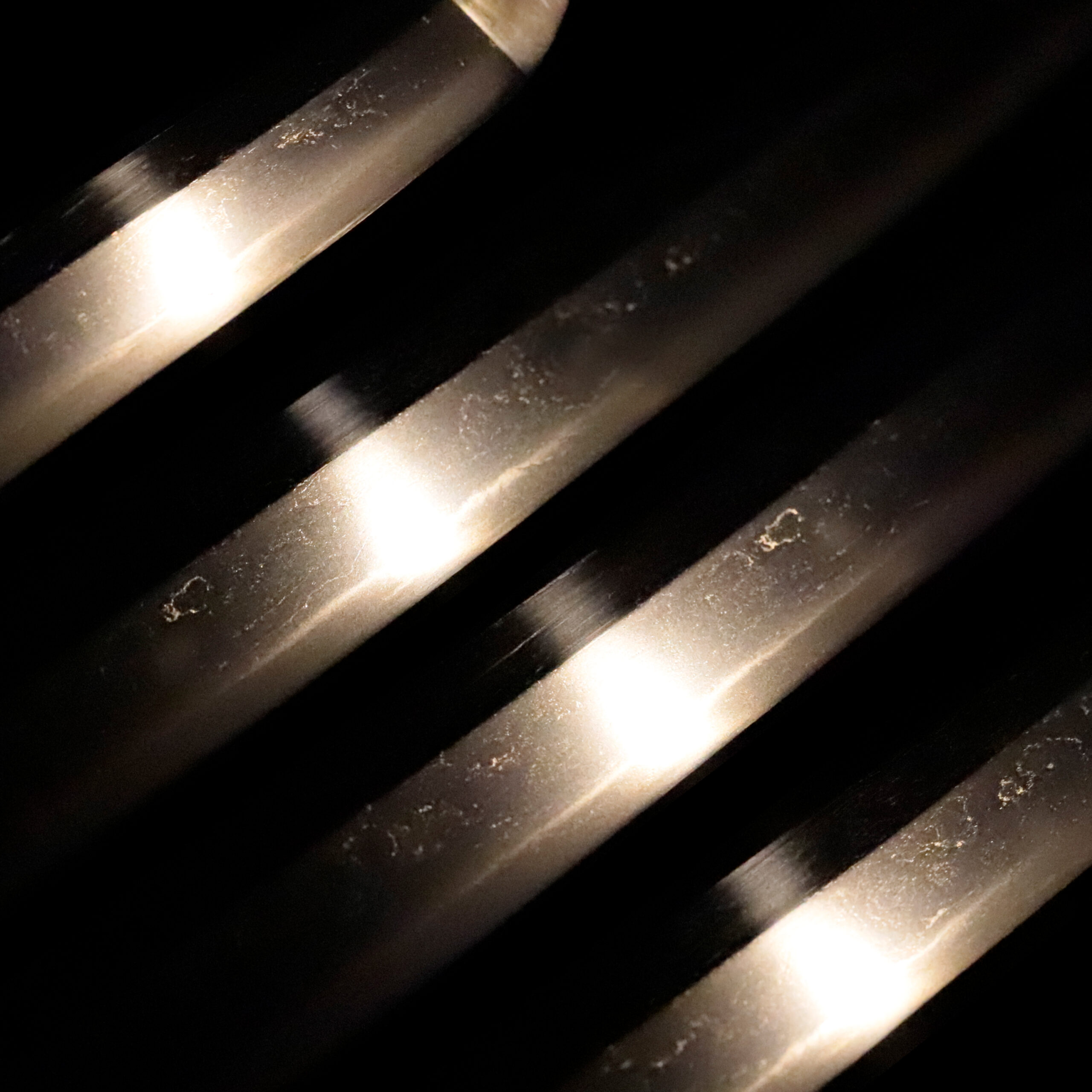
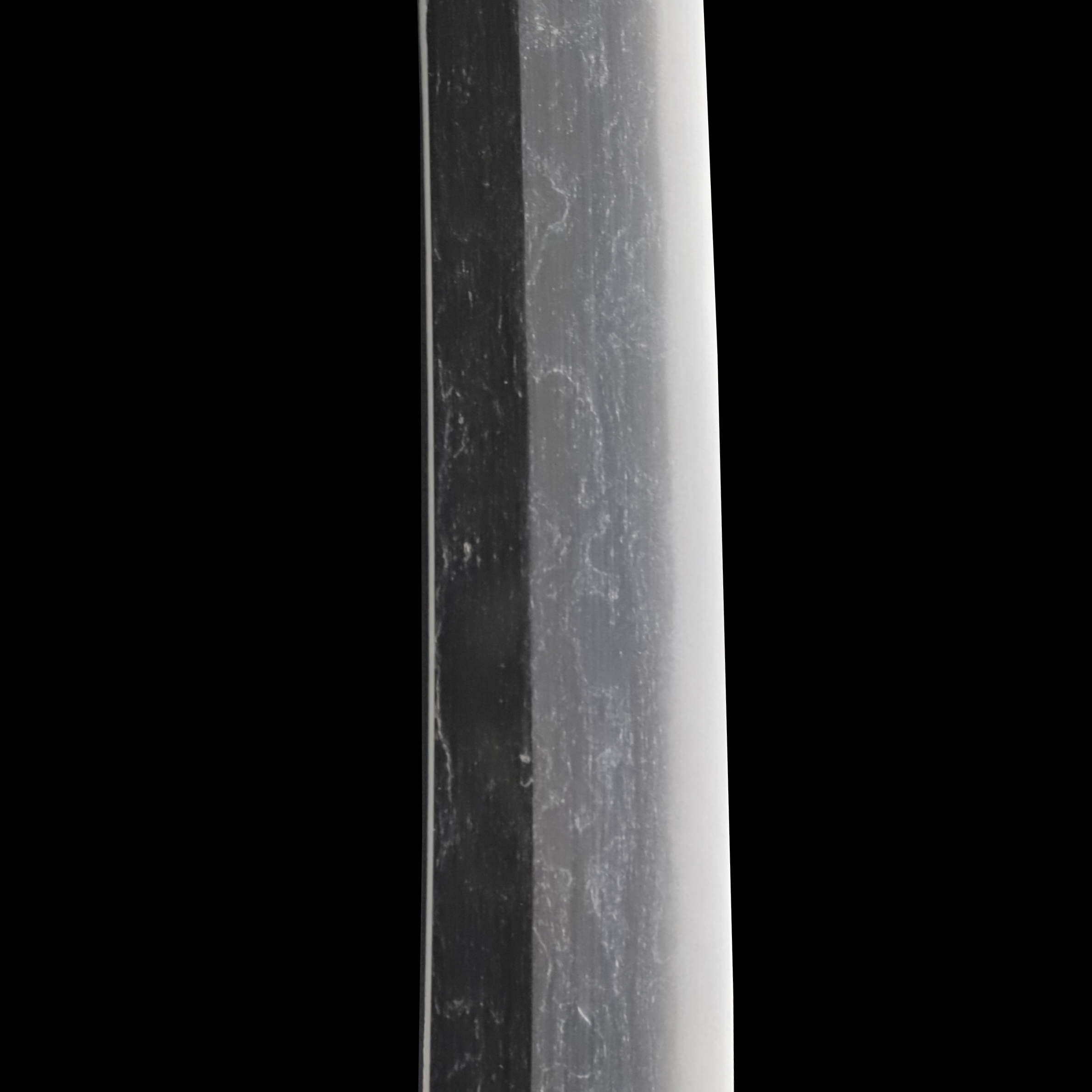
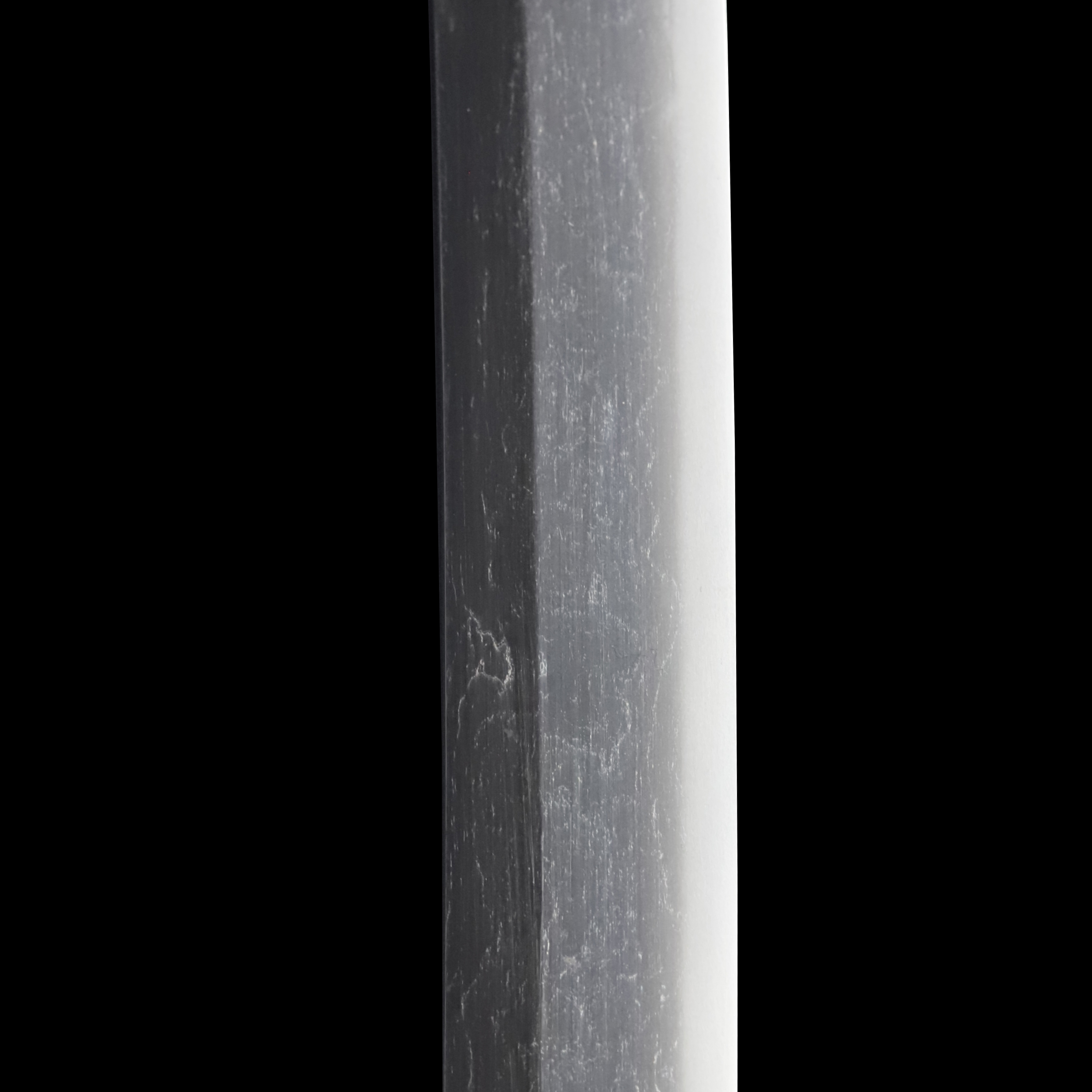
Kissaki:Kissaki is the tip of the Japanese sword.
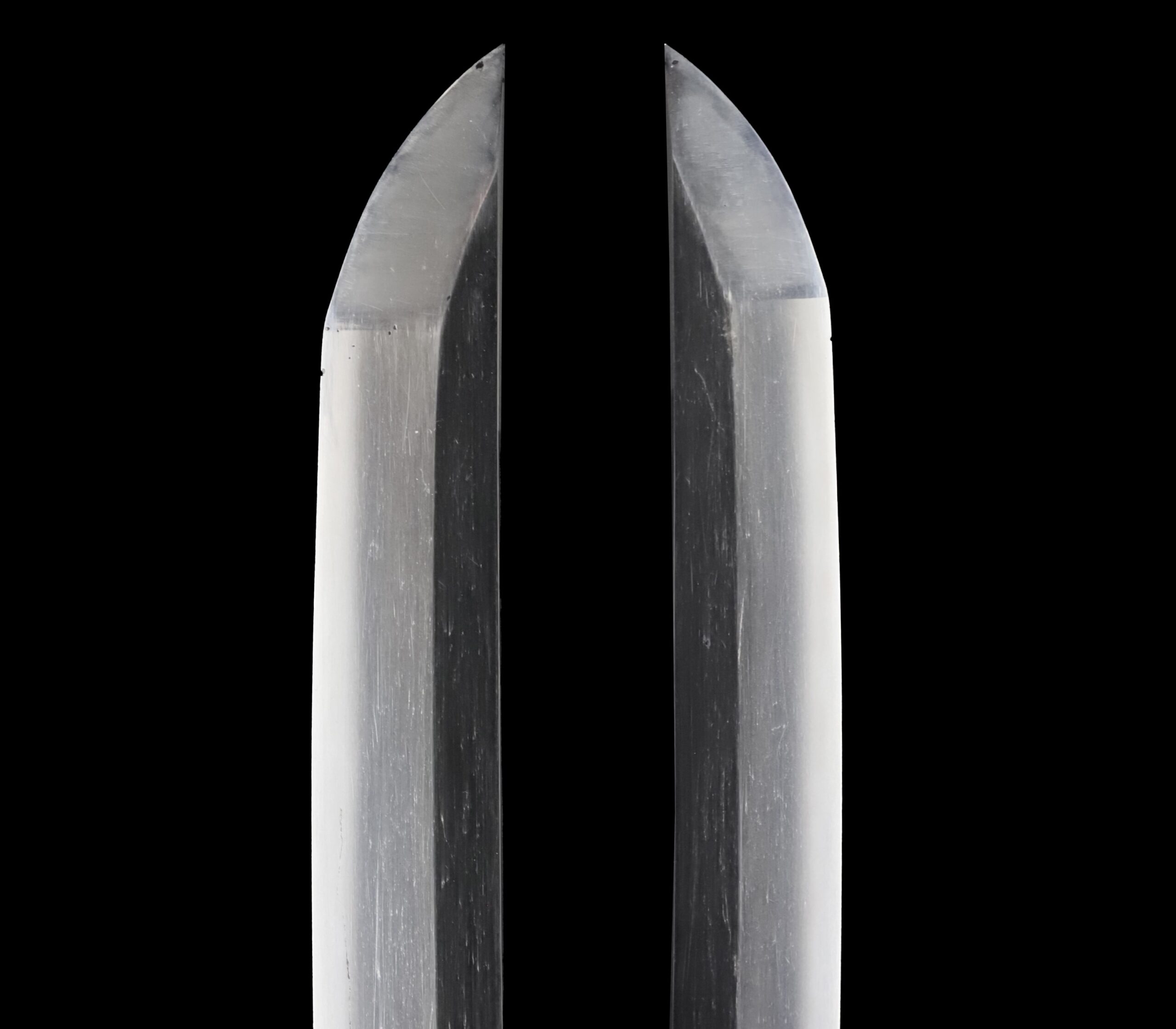
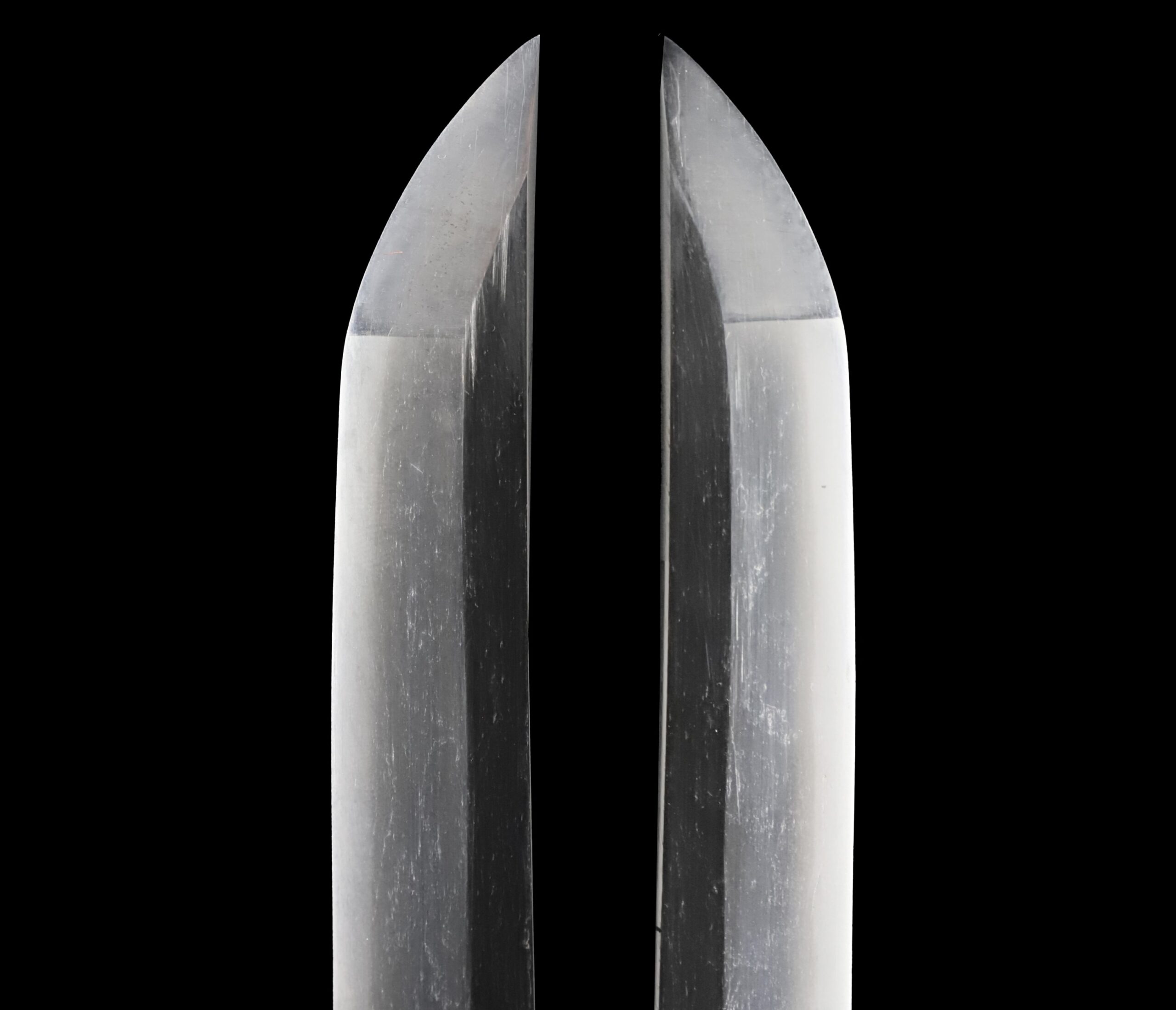
Nakago:Nakago is the tang of the Japanese sword.
Japanese swordsmiths left the black rust on the tang because it prevents red rust while the tang is in its handle. And the discoloration of the tang was created over time, and it is a great indicator for a Japanese sword specialist to estimate when the sword was forged.
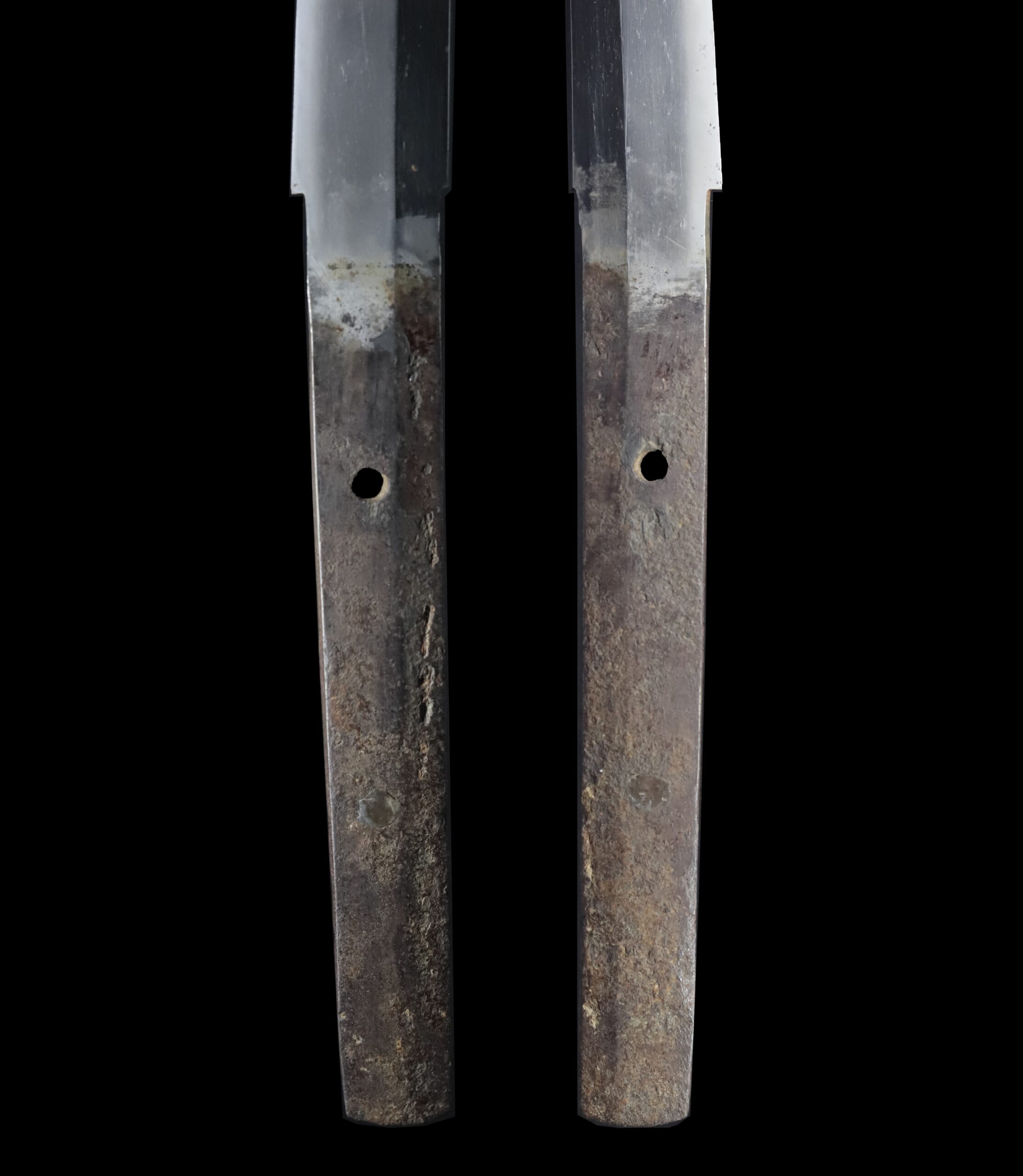
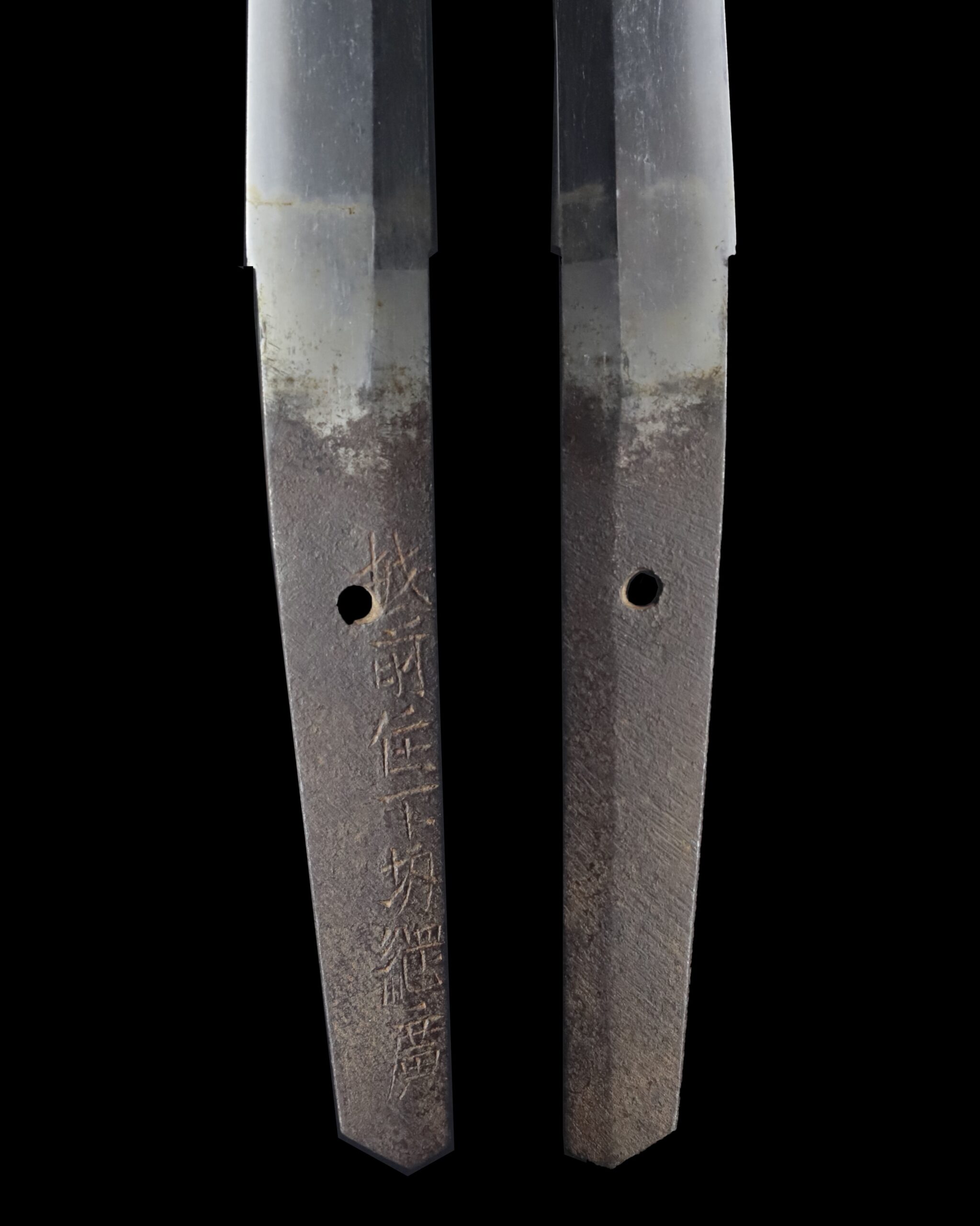
Koshirae:Koshirae is the mounting of the Japanese sword. There are several parts that consist of Koshirae such as Saya (Sabbard), Tsuka (Handle), Tsuba (Handguard).
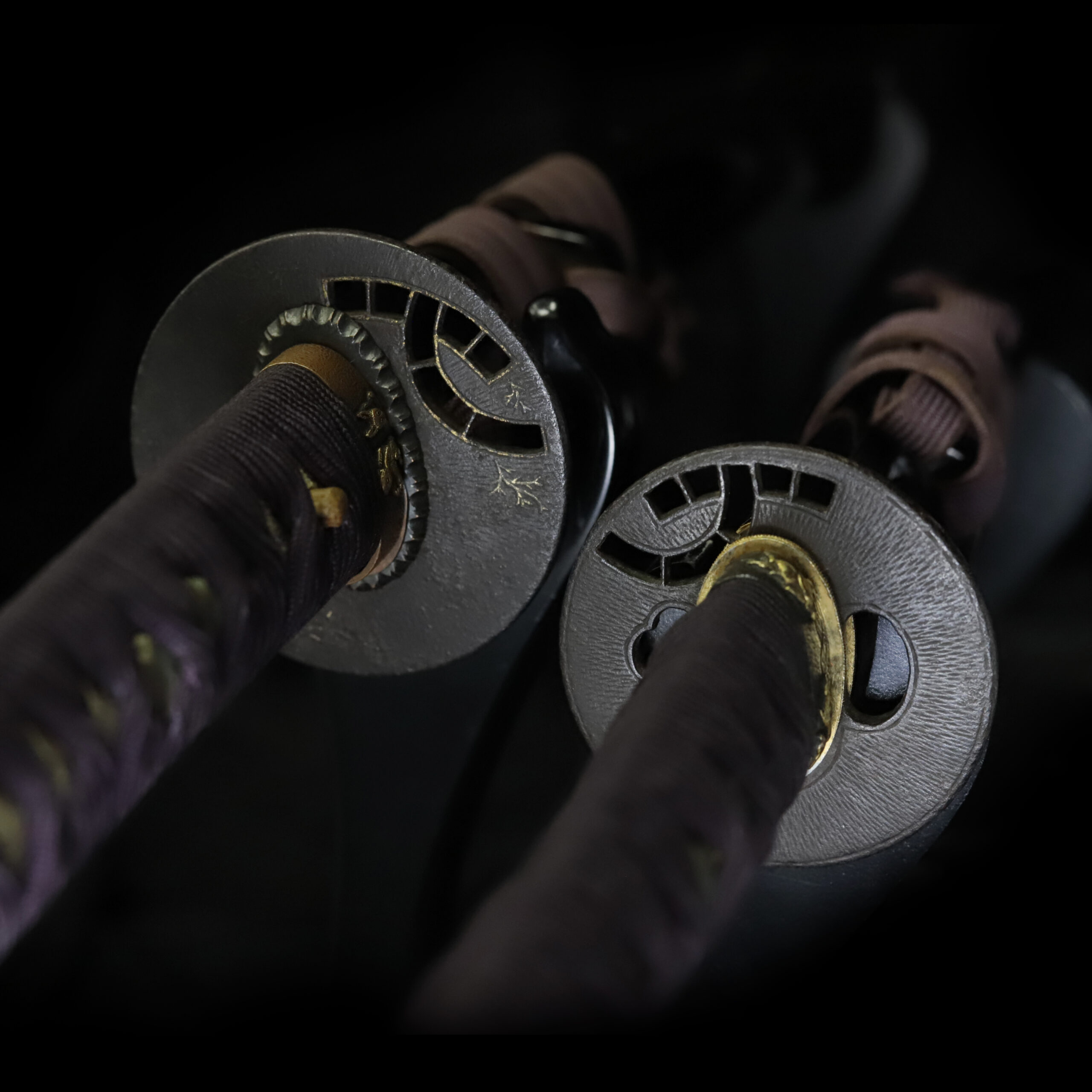
Fuchi-Kashira:A pair of matching sword fittings that cover the upper and bottom parts of its sword hilt.
These Fuchi-Kashiras feature the same auspicious animal motif — the rabbit. The Kanji for rabbit is written as “兎” (Usagi) in Japanese. Because the shape of this character resembles the Kanji “免”, meaning “to avoid,” the rabbit motif has traditionally been believed to ward off bad luck and misfortune.
In addition, the rabbit’s strong reproductive ability makes it a symbol of fertility, family prosperity, and safe childbirth. The image of a rabbit leaping forward also conveys the idea of progress, smooth success, and overcoming challenges without obstacles.
Rabbits are closely associated with the moon in Japanese folklore, as it is said that a rabbit lives on the moon pounding rice cakes (mochi). The Japanese word for moon, “Tsuki” (月), is also used in the phrase “Tsuki ga aru”, which means “to have good luck.” For this reason, the rabbit has long been regarded as a lucky and auspicious creature in Japanese culture, symbolizing vitality, good fortune, and positive progress.
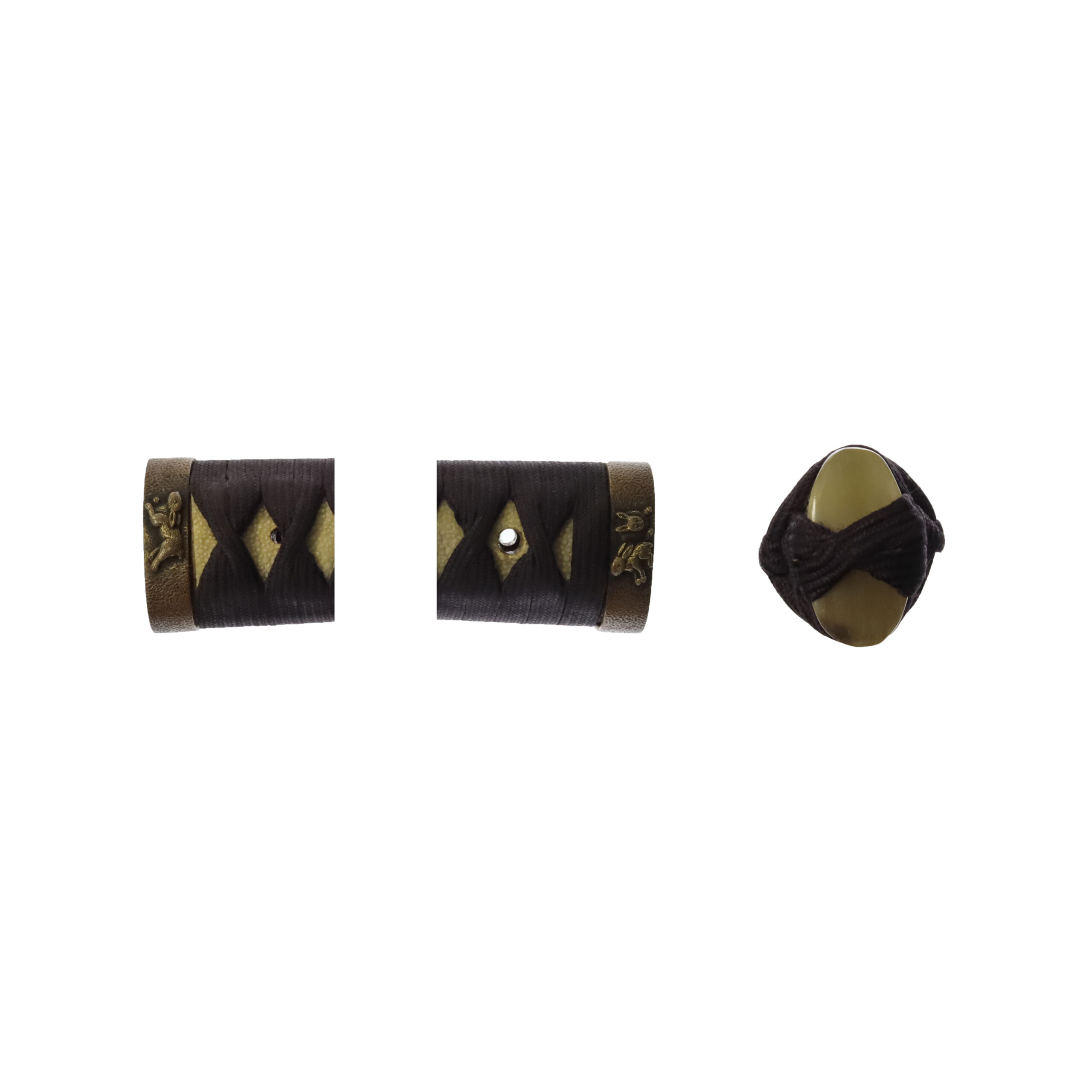
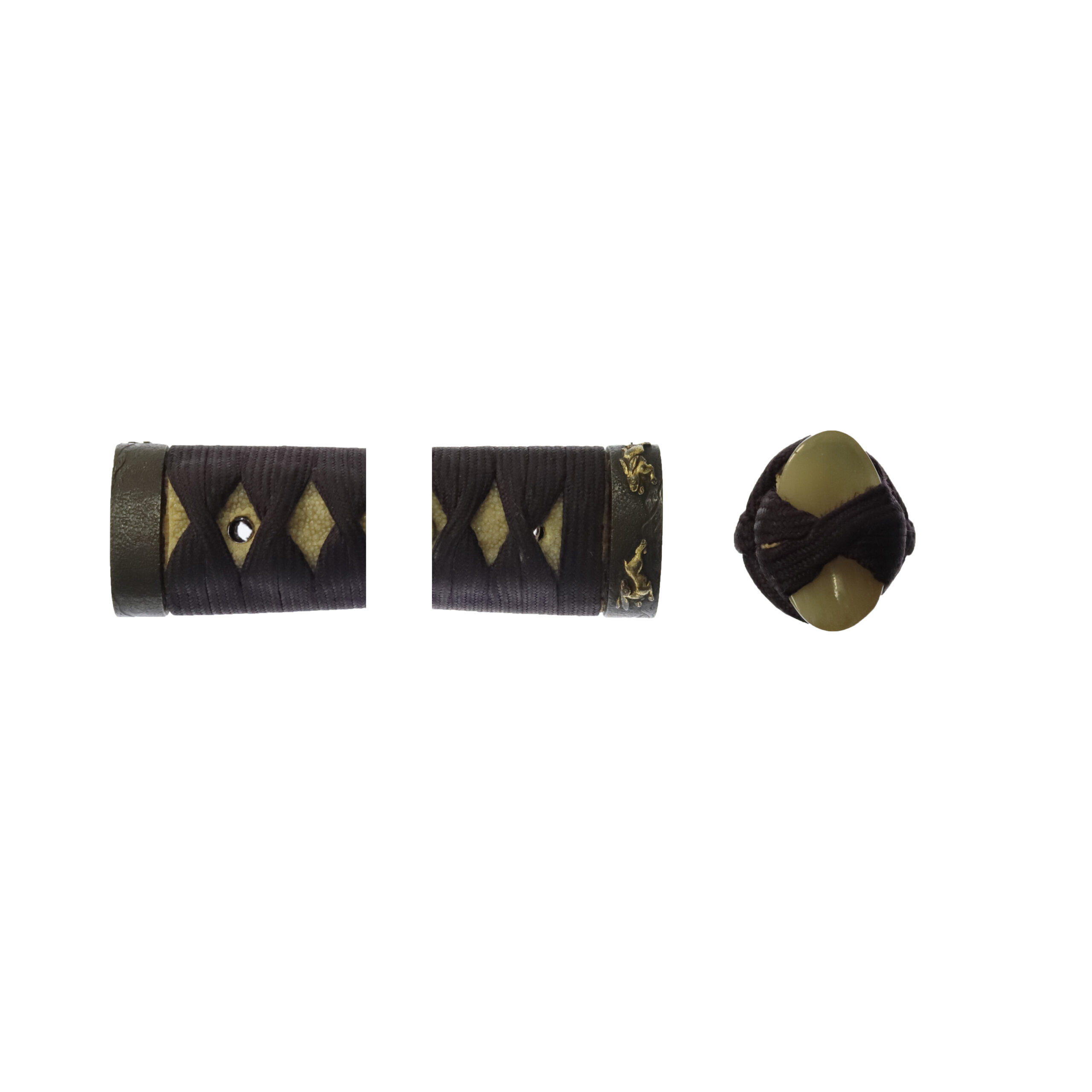
Tsuka and Menuki:Tsuka is the handle of the Japanese sword and Menuki is its decoration.
These Menuki feature the same motif — the Gosan-no-Kiri Mon (五三の桐紋), or “Paulownia Crest.” This design is based on the Kiri (桐, paulownia) pattern, one of the most well-known and esteemed traditional Japanese motifs.
The Kiri pattern typically consists of three upright inflorescences and three leaves. The number of blossoms on each stem indicates the rank or variation of the crest. Historically, the Gosan-no-Kiri Mon was used by the imperial family and high-ranking officials, and it later became the official emblem of the Japanese government. Today, it remains a symbol of authority and honor, but it is also permitted for use as a family crest by the general public.
According to ancient belief, the phoenix (Hōō, 鳳凰) — a sacred mythical bird — is said to rest only on the paulownia tree. Because of this association, the Kiri motif came to represent nobility, virtue, and divine protection, and it continues to be admired as an auspicious design in Japanese art.
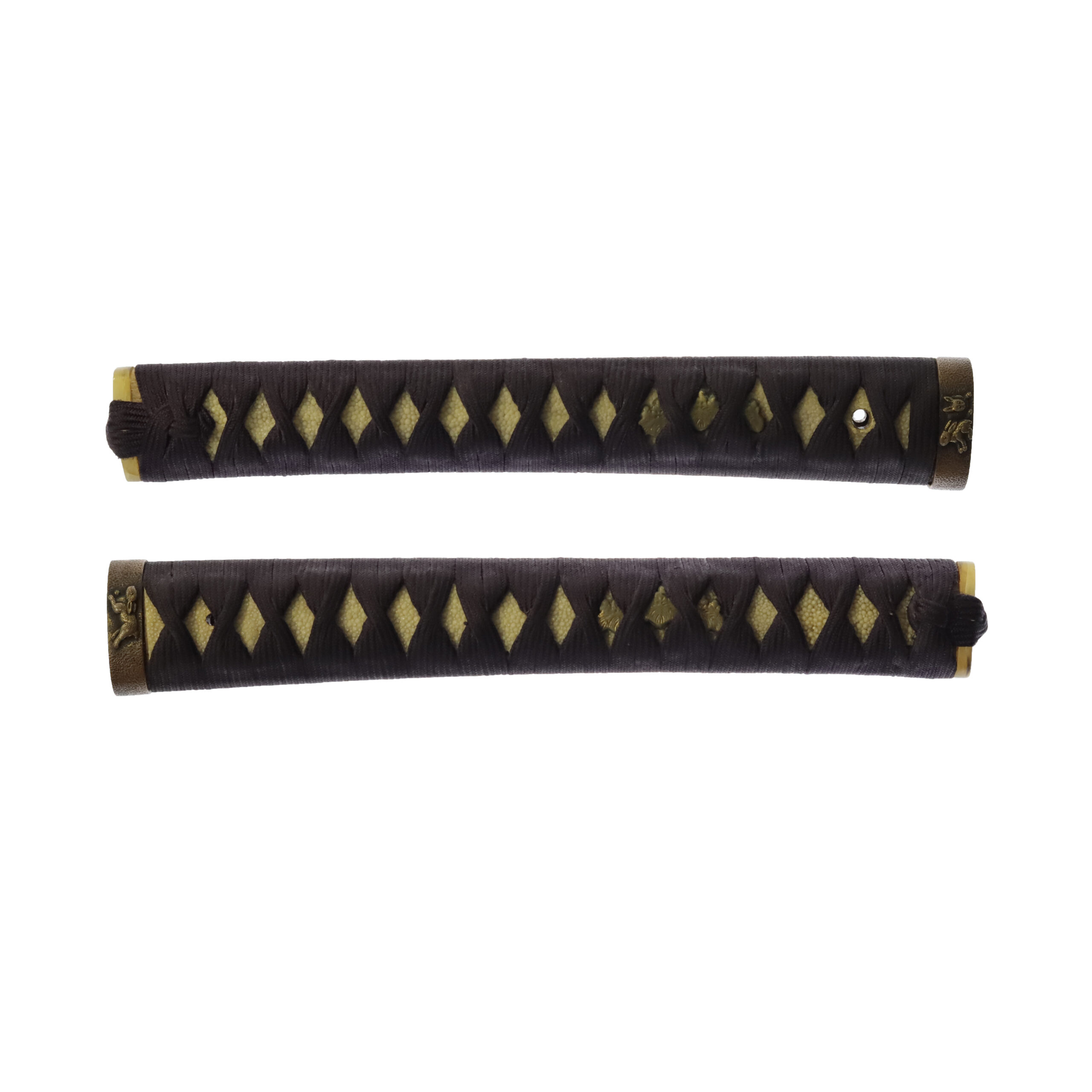
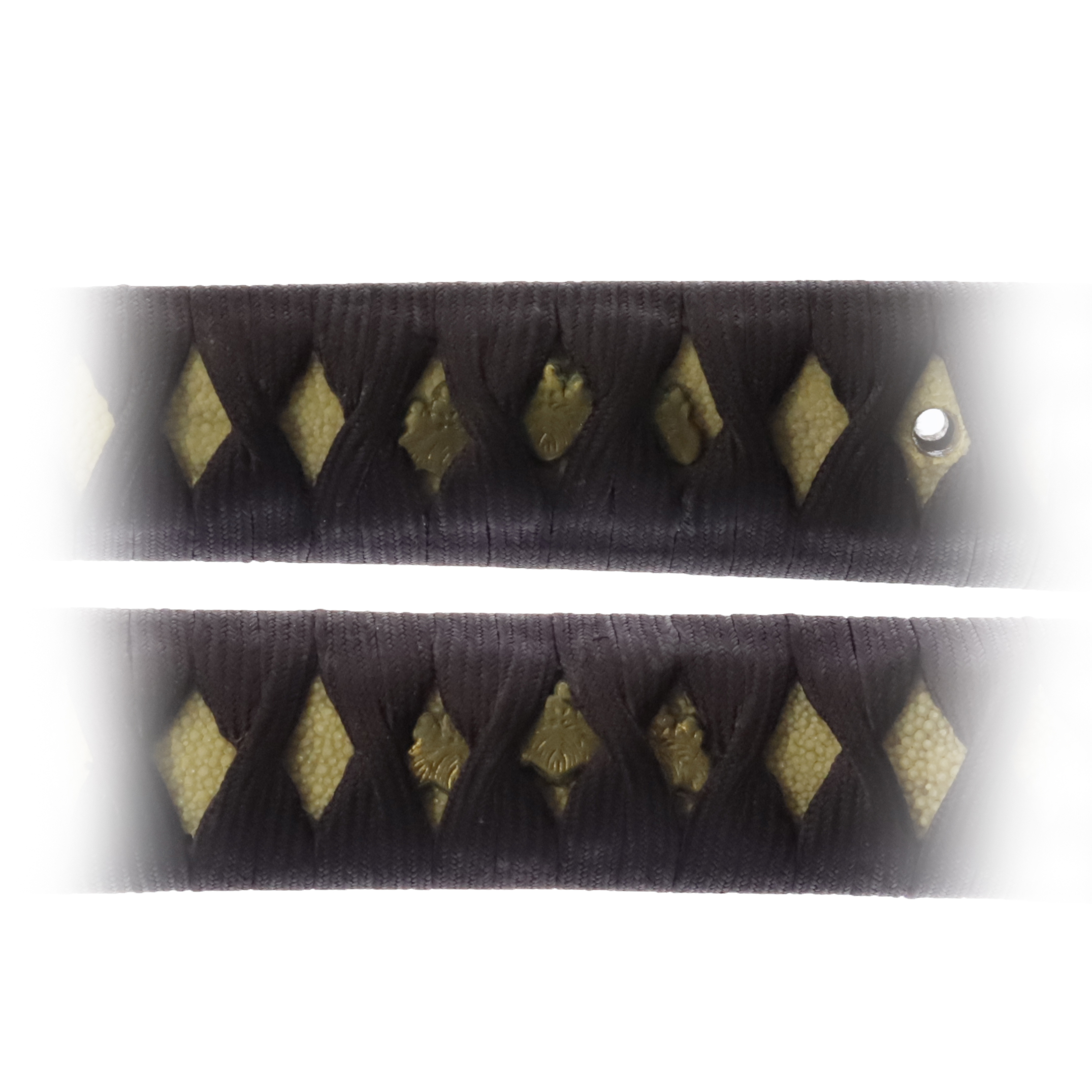
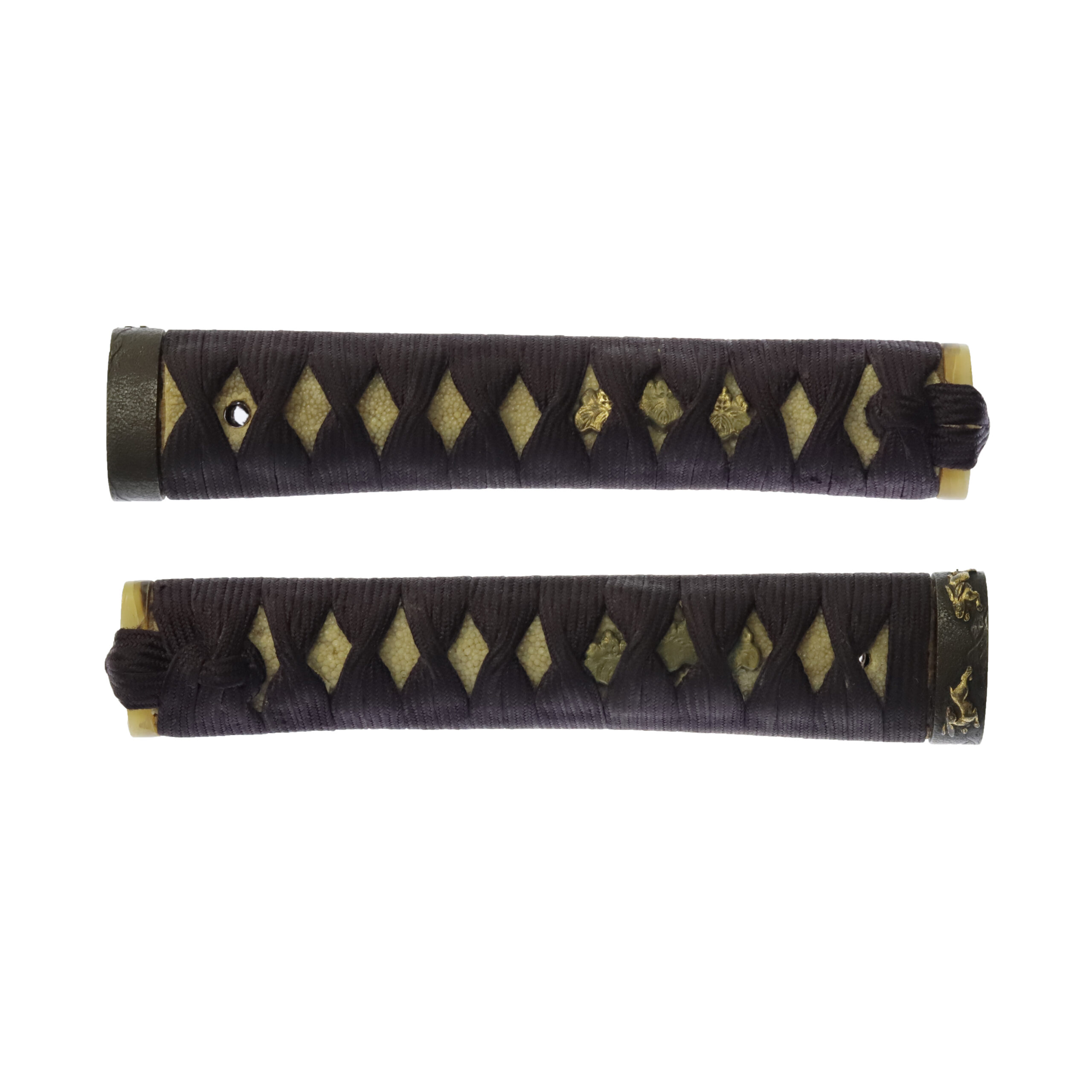
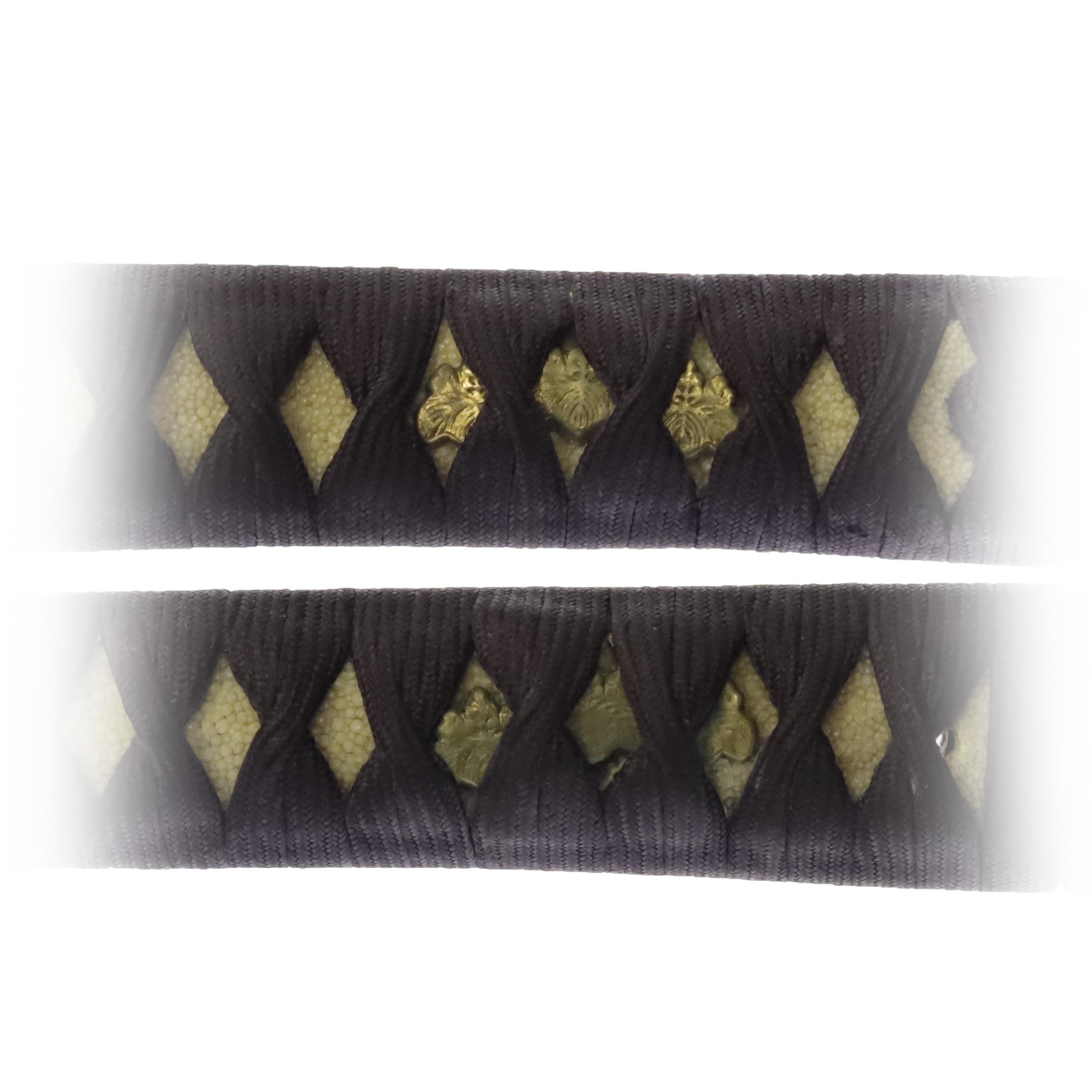
Tsuba and Habaki:Tsuba is the handguard for the Japanese Sword and Habaki is the equipment to make the blade not touch its scabbard inside. It prevents the blade from getting rusty and chipped.
These tsubas are made of iron and features a geometric sukashi-bori (透かし彫り, openwork) design, with rectangular openings arranged in a curved line along the upper section of one side. Sukashi-bori refers to a traditional Japanese metalworking technique in which parts of the metal plate are carefully cut out to create patterns or motifs, allowing light to pass through and giving the design both visual depth and a sense of balance between solid and void.
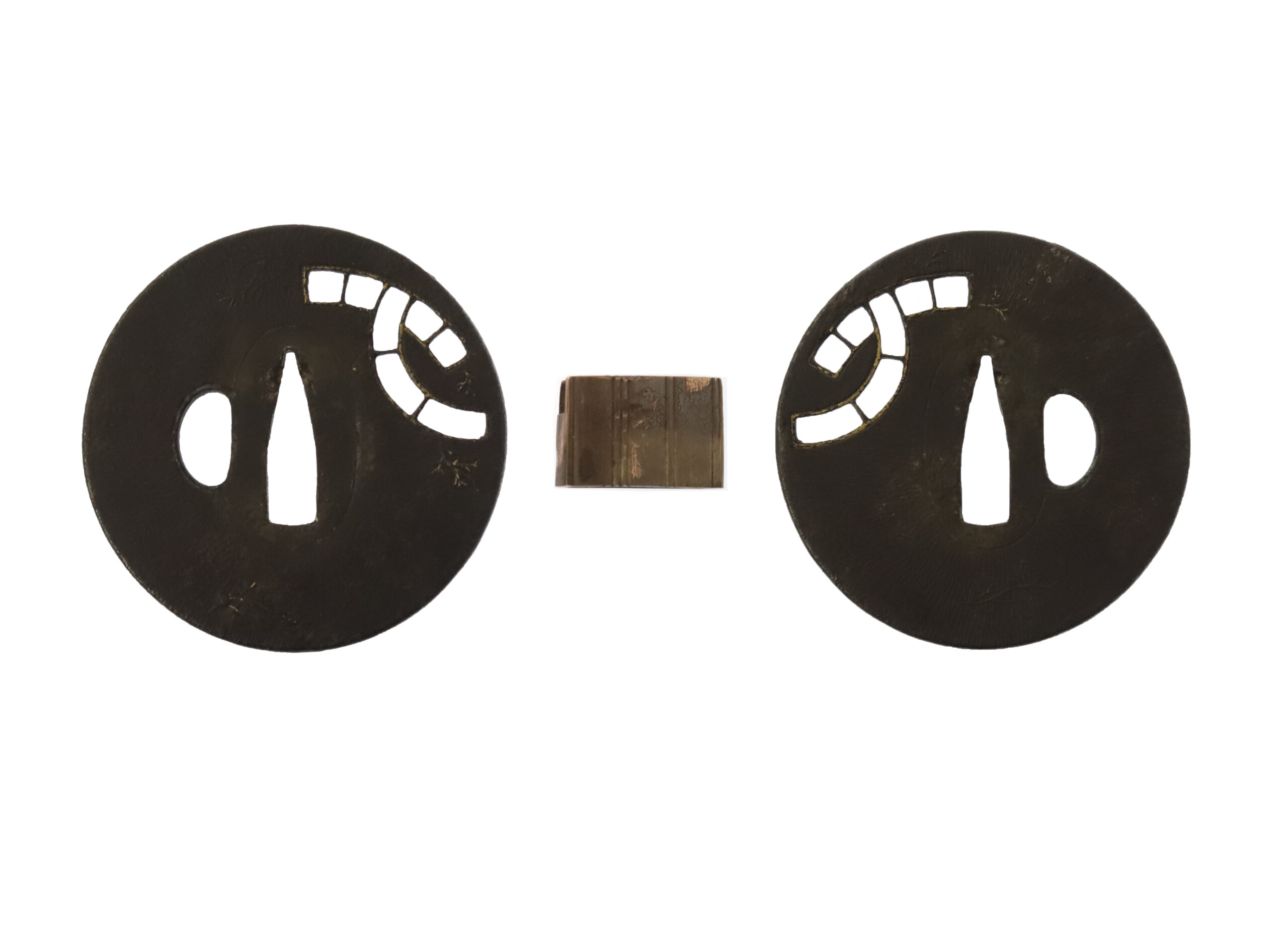
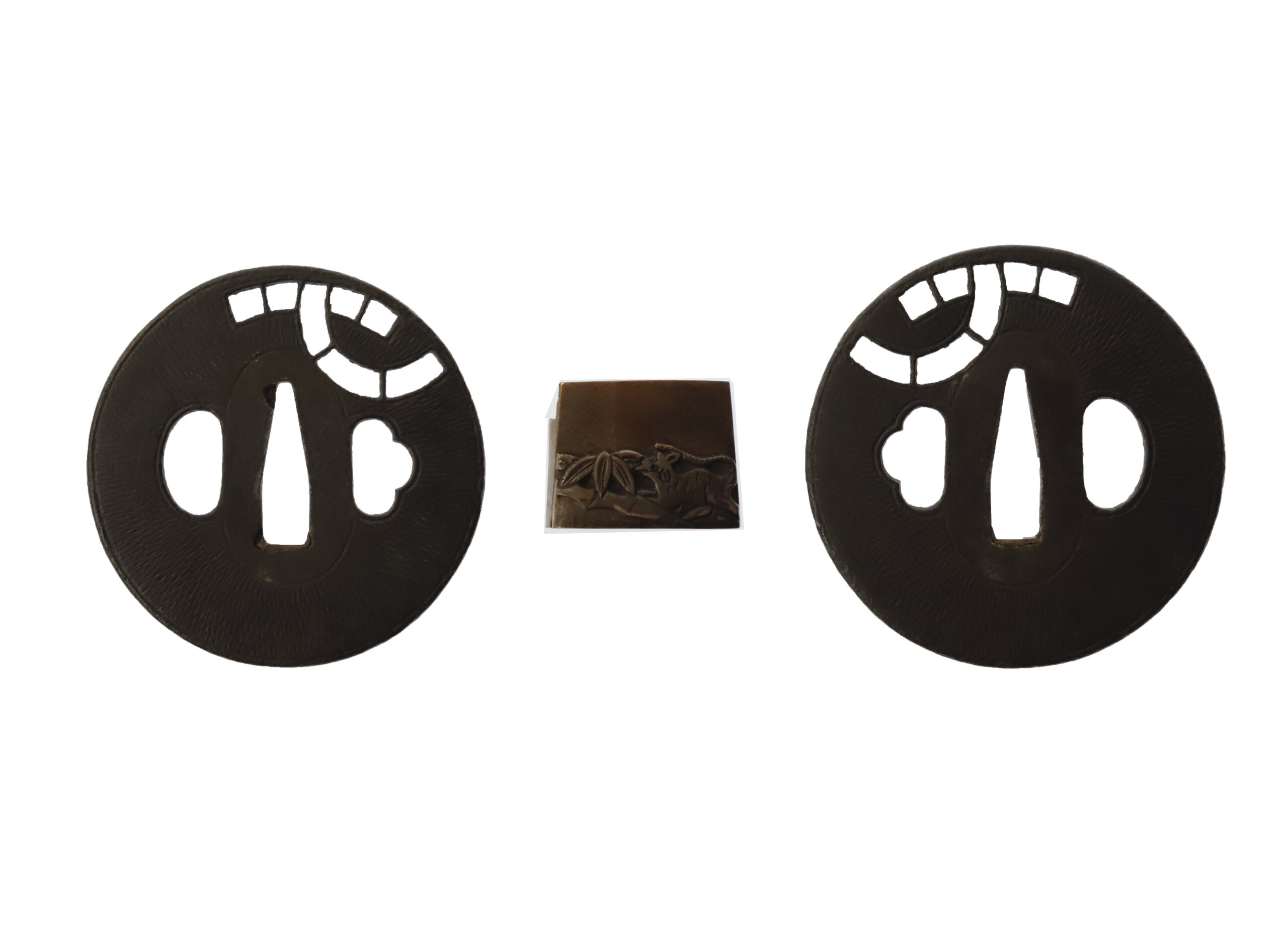
Saya:Saya is the scabbard for the Japanese sword.
These Sayas are covered with black lacquer. Due to its high waterproof effect, lacquer has been used since ancient times in Asia. The blade of a Japanese sword is made of iron, and moisture is the greatest enemy of iron. For the purpose of carrying the blade without degrading it, people devised a method of coating the scabbard with lacquer. To prevent not only moisture but also rain and snow from penetrating the inside of the scabbard, it was necessary to apply multiple layers of lacquer. The Nushi (塗師, lacquerers) was born precisely because advanced techniques were required to handle the complicated processes.
*Please keep in mind that there are some areas where lacquer came off.
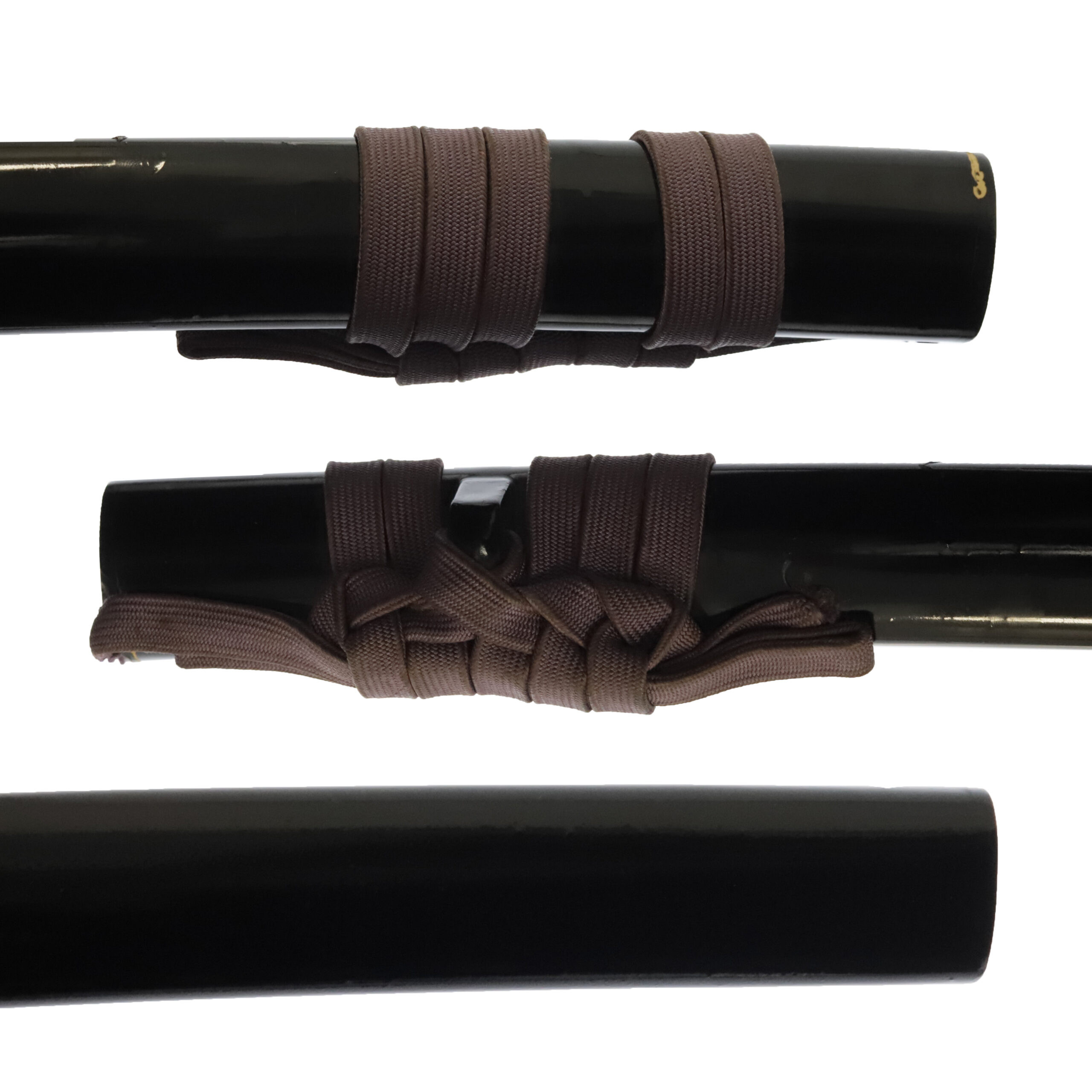
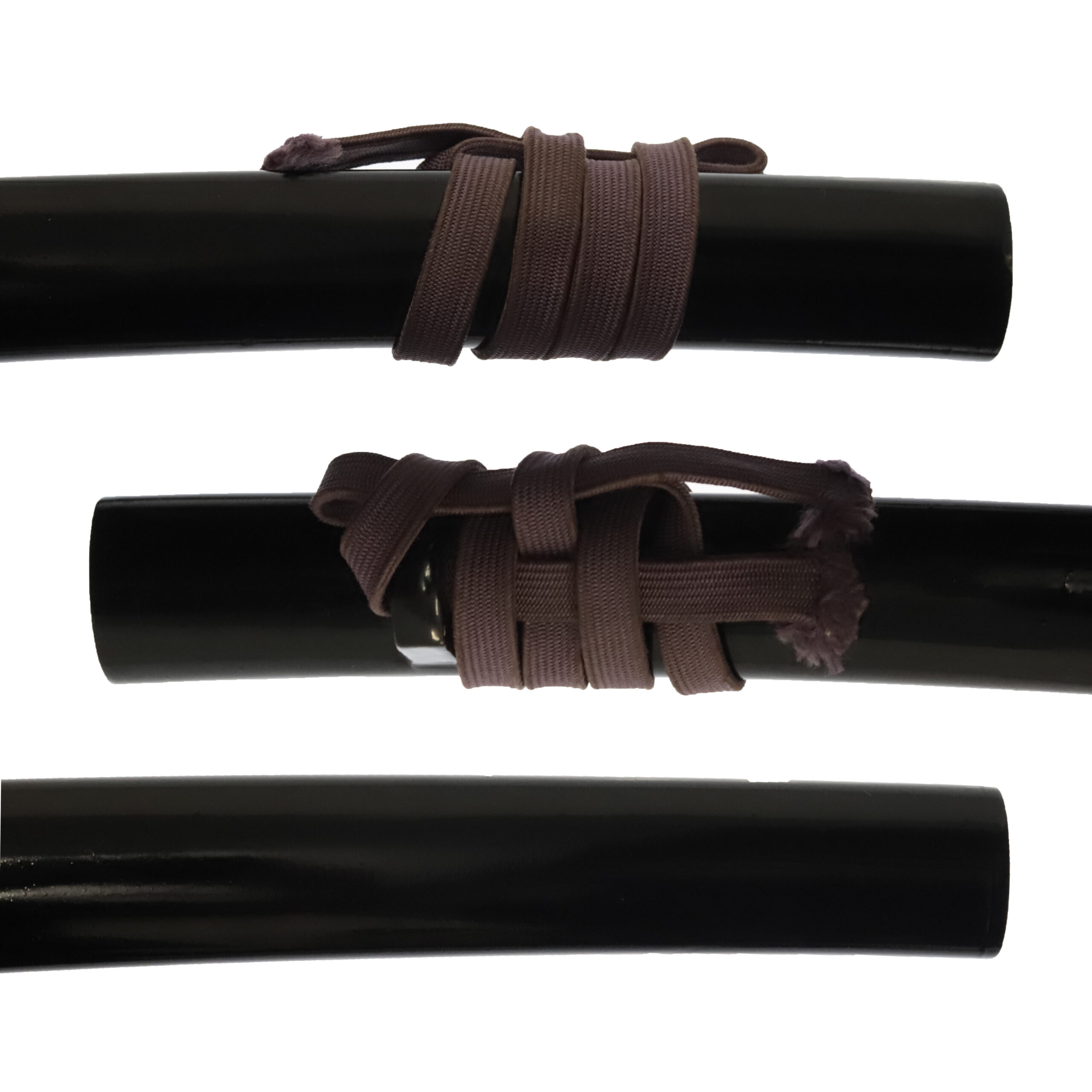
Authentication Paper:NTHK-NPO Kanteisho Certificate for Katana & Wakizashi
NTHK, also known as NPO Nihon Touken Hozon Kai, is the oldest organization for sword authentication of Japanese swords in modern times. It was established in 1910 during the post-Samurai era. Both Katana and Wakizashi were authenticated by NTHK on October 19th in 2025. The purchaser will receive these original certificates as well. We can also translate what is written into English and make a PDF file for your record if you request.
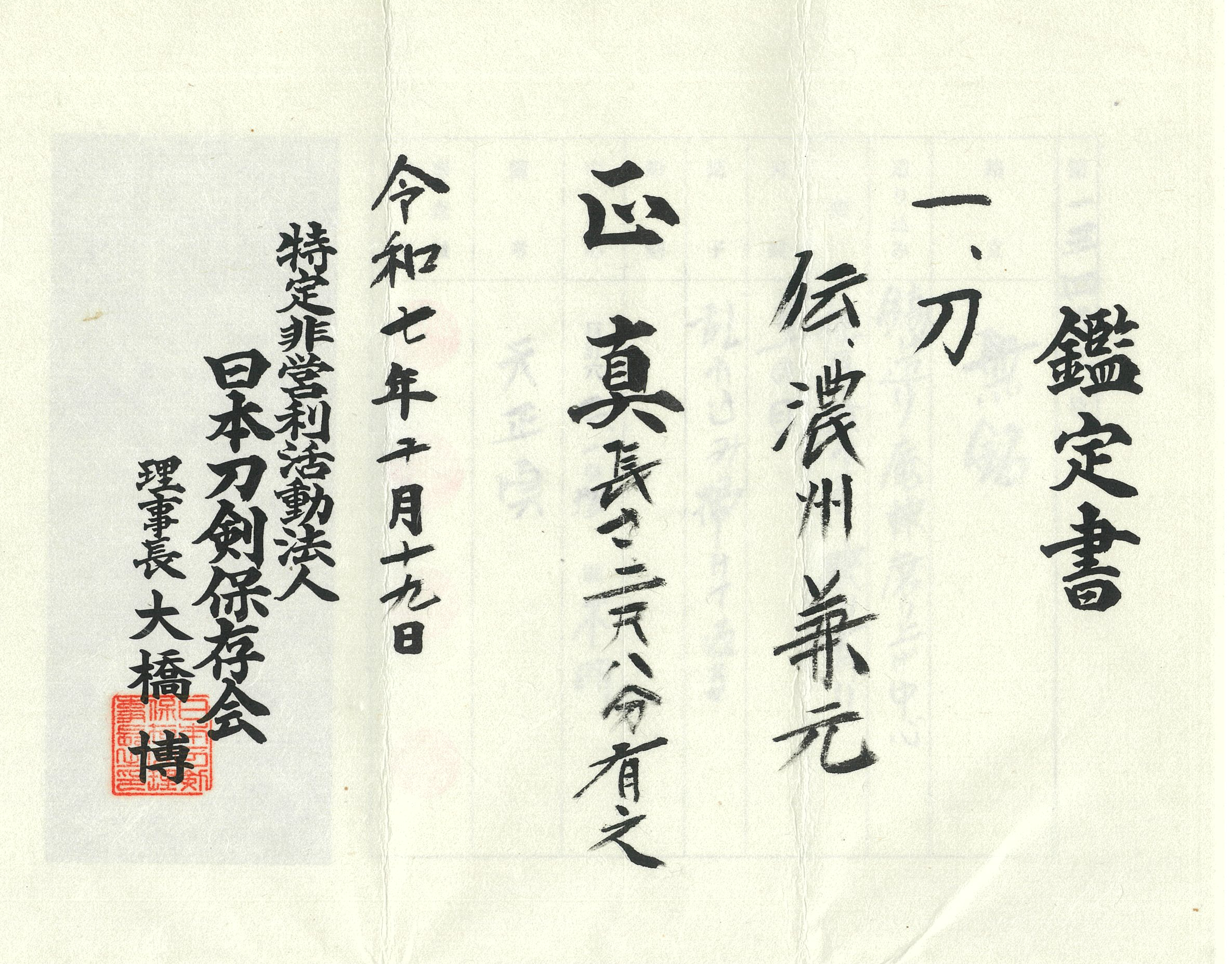
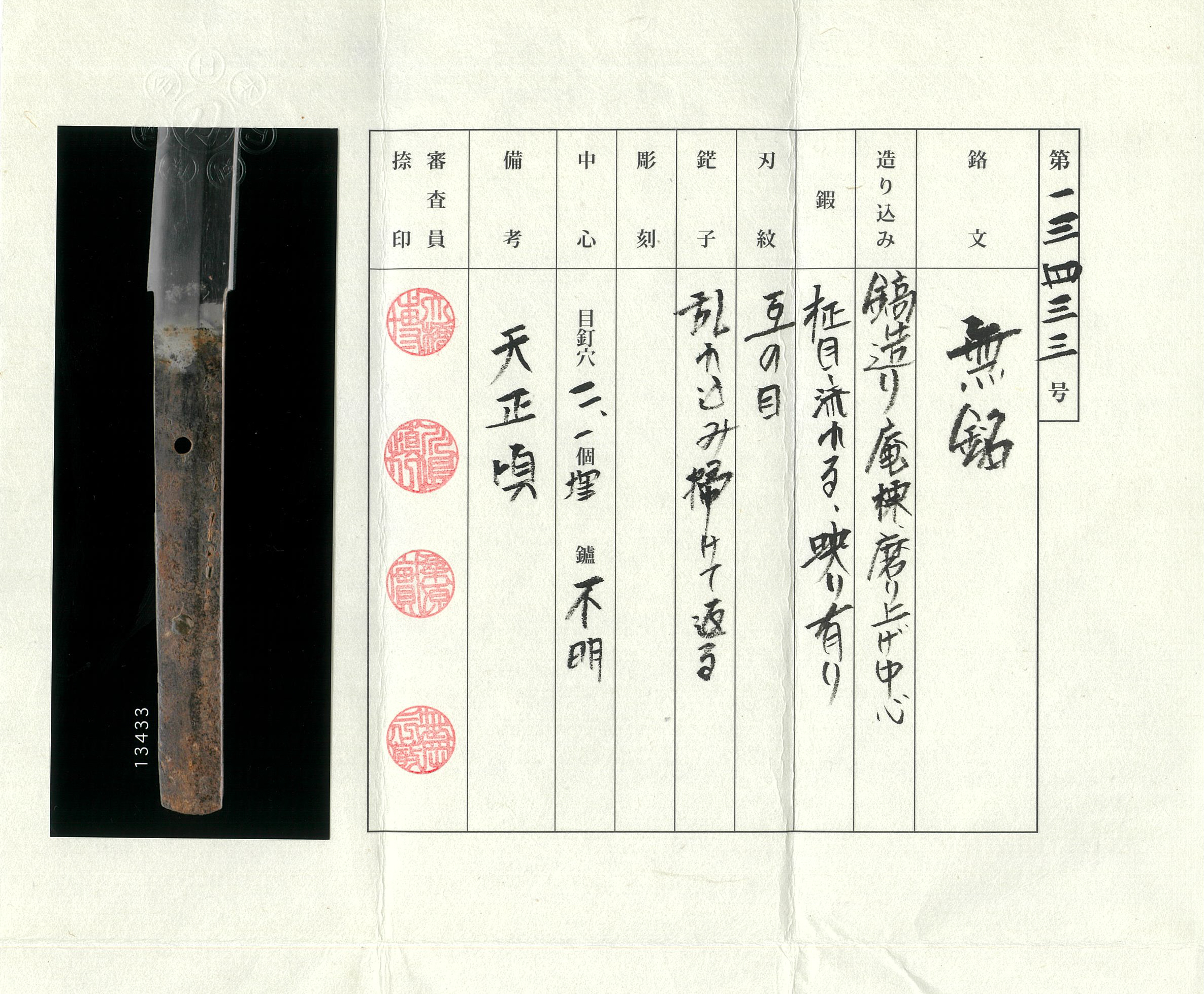
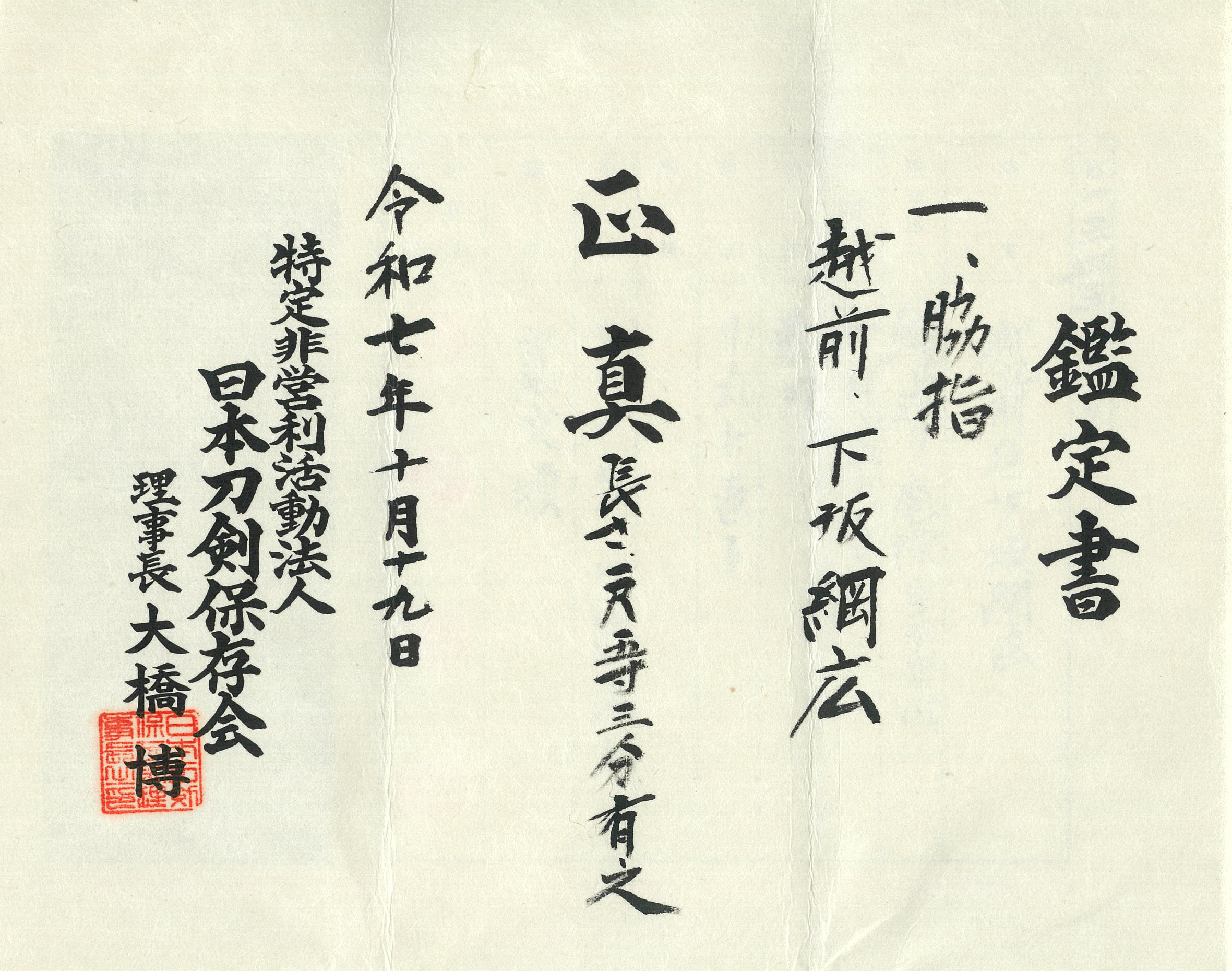
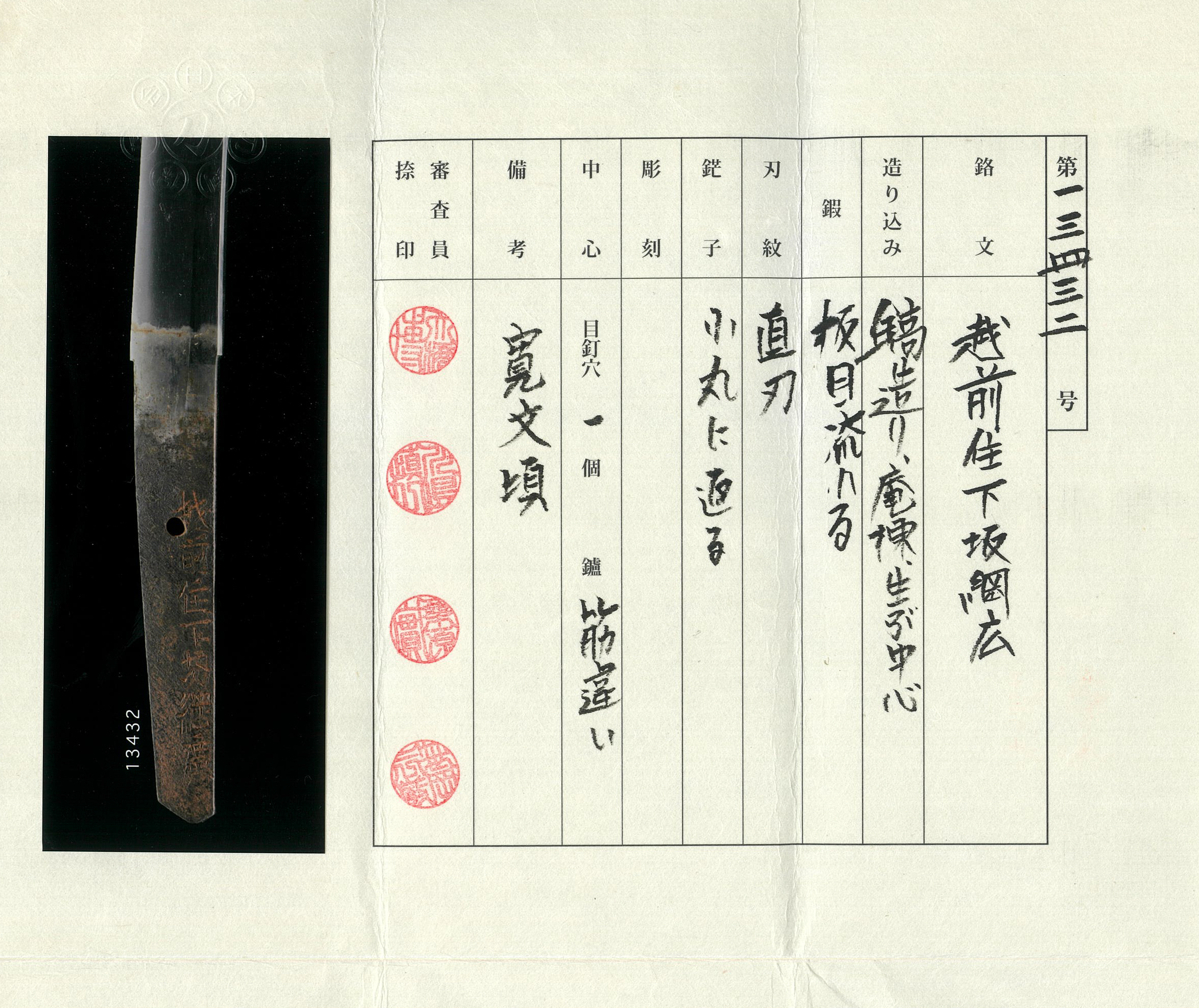
Registration Number : Shizuoka 31114-31115
The Board of Education in Shizuoka prefecture issued a registration paper for the Katana and Wakizashi blade. It is called Jyu Hou Token Rui Tourokusho (銃砲刀剣類登録証). Bunkacho (The Agency for Cultural Affairs) acknowledges a Japanese sword with this paper as a work of art.
The sword needs to be traditionally hand-forged and made of Tamahagane carbon steel to be registered in the system. With this paper, its owner in Japan can legally own an authentic Japanese sword. Based on this registration number, we will apply for its export permit.
This paper will need to be returned to the board of education when the sword is being shipped abroad, but you can receive a copy of it. An English translation of this registration paper is available on request.
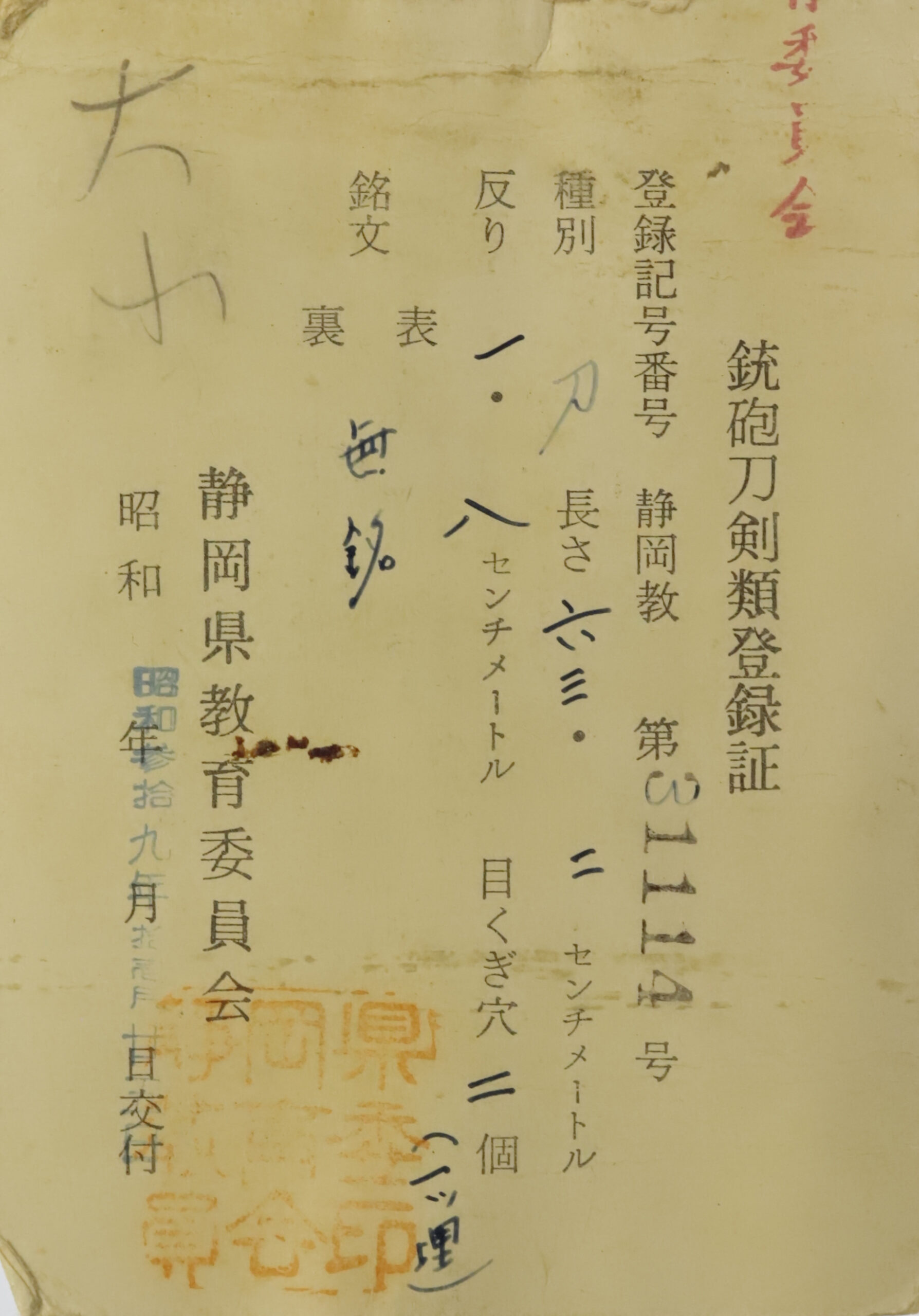
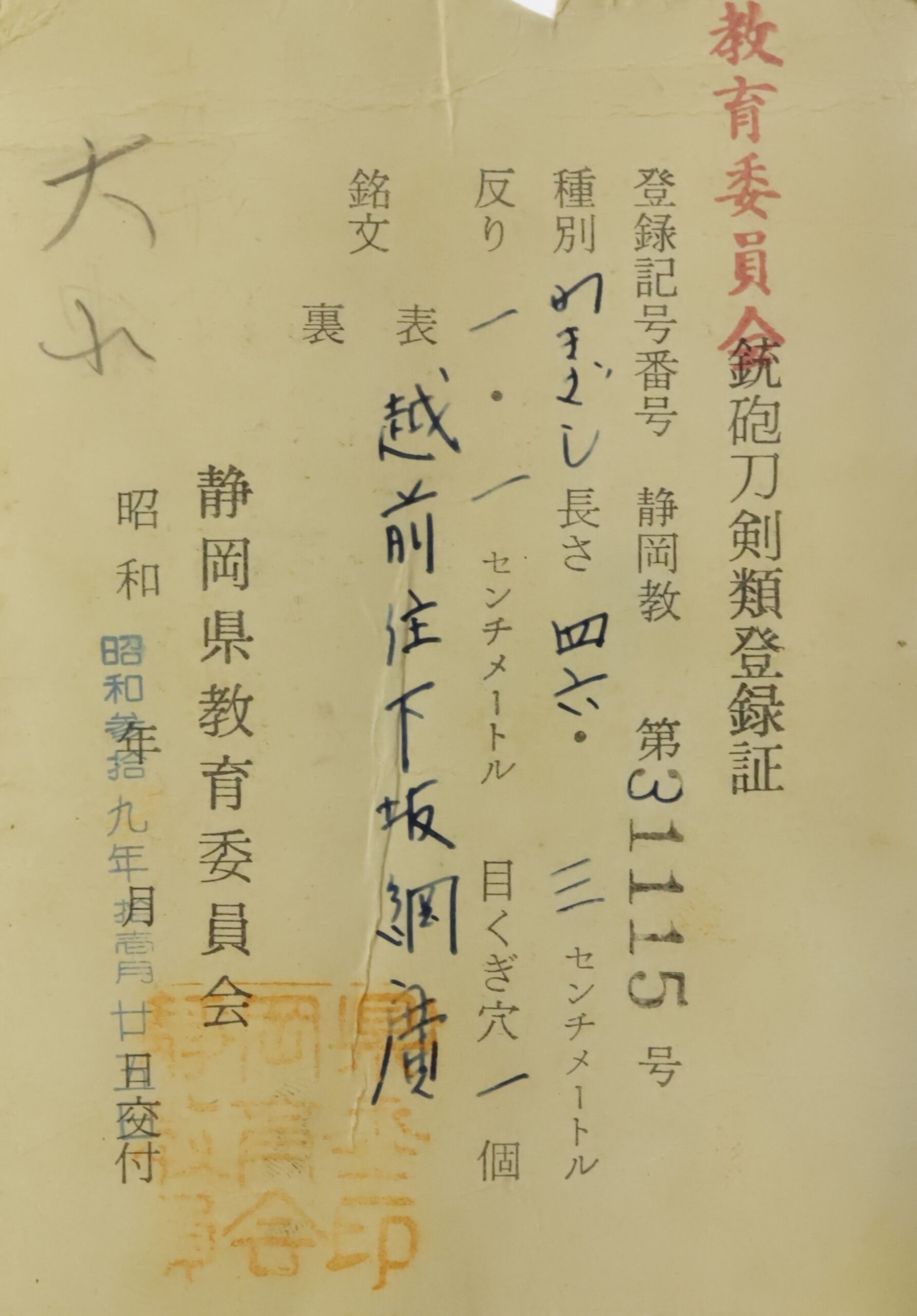
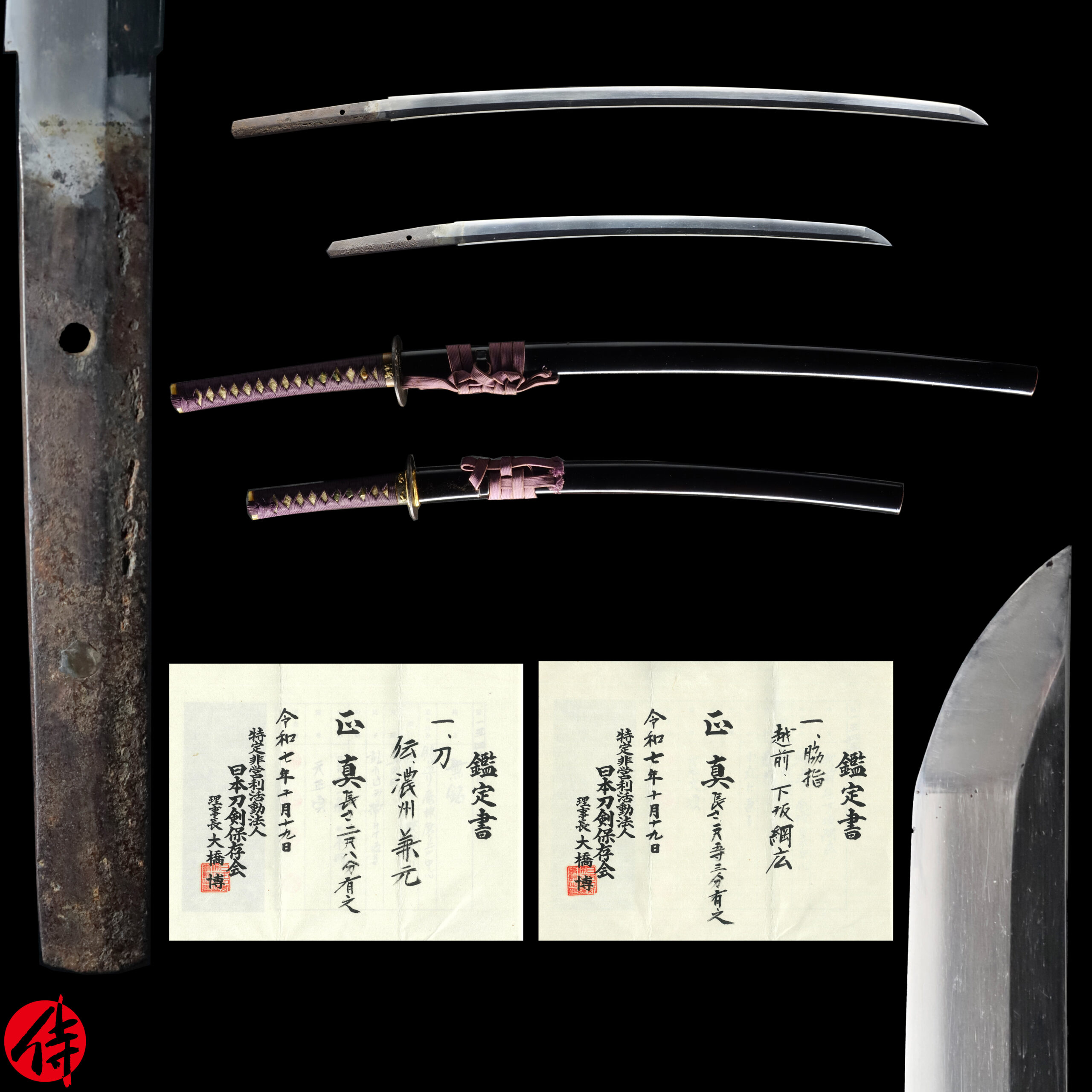
—————————————————————–
【About us】
Samurai Museum is located in Tokyo, Japan, exhibiting antique artifacts related to the Samurai history. Samurai Museum Shop is the place for those who are interested in Japanese culture and craftsmanship. We deal with antique Samurai swords/armor, traditional crafts made in Japan and so on.
【Japanese Sword& Export Process】
The Japanese swords we deal with are hand-forged edged swords made in Japan. It was made from the traditional carbon steel called TAMAHAGANE(玉鋼). Samurai Museum is familiar with the proper legal procedure for an antique/ authentic Japanese sword to be exported from Japan. We have sent more than 1000 Japanese swords for the past few years (~2025) to amazing owners who appreciate its historical value.
Each Japanese sword is registered under the Agency for Cultural Affairs and the Board of Education in Japan. They issue a registration paper for each Japanese sword for its owner in Japan to legally possess it. The Japanese sword with its registration paper means it was traditionally hand-forged in Japan.
To legally export the sword from Japan to other countries, we will have to apply for its permit to the Agency for Cultural Affairs(Bunkacho) and return the original registration paper to the Board of Education. It normally takes around 2-4 weeks to receive this permit after submitting required documents. And we would like you to expect at least 1-1.5 months for your order to arrive at your given address after you ordered. For more detailed info, please click here.
It is allowed for residents in Japan to own authentic Japanese swords without a special license as long as they come with registration papers. Please feel free to contact us if you are a resident of Japan, whether temporarily or permanently. We will also assist you when you leave Japan and need to obtain the export permit.
【Payment Method】
We accept payment through Stripe (Credit card), PayPal, Apple Pay or ChromePay, all of which are secure payment methods. Also, you don’t need to make an account on Stripe for the checkout. If you prefer other payment method, please contact us. After confirming your payment, we will apply for an export permit. You may either pay in JPY, USD, AUD, CAD,EUR CHF or GBP. The price is set in Japanese Yen. Prices in other currencies are automatically calculated based on the latest exchange rate.

* If the amount is above 1 million JPY, Stripe or wire transfer will be the only options for payment.
【Shipping】
We have shipped authentic Japanese swords to the USA, Canada, Mexico, Germany , Belgium, France, Finland, Hong Kong, Australia. If you don’t live in these countries and like to order, please contact us first before making a purchase. We offer Free International Shipping as long as we can send antique Japanese swords by EMS.
We normally ship by EMS(Express Mail Service) provided by Japan Post. We will send you a tracking number for your order as soon as we hand it to the post office. We will put 100 % insurance on the shipping document without any extra charge. Based on the total amount, there might be a duty tax or other fee for you to pay, depending on the countries. We use package cushioning to protect the item and put it in a PVC pipe, which is one of the most secure packages because of its durability.
It will normally takes 5-14 days for the item to arrive at your given address after we dispatch it. Time of delivery is estimated as accurately as possible by the carrier but does not take into account any delays beyond our control such as by inclement weather, post office holiday seasons.
* If you live in Australia and like to purchase an authentic Japanese sword, please click here to know the detail.
* If you live in the UK and like to purchase an authentic Japanese sword, please contact us first and click here to know the detail.

【Review】
Here is one of the reviews we received from a customer who purchased an authentic Japanese sword from us. For more reviews, please click here.
“My experience overall with the whole process was wonderful. I had many questions about the history and process to purchase these treasures. All my questions were answered very timely and complete. The staff is very knowledgeable and very well versed if any questions do arise.”
【How to make sure the condition】
Please keep in mind that what you are going to purchase is an antique item. We uploaded high resolution photos for you to check its condition thoroughly. If you like to see more photos with different angles, please feel free to contact us. We will be happy to send them to you so that you can make informed decision. It is essential for us to know that you are happy with your choice of a sword. and we are prepared to use the best of our ability to serve you.
【How To Contact Us】
Please contact us through email, Facebook Messenger or Live Chat if you have any questions. You can find each icon on the right side of the website. Please click one of them to reach us. We will reply to you within 1-2 business days.
【The Art of Nihonto (Japanese Sword)】
Samurai’s history is a profound, eloquent legacy of ancient Japanese warriors in which millions of people worldwide are being fascinated. If you like to find out the art of Nihonto, please click here.
【A Guide to Japanese Sword Maintenance】
After acquiring an genuine Japanese sword, it is also important to know how to take good care of it. Here is the special video for you. Mr. Paul Martin, Japanese sword expert, shows you how to give proper maintenance to your sword. By mastering how to clean the Japanese sword, its aesthetic beauty will last forever.
When you purchase a Japanese sword from us, you can get a Free Japanese sword maintenance kit. It comes with four tools(Choji Oil, Uchiko Whetstone Powder, Peg remover, Oil Applicator). By watching the video instruction above , you can enjoy learning how to maintain your Japanese sword while appreciating it. If you have any difficulty assembling the sword or cleaning the blade, you can feel free to contact us.
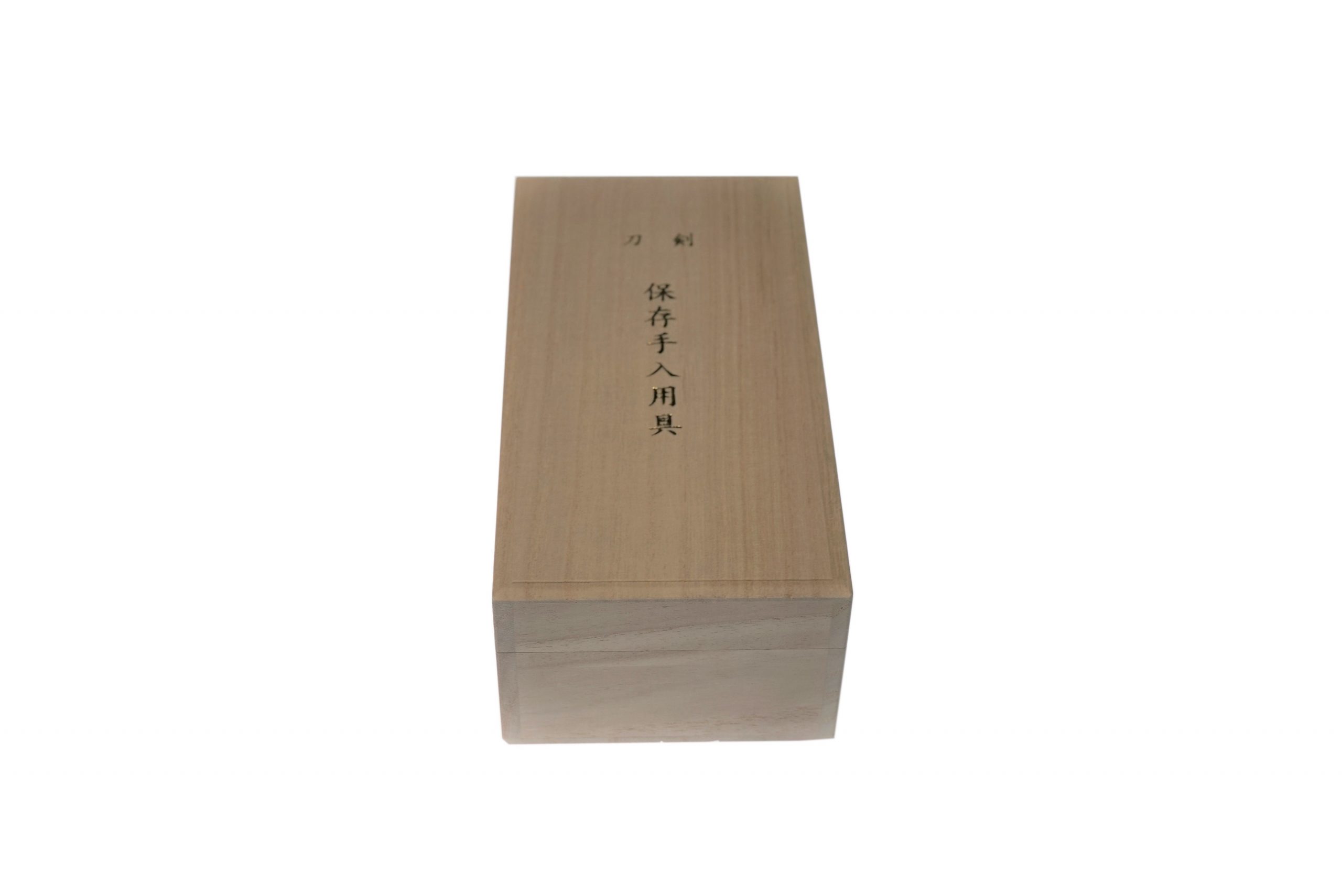
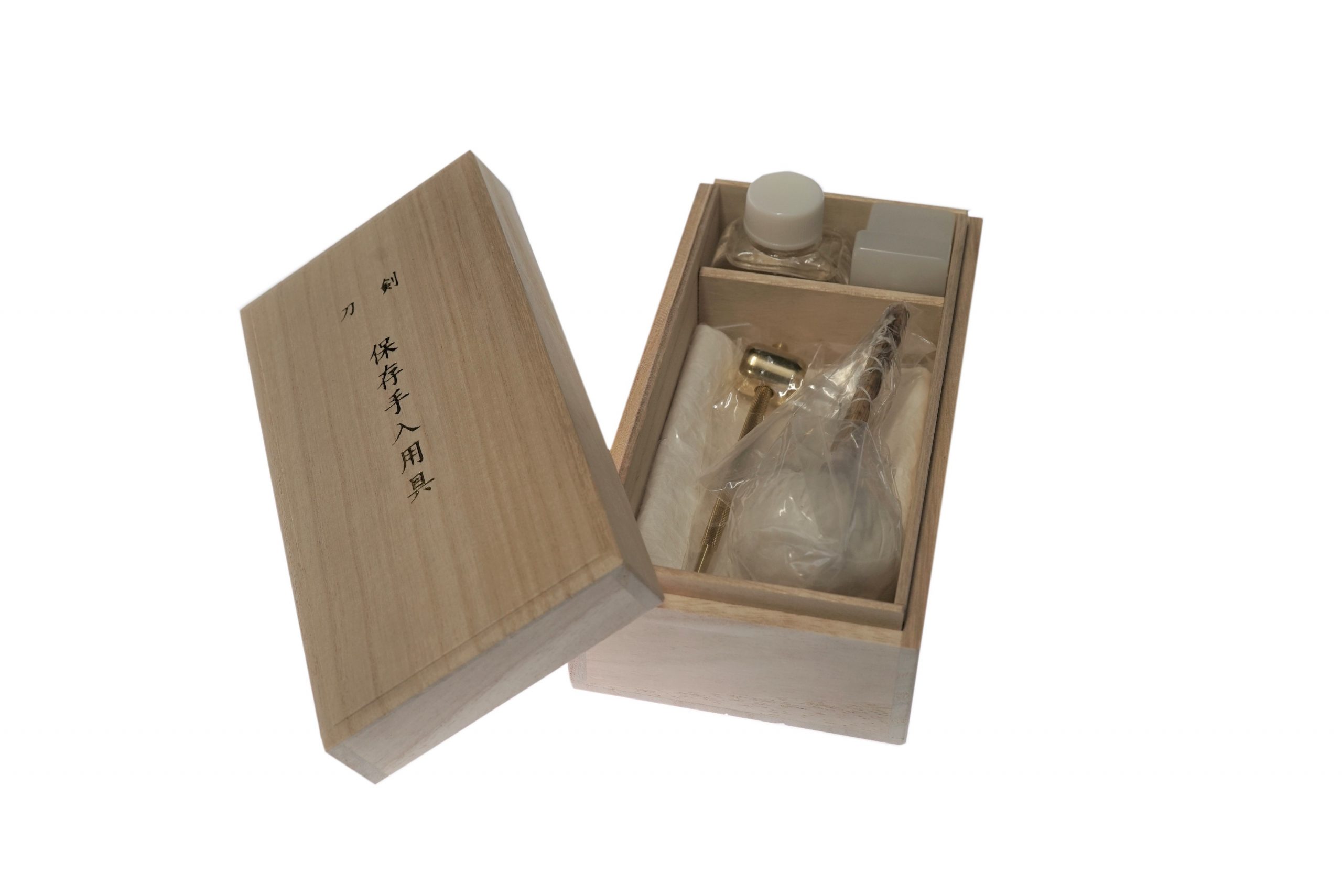
MORE ANTIQUE JAPANESE SWORD FOR SALE
SWORDS WITHOUT CERTIFICATES FOR SALE
LEARN JAPANESE SWORD TERMINOLOGY
Thank you for reading all the information on the page. If you have any difficulty choosing the right Japanese sword for you, we will be more than happy to help you find the one that speaks to you the most. Please feel free to contact us.
